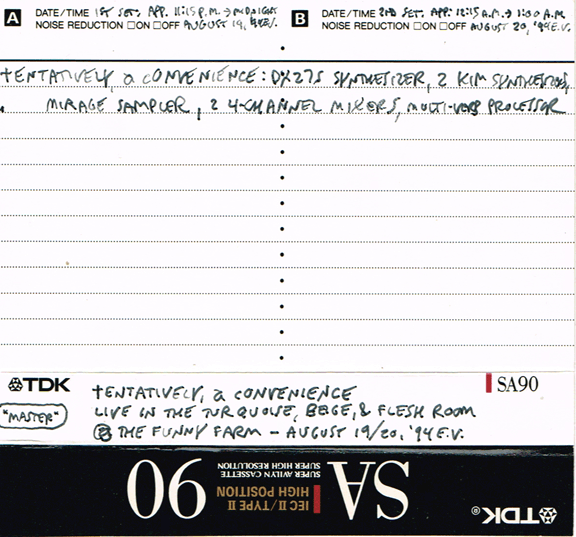
Triple-S Variety Shows
I was born in Baltimore City on September 4, 1953. My family moved to Baltimore County around 1956. I moved back into the city again in 1975. I moved there 'to stay' in 1976. In 1994 I moved away to Berlin, Germany, for 3 months. While I was there I met an artist who invited me to live in a house that she owned called the "Funny Farm" in rural Ontario, Canada. I moved back to BalTimOre briefly to take care of business & to then move to Canada.
It's hard to date my involvement with electronic music. I remember improvising on piano & recording it on a Grundig reel-to-reel tape recorder that took 3" reels. I remember accidentally discovering backwards playback of those reels. That was an important moment in my birth as an electro-acoustic (d) composer. I was probably somewhere between 13 & 16, between 1966 & 1970.
What was the 1st electronic music I heard? That's hard to say. I got the Rolling Stones's "Their Satanic Majesties Request" record in 1967. That had serious studio manipulation. The Jimi Hendrix Experience & the Soft Machine had effects. Jefferson Airplane's "Crown of Creation" & Pink Floyd's "Ummagumma" had some electro-acoustic touchs. I remember giving a report on The Mothers of Invention's "Flower Punk" & the electroacoustic part that followed it as an expression of my interest in electronic music when I was 16 in 1970 so I was obviously aware of it then.
Perhaps the most important records for me along these lines were an Edgar Varèse record purchased in 1972, John Cage & David Tudor's "Variations IV" (purchased in 1973), John Lennon & Yoko Ono's "Unfinished Music #1: Two Virgins" (purchased in 1973), Iannis Xenakis's "Electroacoustic Music" (purchased in 1974), & Karlheinz Stockhausen's "Gesang der Jünglinge / Kontakte" (purchased in 1974).
The above dates are taken from my Record Collection list that I've been keeping since I was a teenager. My memory tells me that I got the Xenakis & the Stockhausen when I was 18, maybe as early as 1971 but I'll trust the list. SO, I started learning about electronic & electroacoustic music between ages 13 & 20, 1967-1974.
I built a function generator from a kit in 1976 whose 6 wave forms made it into a few projects of mine before it was stolen from a car in NYC in 1982. Oh, well. I didn't have the money to buy anything more sophisticated or the motivation to learn more about electronics so that I could build something beyond a kit.
In the meantime, I was experimenting with recording & in 1979 I started experimenting with telephone answering machines. By 1986 I had access to other people's synthesizers & such-like gear so I got to use that somewhat.
Of course, in the meantime I'd been using tape-players, radios, sine/square-wave generators & other such things that I cobbled together. But it wasn't until, possibly, the 3rd Volunteers Collective, on February 17, 1992, that I played my 1st very own SYNTHESIZER in a recording session. The synth in question being a Yamaha DX27S given to me by my friend Dave Guercio. I've had it for 27 years now & it's still in good condition. It's a very well-made instrument.
I quickly acquired other gear that included 2 Kawai K1m wave-table synthesizers, & an Ensoniq Mirage sampler/sequencer. I took the DX27S, the 2 K1ms, the Ensoniq, & 2 cheap 4 channel mixers with me when I moved to Berlin in 1994. I played them in 2 different bands. I barely knew how to use them at this point.
It wasn't until I moved to the Funny Farm in CacaNada in the summer of 1994 that I finally began to study the instruments in earnest. This marked the beginning of the "Triple-S Variety Shows". I'd been working collaboratively with quite a few people in the previous decade but in Canada I was very isolated. The Triple-S project was my attempt to create complex (M)Usic using somewhat primitive gear (the Ensoniq was only 8-bit) that I could perform live solo.
Naturally, I kept developing what I was working on so that, as it turned out, no two Triple-S Variety Shows were ultimately that much alike & they weren't always solo either. The audio recordings that I made under this umbrella, even though they had no overdubs, were still significantly different from the live performances.
What I've ultimately contextualized as Triple-Ss weren't even necessarily thought of as such at the time. In a sense, the Triple-S period was limited to the time that I was (d) composing sequences for it, 1994 to 1997, & the 'purest' representatives were the audio recordings rather than the performances. Nonetheless, all of the sessions listed below, stretching from 1994 to 2009, have something about them that make them qualify - mainly the gear &/or the sounds used.
To partially understand the technical basis of some of the Triple-S Variety Show material, go to the Sequences webpage.
- May 28, 2019 notes from tENTATIVELY, a cONVENIENCE

1994.08.19/20 tENTATIVELY, a cONVENIENCE Live in the Turquoise, Beige, & Flesh Room - Funny Farm, CacaNada
This is a 'pure' Triple-S Variety Show. I played DX27S Synthesizer, 2 K1m Synthesizers, Mirage Sampler/Sequencer, 2 4-channel mixers, Multi-Verb processor & I played solo so all the pieces were my own. The "Turquoise, Beige, & Flesh Room" was an installation in the Funny Farm centered around those colors.
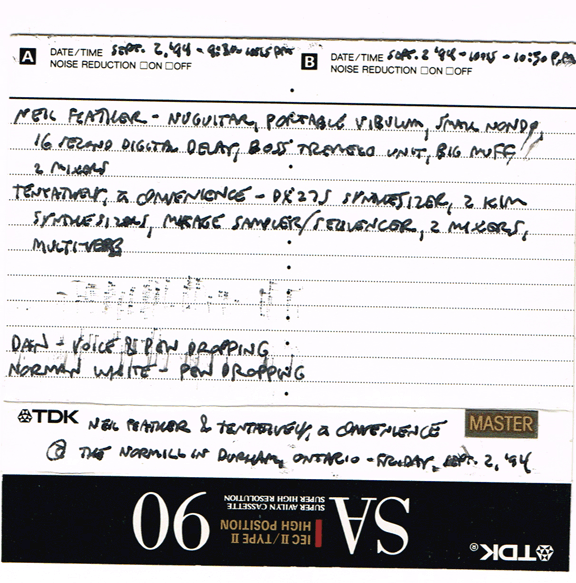
1994.09.02 Neil Feather & tENTATIVELY, a cONVENIENCE @ the Normill - Durham, CacaNada
My main collaborator from 1987 to 1993, the cofounder, with me, of the 'Official' Project (the band whose name changed every time we played) came to visit so I gave my 1st public presentation using the (very underdeveloped) Triple-S materials in tandem with Neil playing his instruments. As such, the emphasis was on our improvisation together but it still falls loosely into the Triple-S category.
194. [duet with Neil Feather
- the Normill, Durham, CacaNada
- September 2, 1994
- A stop on Neil's motorcycle tour. My new, improved playing (DX27S Synthesizer, 2 K1m Synthesizers, Mirage 8 bit Sampler/Sequencer, 2 4-Channel Mixers, Multi-Verb Processor) + Neil's motorcyle portable rig (NuGuitar, Portable Vibulum, Effects) & Small Nondo. The audience seating was partially church pews which had been sawn in half so that the inclined at an angle (since there was no vertical support at one end). Two audience members (Norman White & Dan) provided spirited accompaniment by lifting & dropping the Pews.]
An edited version of the entire event including both Neil's solo set & our duet was shot by Laura O. White & then edited & titled by tENTATIVELY, a cONVENIENCE on December 24, 2016. It can be witnessed on my onesownthoughts YouTube channel here:
- recollections from tENTATIVELY, a cONVENIENCE: Mere Outline 1994
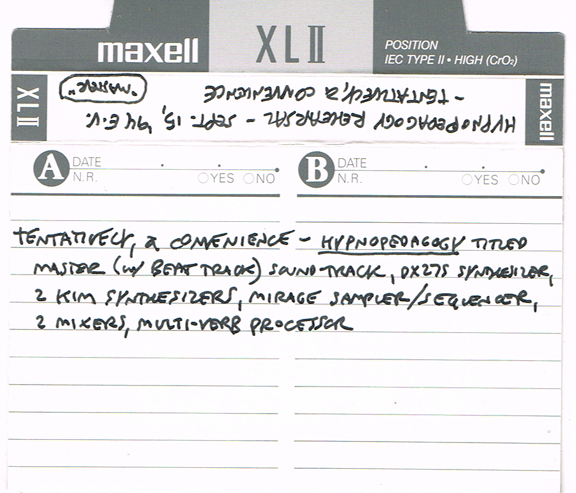
1994.09.15 "Hypnopedagogy" rehearsal - Funny Farm, CacaNada
As soon as I'd gotten started with this project, I typically started experimenting. In this case, I was improvising a sound track for my 16mm film "Hypnopedagogy" using the pre-existing soundtrack + a Triple-S Variety Show addition. The closest thing to a performance along these lines was in Hungary in the Summer of 1997.
147. a. "Bob Cobbing/Movie Trivia/Hypnopedagogy"
- 16mm -> 1/2" VHS cassette (single layer fish-eye transfer w/ white spandex screen)
- 28:30 or 57:00
- '91-'93
- on my onesownthoughts YouTube channel here: https://youtu.be/OsqqA7MwdL4
b. "Bob Cobbing/Movie Trivia/Hypnopedagogy"
- 16mm (double layer optical print)
- 29:45 or 59:30
- '91-'94
- actually 58:26 in the following:
- on my onesownthoughts YouTube channel here: https://youtu.be/bRxG1rc50bM
- on the Internet Archive here: https://archive.org/details/BobCobbing
- tENTATIVELY, a cONVENIENCE Movieography
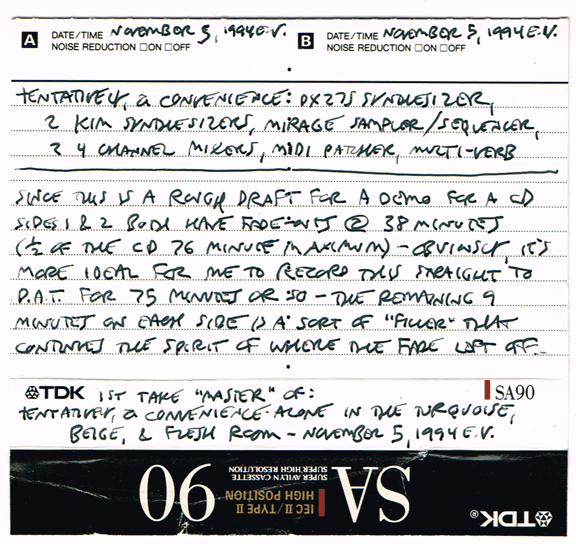
1994.11.05 tENTATIVELY, a cONVENIENCE Live in the Turquoise, Beige, & Flesh Room - Funny Farm, CacaNada
I had gone to BalTimOre to work &, apparently, picked up a very useful MIDI-Patcher to add to the gear. Unusually, this has some detailed notes accompanying the tape. These notes say that this is a "rough draft for a demo for a CD". I remember giving a copy of a Triple-S Variety Show tape to Jason Willet to listen to to consider publishing on his Megaphone label. I think he didn't like it because it was one take to two tracks (i.e. stereo) instead of the 8 tracks that he usually used. I was, of course, making something that could be played live.
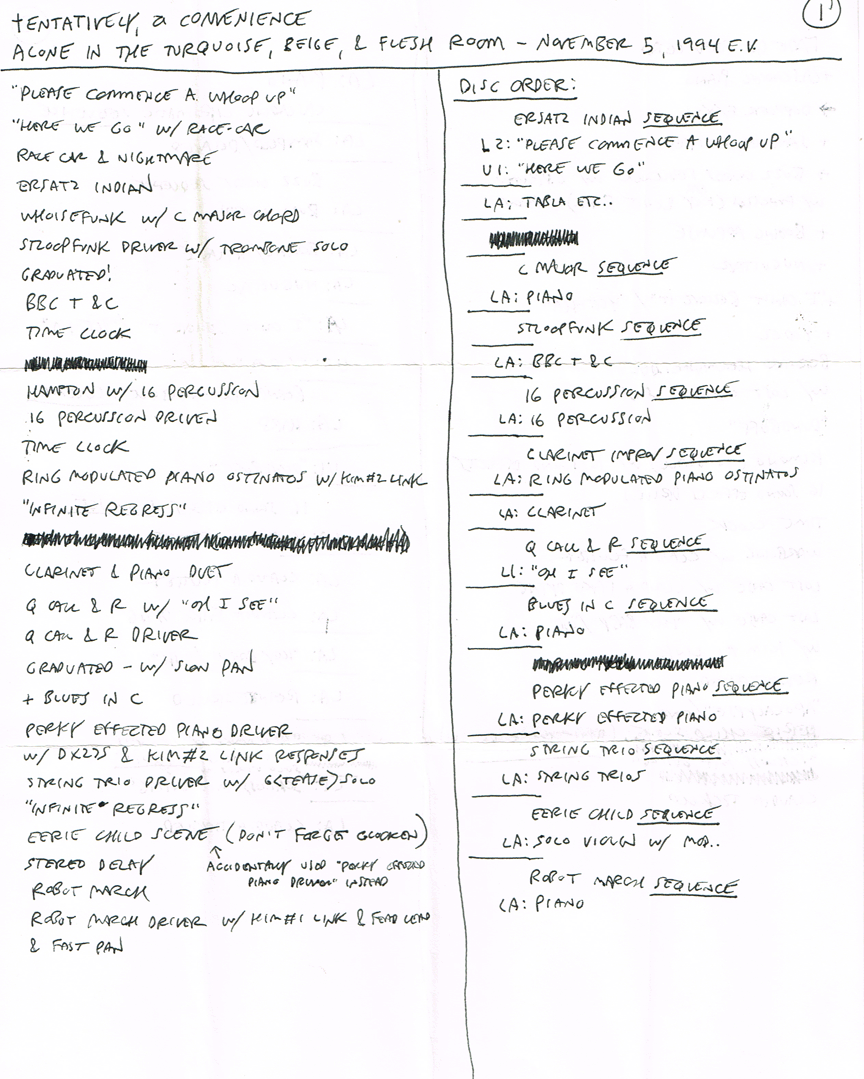
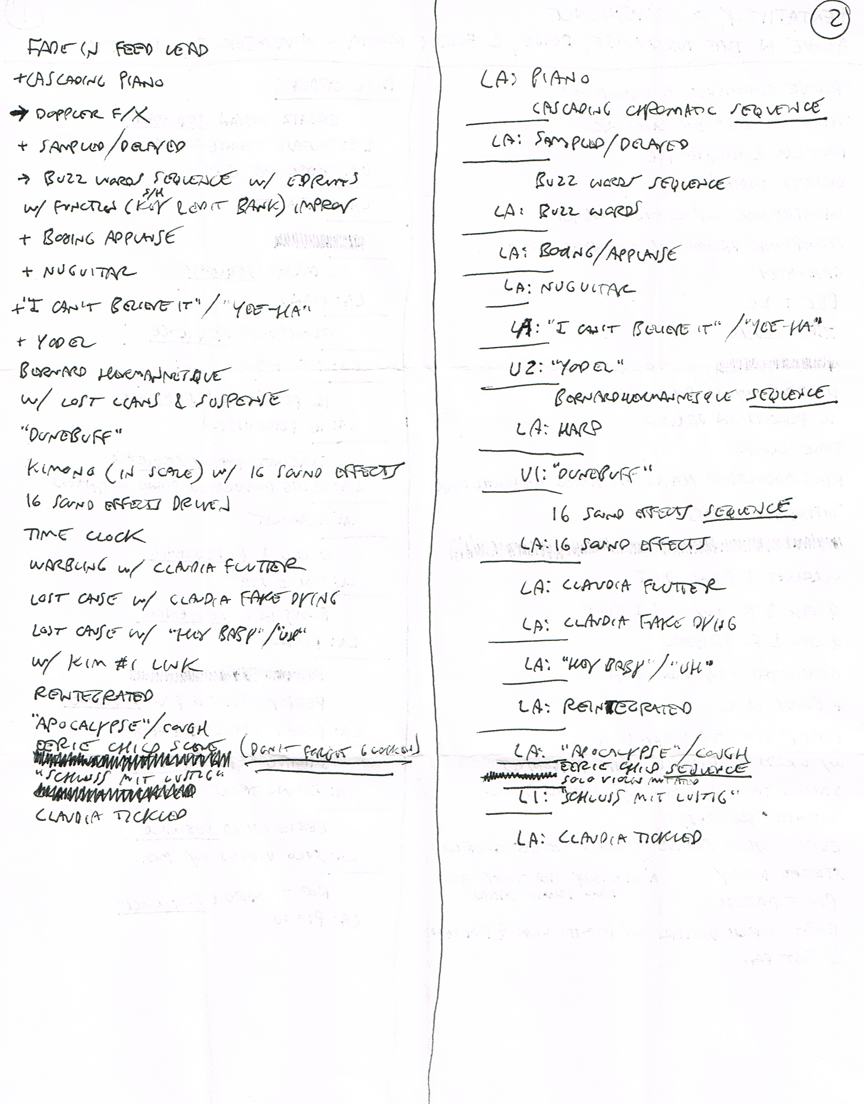
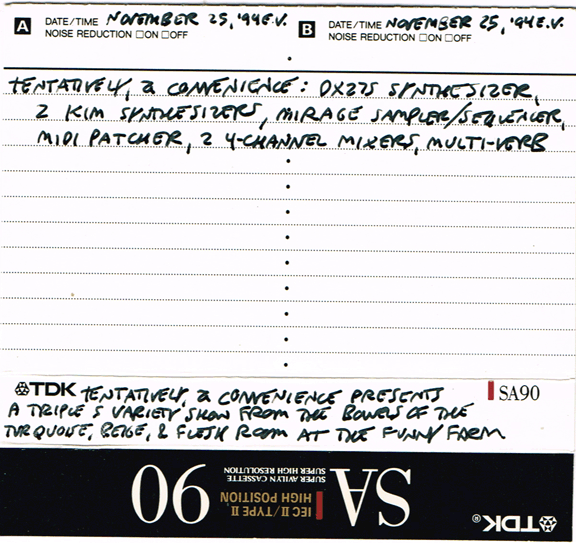
1994.11.25 tENTATIVELY, a cONVENIENCE presents a Triple-S Variety Show from the bowels of the Turquoise, Beige, & Flesh Room at the Funny Farm - CacaNada
Given the title of the tape of this, this might've been the 1st time I used "Triple-S Variety Show" to describe this work-in-progress.
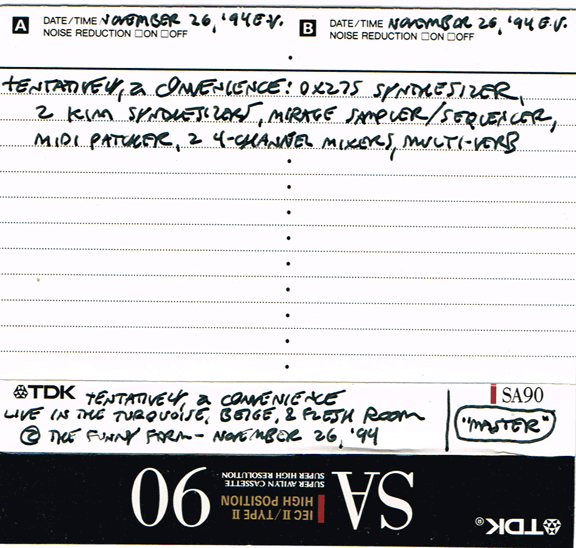
1994.11.26 tENTATIVELY, a cONVENIENCE Live in the Turquoise, Beige, & Flesh Room @ the Funny Farm - CacaNada
The longer gaps between recording sessions must've been partially because I was away for at least 3 weeks, partially because I was creating the raw materials, & partially because I'd been living with someone who was making my life hell. She must've been gone by now - making it so I could record 2 days in a row.
1994.12.03 Broken Mood Elevator Uzak - Monastery illegal after-hours club, Toronto, CacaNada
This was my 1st solo outing with this material & it wasn't well received. The person who supplied the PA made a point of telling me that "people don't like the tunes". One girl came up to me while I was playing & asked for some Rage Against the Machine. I played the "Robot March" in double-time & asked if she liked that. She didn't. I remember one woman who introduced herself as a computer music composer sitting & listening for a long time. I wish I'd talked to her more. Alas, there's no recording of this, video or audio.
195. Broken Mood Elevator Uzak
- 50 Wabash Ave (formerly known as the "Monastery" - see #s 168 & 169), Toronto, CacaNada
- Saturday, December 3, 1994, 11:30PM to Sunday, December 4, 1994, 4:30AM
- Sitting in an unobtrusive place on the 2nd floor of this 2 story building, I played 3 Synthesizers, 1 Sampler/Sequencer, an Effects Unit, & a CD player. I also presented vaudeo simultaneously - with the sound-tracks occasionally added to the mix. The visuals were fed to one tv on each floor & the sound was fed to stereo PA speakers on each floor. The vaudeos/videos used were the same as those described in entry #160 + "F.R.E.D. S. L.I.S.B.E.R.G.E.R." (a 2 hour long macro shot tour through my Baltimore warehouse) & a compilation vaudeo of some of my more complex & recent movies. In the beginning, I played CDs by Martin Denny & Esquival - subtly mutating them with my effects unit & gradually eclipsing them more & more with my own material. The only vaudeo device that I was using was a crude switcher that enabled me to change back & forth between the outputs from 2 VCRs. This switching was often done in sync with the rhythms in order to make the content of the visuals seem more coordinated with the sound than it would have seemed otherwise. Given that the space is primarily known for its "speak-easy" (or "speak") dance & lounge music "after-hours" parties, people's expectations were predictably geared in those directions. As such, I had people drearily asking me for "dance music". Arguments broke out between people over what I was playing. Despite the fact that one girl was standing there & watching me play the keyboard, she asked me whether what I was playing was "Kraftwerk" & seemed unable to comprehend that I wasn't a DJ - even after I explained that I was playing my own original material "live" in front of her. Considering that this was my most complex solo UNCERT presented yet, the almost complete lack of audience comprehension/appreciation was, once again, discouraging. My thanks to those who were supportive.
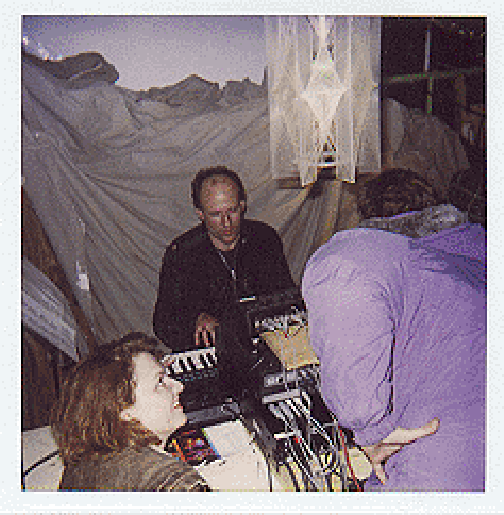
Mila on left & John Henry Nyenhuis on right talking with tENT while he played
- recollections from tENTATIVELY, a cONVENIENCE: Mere Outline 1994
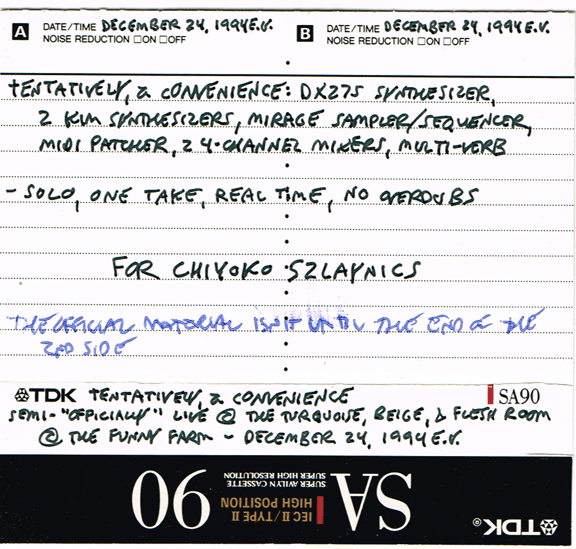
1994.12.24 tENTATIVELY, a cONVENIENCE Semi-"Officially" Live @ the Turquoise, Beige, & Flesh Room @ the Funny Farm - CacaNada - for Chiyoko Szlaynics
This was Semi-"Official" because I'd been working on the "Official" sequences that would allow me to perform material from the 'Official' Project by myself that had been intended for at least 5 people. These were incorporated into a recording for the 1st time here.
Chiyoko Szlaynics had phoned the Funny Farm asking for someone who wasn't living there at the time. She wanted to ask him to contribute dance music to a project she was working on. We got to talking about my own work & she invited me to participate as well. Her idea was to organize dance around public sculpture. I sent the following proposal letter with a copy of this tape. As you can see, I made a proposal that wasn't likely to be received enthusiastically in an art world context. I reckon Chiyoko might've thought I was insane. Naturally, I thought I was pretty damned funny. Keep in mind that Chiyoko had never met me or heard of me before out phone conversation. Here's a key paragraph:
"Ideally, what I'd like to propose for your series is this: I'd like to perform the "saw dance" nude w/ a nude female dancer in a large public toilet facility. The public sculpture of your proposal wd be the urinals (in a "men's" room) &/or the toilets (in a women's room). These wd all be signed "R. Mutt" in honor of Duchamp's fountain. You get the idea. I deally the "soundtrack" wd be a tape (perhaps similar to the oneenclosed that I made yesterday for you) being broadcast to radios wch wd be attached to remote-controlled toy vehicles being driven around the room & thru the audience by a bevy of discrete assistants."
That still strikes me as a nifty idea 24.5 years later! Alas, my proposal wasn't accepted. I have a vague memory of being told by Chiyoko that the project never was realized. Was she fibbing?
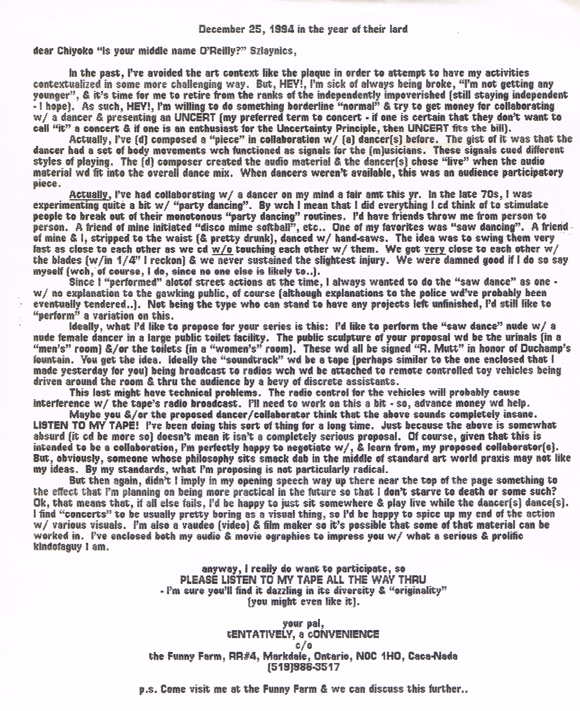
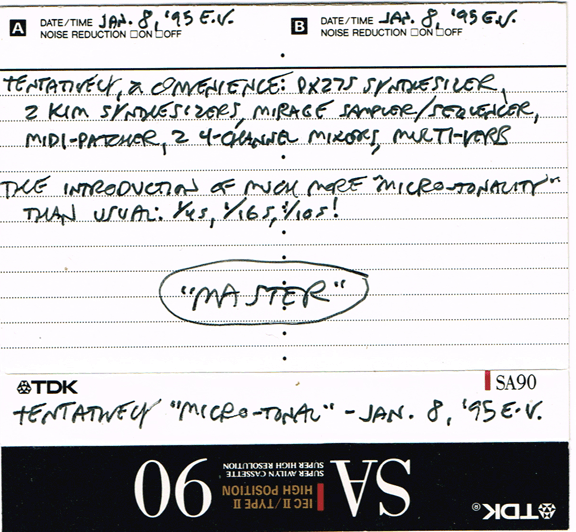
1995.01.08 tENTATIVELY "Micro-Tonal" - Funny Farm, CacaNada
I'd created some new microntonal voices so this was the 1st Triple-S Variety Show to incorporate them. I eventually put this online on the Internet Archive.
184. "Microtonal (M)Usic from tENTATIVELY, a cONVENIENCE"
- credited to: tENTATIVELY, a cONVENIENCE
- uploaded to the Internet Archive on March 7, 2015: https://archive.org/details/A1994.12Seq42Fixed16s_201503
The notes for the Internet Archive presentation of this & other material are as follows:
Microtonal (M)Usic from tENTATIVELY, a cONVENIENCE
Last weekend, I attended the excellent "Beyond: Microtonal Music Festival" at the Andy Warhol Museum & the University of Pittsburgh. There were 2 symposia & 3 concerts. It was the 1st festival I'd ever attended dedicated exclusively to microtonal music. I was very stimulated. As a response to this, I decided to post my microtonal music to the Internet Archive. All of this work of mine is almost completely unknown & on the occasions when it was performed for an audience the microtonal aspects weren't emphasized.
I probably 1st became conscious of microtonal music when I acquired a copy of the Columbia Masterworks "Music of Our Time" record entitled "The World of Harry Partch" in 1973. I was 19 or 20 years old. I had possibly already conceived of my own instrument by then & done a line drawing of someone resembling me playing it - but I hadn't built it. Not only had Partch built his instruments, they were beautifully conceived & created AND they were tuned microtonally AND in Just Intonation - which I'd probably never heard of OR heard before. Making matters even more intense for me was that Partch had been a hitch-hiker & drifter, as I had been, &, as I later learned, had even composed music about it ("Barstow" & "Bitter Music" being the 2 examples that spring to mind).
By early 1974 I'd picked up another great Columbia Masterworks Partch: this time the multi-record box-set of "Delusion of the Fury" that featured a booklet & an additional record that demonstrated & explained the instruments. It might've been in 1975 that I learned that a performance of "Delusion of the Fury" was scheduled to occur in NYC but I was too 'old' now to be picked up hitch-hiking as easily as I had previously & too poor to get to NYC otherwise. I missed my chance to witness Partch himself - something I'll forever regret! After discovering Partch, microtonality was on my map & I was looking for other microtonal music recordings - what I subsequently found being beyond the purview of this essay.
My (M)Usic has never really centered around tonality, micro- or otherwise. Yes, I started off taking piano lessons around ages 6 to 10, yes, I started playing rock & folk music as a teenager, yes, I took violin lessons when I was 18, yes, I started improvising when I was 19 - but I don't think I really took off until I started seriously composing when I was 20 & was inspired by things like electro-acoustic music, graphic notation, prose scores, & aleatoric pieces - none of which were centered around tonality.
I was much more interested in the IDEA behind my pieces & in having these ideas be as original as I could make them. I didn't want to advance a tradition, I wanted to make sound pieces that sounded as little like previously existing sound works as I could manage. Of course, that's an oversimplification & I was far from always successful but, still, that's enough of an introduction to my intentions.
During the Beyond Festival I was captivated by how intensely detailed the attention was to tonality in most of the work discussed & performed. It was fantastic! It was also completely different from my own uses of microtonality. It became even clearer to me than it had already been that many of my pieces, especially the larger-scaled ones, are timelines on which events happen (as with all music, I suppose, but the focus on that is more prominent in my own work) & that I create the events to be clearly differentiable from each other in multiple respects. As such, microtonality is just another factor in creating levels of articulation to help keep things audibly separate when simultaneous as well as sequential.
In a sense, this is an analog to my social philosophy. My conception of 'harmony' is not a blending of similar ratios - instead it's a coexistence of dramatically different elements that retain their individuality & 'harmonize' by having equal prominence.
From 1994 to 1997, I worked on a large-scale solo piece called "Triple-S Variety Show". The "Triple-S" referred to the synthesizers, sampler, & sequencer that I was trying to learn more deeply. The synthesizers were 2 Kawai K1m wave-table synthesizers that my friend Sarmad had sold me cheaply & a DX27S algorithm synthesizer that my friend Dave had given me. I'd bought the 'primitive' 8-bit Mirage sampler/sequencer. Additional equipment used were 2 to 4 Radio Shack 4-channel mixers, a MIDI-Patcher, & a Multi-Verb effects unit.
Having spent 1990 to 1994 working with my "Official" Project that had 2 to 17 members & that revolved around a complex aleatoric system of what cofounder Neil Feather & I called "C.A.M.U.s" (Cue Activated Modular Units) I wanted to explore a similar modularity that could be performed by myself alone.
With the K1m I could build sounds 'from scratch' with 32 simultaneous wave forms that when combined created what I called "mini-sequences". The Mirage sampler was limited to something like a range divided into 2 halves with each half having 3 seconds or less for samples within it. The Mirage sequencer had a 333 note limit that would malfunction if I were to do things like pitch-bend the 333rd note, etc, etc.. The equipment was much more limited than what I use now but it was great for my purposes & I was glad to explore the limits. I could program the DX27S but I didn't really like the highly technical nature of its structure & didn't find the sounds I created very satisfactory. I could also program the Multi-Verb to have a sequence of effects that I could cycle through by pressing a foot-pedal.
My (d) compositional process centered around my making a sound 1st. If I used the wave-table synths I tried to exploit specific technical characteristics. Then I'd create a Mirage sequence that would feature whatever was special about the new sound(s). As I got more sophisticated, I explored ways of tweaking the Mirage's limitations to produce results not necessarily intended to be available by the manufacturer - what has since come to be known, if I understand correctly, as Black MIDI.
In addition to the sequences, I made sounds that served as transitions & other sounds that were meant to be played soloistically. Since the sequences & samples were saved on 3.5" floppy discs that had to be loaded into the Mirage & since that loading process was somewhat slow, I was thinking in terms of moving from one sequence to another with intermediary activity that wasn't sequence-based. During the last week of 1994 & the 1st 5 weeks of 1995, I created at least 5 microtonal wave-table sounds: "16 1/4s", "Rising /4s", "32", "Fixed 16s", & "5 X 10".
By no later than the fall of 1997, I had created 123 sequences & written a 39 page explanatory essay in which I tried to explicate how & why each of the sequences had been made. The introduction to that essay begins as follows:
"This document is being assembled because I realize that I'm likely to forget what many of the special design features & intentions were behind these sequences as I get further away in time from their creation & as I play them less. In fact, I've probably already forgotten many of them. Contemporaneously with the writing of this text, I'm tape-recording the playing of these sequences - 1st in "pure" form &, 2nd, as an example of how they were intended to be played "in performance". In some cases, more or less than 2 playings may be called for to be representative. Most of these sequences are meant to be looped - wch is not how they'll be presented in the recordings.
"For note identification purposes, C1 is the lowest C on my DX27S keyboard. Therefore, C3 = middle C," [That's using Yamaha's numbering system - which is no longer the system I use. Instead I now refer to middle C as "C4" - but when I quote from this 1997 document I'll stick to the system I was using then] "the C 1 octave below C1 is C0, the C 2 octaves below C1 is C-1, etc.. From C to B is an octave - therefore the B to the left of C is in a lower octave: ie: C1 is adjacent to B0.
"Comparisons of instrument tuning differences reflect the state of tunings as of July 20, '96 & may change through Master Tune adjustments etc in the future. These possible changes may be made as an outgrowth of studies such as those explained in the 1st entry below." [Not reproduced here]
Of the 5 microtonal voices listed above, I made sequences for 3 of them:
Sequence 042. "Fixed 16s "Microtonal" 'Ritual'" (1994 or 1995) (selection A here on the Internet Archive)
Sequence 043. "5 X 10th Tones" (1994 or 1995) (selection B here on the Internet Archive)
& Sequence 076. "Rising Quarter-Tones Driver" (1996) (selection E here on the Internet Archive)
In my "Sequences" essay I explain the above as follows:
"{42.} 2. Fixed 16s "Microtonal" Ritual" - :47 @ 48
""FIXED 16s" is another K1m sound that I programmed. It's divided into overlapping parts. Each part has a "purist" section in wch a single tone exists & an "overlap" section in wch it's combined w/ its neighbor. Each of the "purist" sounds is triggered by 4 keys on my 5 "octave" keyboard (w/ the exception of the highest wch is triggered by 7 keys) & each of the overlaps is triggered by 3 or 4 keys (w/ the exception of the "high-hat"). Each of the "purist" sections consists of only 1 fixed pitch - w/ each adjacent pitch being 1 16th tone apart. As such, the entire keyboard activated range is only 1 "semi-tone". Each part has a different tone simulating an acoustic instrument:
"C1-D#1: Gong
E1-G1: Gong + Japanese String
G#1-B1: Japanese String
C2-D2: Japanese String + Organ
D#2-F#2: Organ
G2-A#2: Organ + Snare Drum
B2-D3: Snare Drum
D#3-F3: Snare Drum + Brass
F#3: High-Hat + Brass
G3-A#3: Brass
B3-D4: Brass + ContraBass
D#4-F#4: ContraBass
G4-A4: ContraBass + Percussive 1
A#4-C#5: Percussive 1
D5-F5: Percussive [1] + Percussive 2
F#5-C6: Percussive 2
"1 of the interesting things about this K1m multi-sound is that fast fingering yields something closer to a roll/tremolo than to a multi-pitch sequence. Of course, this is typical of many split KB percussion sound groups but 1 of the things fairly unique about this is the overlap sections. If I were to play, eg, E5 + D5 + C5 + B4 + A4 in quick succession it wd sound like an astonishingly tight trio in wch Percussion 2 & 1 played the 1st 2 notes of a short roll in unison w/ Percussion 1 continuing w/ the next 2 notes solo & ContraBass coming in in unison on the last note. Glissandi, of course, are an extension of this.
"I've called this sequence a "ritual" because its narrow pitch range & halting & stilted pace rhythms seem like the correlative to the formalized movements of a processional to me. Only the ContraBass sound is manipulated w/ pitch shifting to push it out of the "semi-tone" range." - p 8
"{43.} 3. 5 X 10th Tones - :59 @ 48
"I programmed this K1m sound so that it wd consist of 1 "octave" of 10th tones - ie: a 60 tones per "octave" division. However, due to the K1m's technical limitations, this was accomplished by having each group of 12 notes (ie: each "octave" of the conventional keyboard configuration) be the conventional tempered tuning semi-tone" apart w/ each group being only a 10th tone apart. As such, to play the notes in ascending sequence, the player wd have to play: C1, C2, C3, C4, C5, C#1, C#2, C#3, C#4, C#5, D1, D2, etc.. - ending on C6. This sequence simply takes advantage of multi-tracking to overcome the difficulties of the above." - p 9
"{76.} 3. Rising Quarter-Tones Driver - 8:39 @ 48
"The K1m "Rising /4s" voice that this was created for was made over a yr & a half earlier than when I felt inspired to create a sequence for it. The sequence was created largely to explore the potentials of the sound that I had almost forgotten.
"Similar to the "Fixed 16s" voice, the sound is divided up into 8 overlapping groups - i.e.: the lowest 4 notes are "pure", the next 4 an overlap between the 1st sound & the 2nd sound, the next 4 notes are a "pure" version of the 2nd sound, etc.. Unlike the "Fixed 16s", these sounds are fixed to 1 pitch no matter wch of their activating keys are touched. Furthermore, each sound is a mini-sequence of 4 ascending quarter-tones - w/ each group being made up of different sounds from the others. the lowest 27 notes are all to the left, the next 4 notes are a mix of right & left, & the next 30 notes are all to the right. These various K1m voices are designed to produce stereo results in different ways so that even if I don't remember the specifics of their configurations while I'm playing them there'll still be alotof variety.
"This sequence is a fairly long droning experience w/ subtle stereo tone colour events happening along the way @ structurally somewhat unpredictable intervals. This is both undramatic & non-beat based.
"In the 2nd recorded version," [the one presented here] "the non-dramatic subtlety is used as a vehicle for various Multi-Verb treatments w/ some occasional other "events" popping up now & then. This is the main sequence so far in wch the use of multiple effects is central to what's interesting about the final product. It becomes as if the drone is an object moving thru various types of spaces - different sized rooms, echo-chambers, tunnels, "outer-space", etc.." - p 16
While these sequences can be presented as pieces on their own, they're really meant to be part of a bigger, more complex, whole that's an entire "Triple-S Variety Show". The 1st of these Triple-Ss (not always called such) was recorded on August 19/20, 2014. The 8th of them was recorded on January 8, 2015 & was labeled "tENTATIVELY "Microtonal"" (selection C here on the Internet Archive). This would've been recorded after the 1st 2 of the microtonal sequences described above were (d) composed & would've been the 1st Triple-S to incorporate them & the other microtonal sounds. This is broken into 2 parts here to represent the 2 tape sides of the original cassette recording.
One of my favorite pieces at the "Beyond" Festival was a keyboard duet of a piece called "Rad" (2003) by composer Enno Poppe as performed by the Ray-Kallay Duo. If I understand correctly, each keyboard had a laptop connected to it that sent out a MIDI signal to switch the voicings - w/ each voice being tuned differently. The keyboardists were playing from scores & had to adapt to these very quick tuning changes. It was amazing & I gave it a standing ovation.
I was reminded of my own "Bogus Piano Concerto" (summer 1995) which was recorded 6 times - twice in its early phases solo by myself, 3 times in collaboration withe the very talented John Henry Nyenhuis in rehearsal, &, finally, at the Music Gallery in Toronto with John Henry & myself on September 8, 1995 (selection D here on the Internet Archive). The reason why "Rad' reminded me of my "Bogus Piano Concerto" is because in the BPC I sat across from John Henry while he played the DX27S controller & I manipulated the other electronics to determine what sounds he would trigger. There was a rough outline as to when I'd make changes & what type of changes they would be but John Henry didn't know exactly when & what I'd do to change what happened while he played. This meant that, as with "Rad", the tunings changed as he played.
Not only did the BPC incorporate what's now called "Black MIDI" in the way that at least one of the sequences deliberately overdrove the limited sequencer, it also involved things like changing the tuning so that only one note played no matter which notes & what quantity of notes JH was playing. I was trying to surprise the attentive audience. This recording was made by Paul Hodges at the Music Gallery & is divided into its 2 movements: 1. "Left Wing Movement", 2. "Chicken Wing Movement". More detailed information can be gotten about this piece by looking at the notes for my "Piano Illiterature - Volume I" on the Internet Archive - where rehearsal 5 is presented.
After the "Rising Quarter-Tones Driver" was created, the 1st Triple-S to incorporate it was the the 21st Triple-S, recorded on July 18, 1996. I just present the 2nd half of the 2nd side of that recording here to present the part in which the sequence appears (selection F here on the Internet Archive). A recording of the full 90 minute session is published by my WIdémoUth Tapes as "Triple-S Variety 'Show' - Volume 2".
Another piece that I liked very much in the "Beyond" Festival was "1950-C" for restrung classical guitar by composer Paul Clift as performed by guitarist Daniel Lippel (if not by the other half of the guitar duo, Mak Grgic). If I understand correctly, for this piece the guitar was restrung so that the 2 lowest strings were paired, the 2 middle strings were paired, & the 2 highest strings were paired - possibly to make quarter-tone tuning or another microtuning easier.
This piece, too, reminded me of an experiment of mine from a May 6, 1997, session. I was part of a loose-knot collective of improvisors called the "Volunteers Collective". This 'group' has gone through many incarnations & started in 1989. One of the incarnations is a recurring group of sessions at the "Red Room" which is the performance space connected to "Normal's Books", a bookstore I cofounded in BalTimOre. These sessions were (/are still?) called "Crap Shoots at the Red Room".
For this session, I borrowed a guitar from John Berndt & retuned it in quarter-tones probably in this way:
the low E was retuned to F#
the A was retuned to F##
the D was retuned to E
the G was retuned to between E & F
the B was retuned to C#
the high E was retuned to C##
I then improvised on this - probably placing emphasis on moving from one note to a quarter-tone higher or lower by fretting across the pairs created by the above tuning & playing from one to the other.
This Crap Shoot started off with a group free improvisation & then moved to a series of duets (each about one minute long), etc.. The brief excerpt presented here is of a duet I played with contrabassist John Hughes. I find that the quarter-tone playing is barely audible as such but this was still the most comprehensible selection I could find in the overall session recording.
- March 5, 2015E.V. notes from tENTATIVELY, a cONVENIENCE
1995.01.12 A Triple "S" Variety Show straight from the bowels of the Turquoise, Beige, & Flesh Room at the Funny Farm - the Silver Eye, Pittsburgh, us@
This was the 1st presentation I ever gave in Pittsburgh. It involved simulataneous mixing of prepared "Concrete Mixing" vaudeos using a fairly nice video mixer provided by Pittsburgh Filmmakers via Orgone Cinema + live playing of the Teiple-S material using my usual gear of DX27S + 2 K1ms + Sampler/Sequencer, etc.. At the time, I was disatisfied with it because I felt like my trying to handle both the projection & the audio was overly ambitious & that I neglected both of them somewhat. Checking it out again, 24 years later, I realize that I did an incredibly good job & that quite probably no-one else was doing this in such an innovative way or in such detail as I was at the time (& possibly before or since).
590. "Triple-S Variety Show @ Orgone Cinema"
- this movie was actually made as a performance document of the 1st thing I presented in Pittsburgh on January 12, 1995. I (tENTATIVELY, a cONVENIENCE) played a "Triple-S Variety Show" (live electronics using a DX27S synthesizer, 2 K2m wave-table synthesizers, & a Mirage sampler/sequencer) at the same time that I mixed VHS tapes that I'd prepared or selected for this purpose. This latter was projected. On May 29, 2019, I added a scan of the poster for the event to the front + a minimal title & repeated the title info at the end. This is concluded by the icon for my aRCHIVE.
- 1:56:42
- on my onesownthoughts YouTube channel UNLISTED here: https://youtu.be/mhhOcHKOKFw
The notes that I made about the resultant documenting VHS tape afterward are as follows:
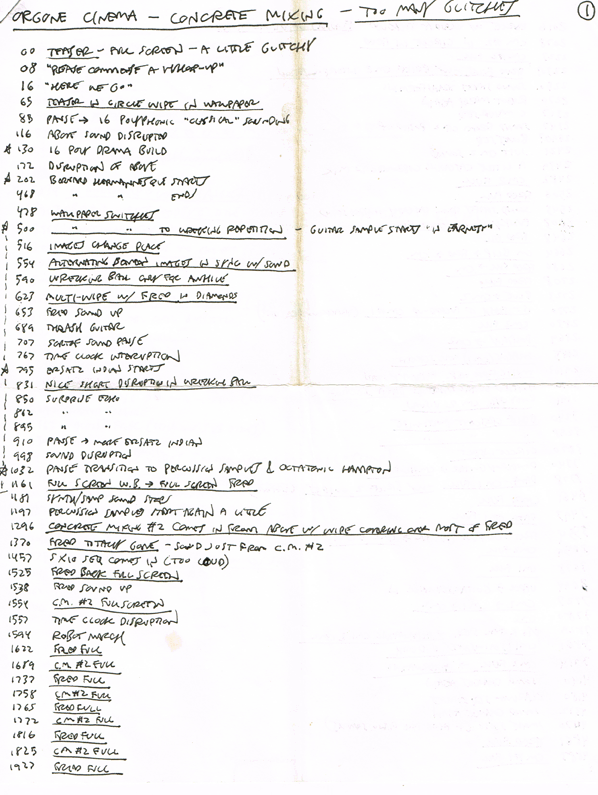
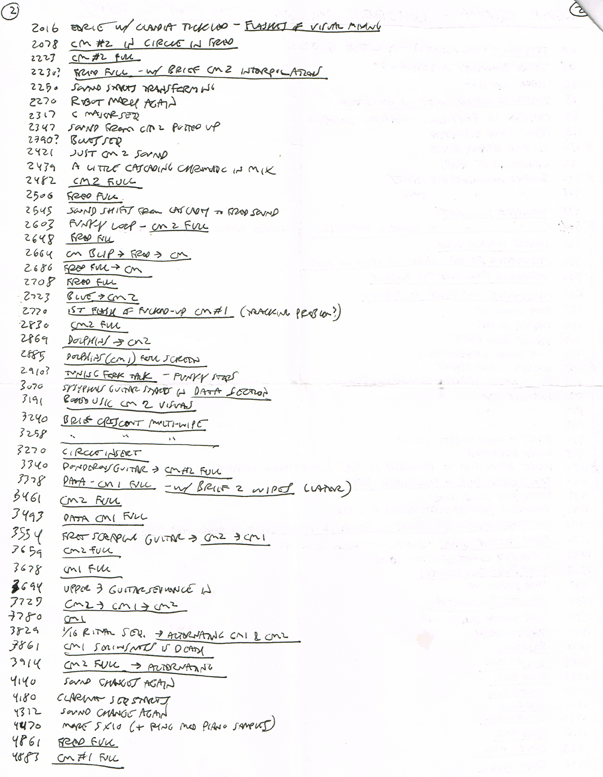
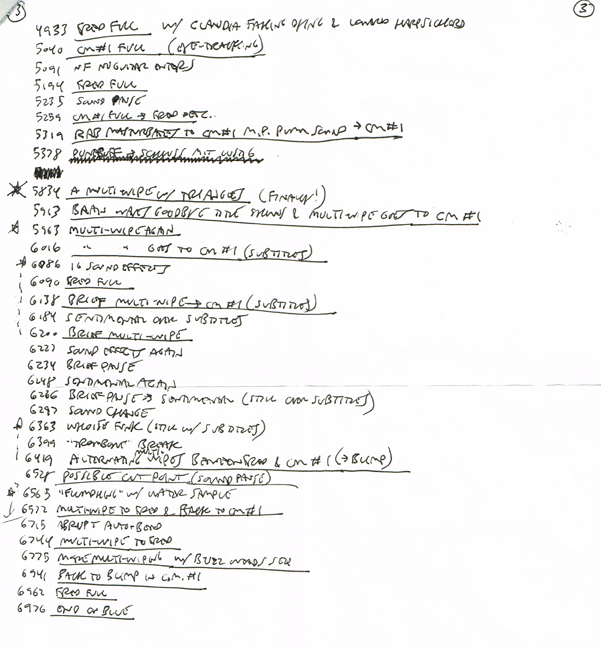
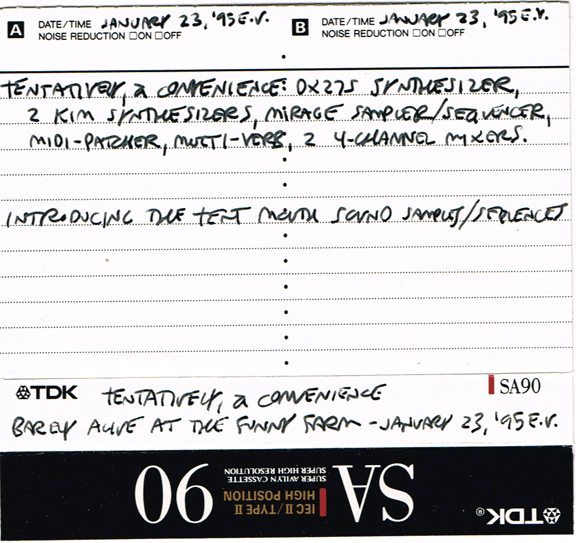
1995.01.23 tENTATIVELY, a cONVENIENCE Barely Alive at the Funny Farm - CacaNada
I wasn't really exaggerating the "barely alive" part. My former business partners, as far as I could tell, were being very lackadaisical about paying me for my part of what was once a shared business. I don't think they ever paid me more than about 1/5th of what they owed me before they stopped the payments altogether. I was 'surviving' on about $40 a week when I wasn't going back to BalTimOre to work for better money. It was winter in CacaNada. Fortunately, I had a few cords of cheap firewood. I was eating a fair amount of potatoes & onions. I got, maybe, one bottle of red wine a month. Nonetheless, I was fanatically working on the electronic (m)usic.
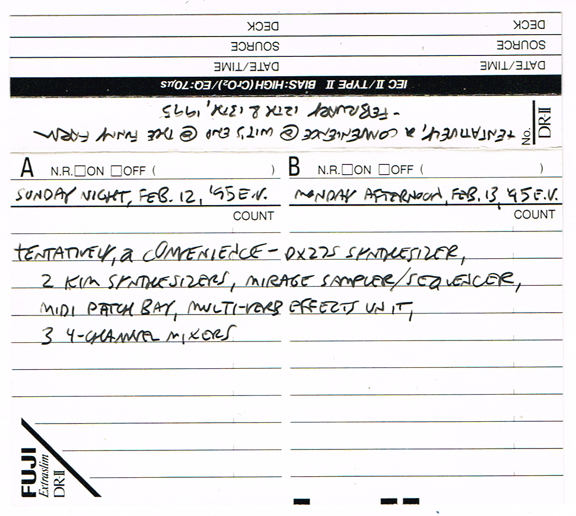
1995.01.12/13 tENTATIVELY, a cONVENIENCE @ Wit's End @ the Funny Farm - CacaNada
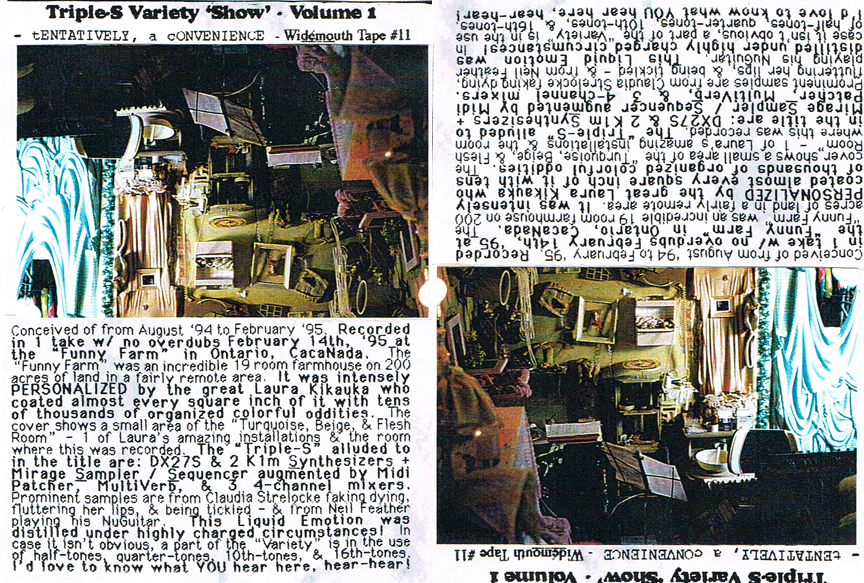
1995.02.14 Triple-S Variety 'Show' - Funny Farm, CacaNada
Thois was recorded on Valentine's Day in 1995. I originally called it something like "Jerking Off on Valentine's Day" & I remember giving a copy to a lesbian friend who seemed moderately alarmed that it might be a recording of just that. Nope, I was mocking myself for allowing my life to deteriorate as far vas it had. It's nice to remember that it might've even been worse than it is now. Anyway, this was the 1st T-S VS that I published on my WIdémoUTH label as tape #11. It's 100 minutes long, making it difficult to copy as a tape in this day & age of tape 'obsolescence'. The picture on the cover is of the "Turquoise, Beige, & Flesh Room" where all the Funny Farm recordings were made. Very few people have ever listened to this tape or to any of the Triple-Ss. Neil Feather compared one of them to Esquival, a comparison I was falttered by since I like Esquival's music. Libby Ramer was quite enthusiastic about whichever one I played for her. I still think that this is a milestone in my (d) composing.
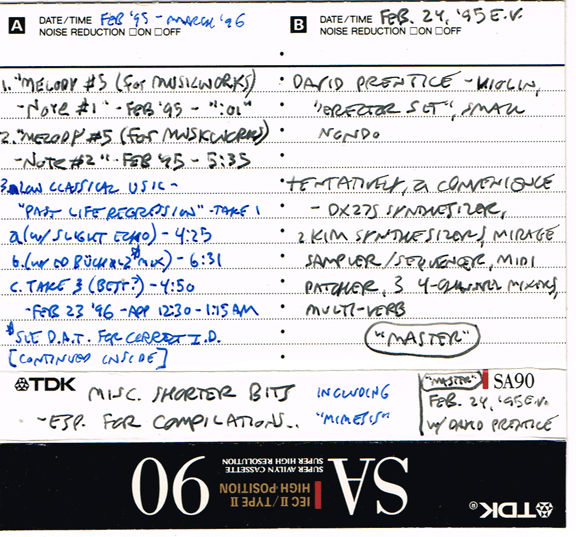


1995.02.24 tENTATIVELY, a cONVENIENCE & David Prentice - Funny Farm, CacaNada
I was living in extreme social isolation in rural CacaNada. I was told that there was a "fiddler" who lived in 'nearby' Flesherton, a very small town, that I might want to meet so that I could play with him. I was sceptical because I figured that he was probably a folk musician. As it turned out, he was the best free improvising violinist I've ever had a chance to play with. He had a 'factory' for building violas & violins in Flesherton - which is how he made his living. David played Violin, "Erector Set" percussion, & Small Nondo. I played my usual Triple-S instruments. Alas, I only got to play with him 3 times while I was at the Funny Farm because he cut his hand badly in the factory & couldn't play for awhile. This was the 1st set we played together. I tended to not think of any playing with other people as a Triple-S, generally they were "Volunteers Collectives". In this case, I just labelled it as a duet. This was also released as one side of a tape on my WIdémoUTH label. The flip side has a duet with Neil Feather. Because this was recorded in the Turquoise, Beige, & Flesh Room & because of the instrumentation, I think it's appropriate to add it to the Triple-S roster.
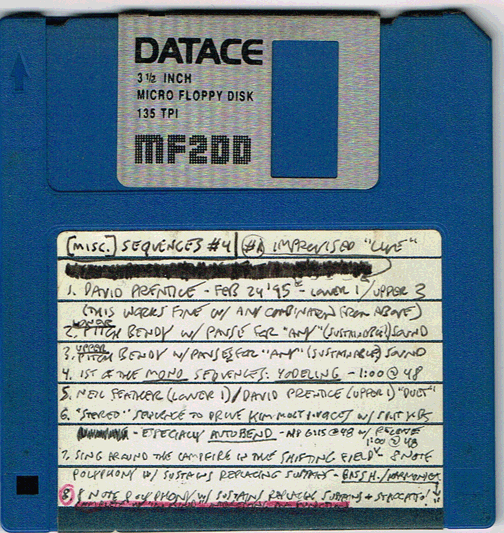
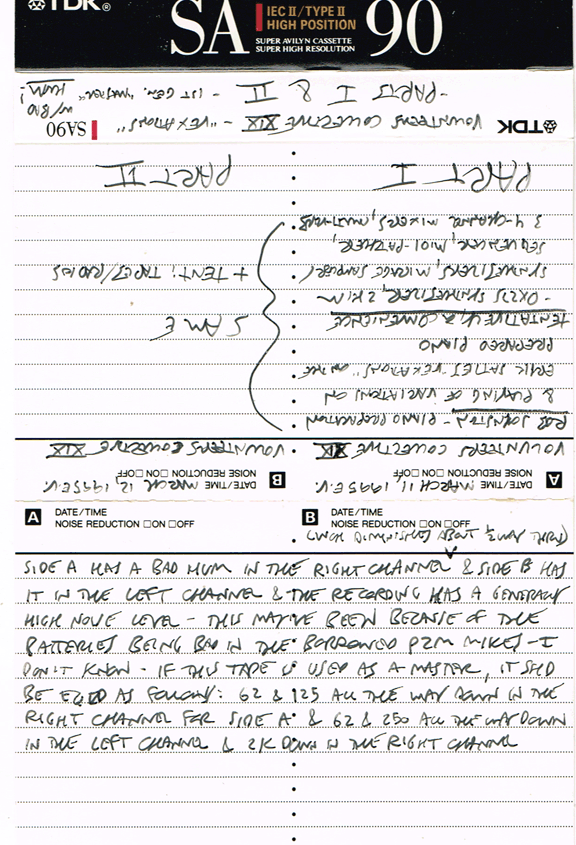
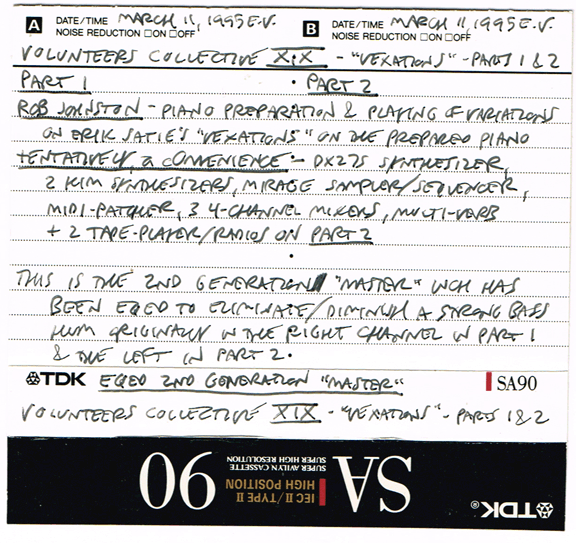
1995.03.11/12 Volunteers Collective XIX - "Vexations" Parts 1 & 2 - Funny Farm, CacaNada
Fortunately for my abysmal state-of-mind, my friend Rob Johnston came from Toronto to stay with me for a little while at the Funny Farm. Rob & I had met through being in the same band in München, Klauhütte Bangzeit 200. He can be seen MCing & I can be seen singing in my movie entitled "Boota". That group performed 3 exotica songs in many variations in 12 hour marathons. This marathon approach had been somewhat influenced by Erik Satie's "Vexations". For this session, we decided to perform a perversion of "Vexations" in the Turquoise, Beige, & Flesh Room at the Funny Farm. The movie from this is one of the only documents of my living at the Funny Farm & probably the ONLY vaudeo document of me playing electronics there. Rob plays Vexations on prepared piano & I play my Triple-S gear. I start off playing kitchen samples that were recorded at the Funny Farm.
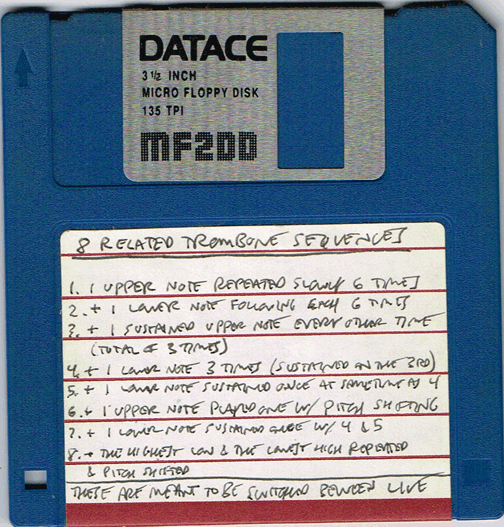
The Trombone Sequences were probably fairly new at that point. By the time of this session, I was reasonably expert at playing my instruments. People interested in older tech might enjoy my frequent floppy disc changes. The movie is broken into 2 parts. The shot changes for Part 2 & a sequence driving a piano sample can be heard of "Vexations" playing in tandem with Rob's version. My sequencer had a 333 note limit so we may've had to cheat a bit. In this 2nd part, I even play my "Terrence Dougherty" a bit. Footage of my playing that is also rare. Revisiting this 24 years later, I am once again amazed at how much I like it. Rob's patient prepared piano variations set the perfect pace for my mutant bombardments to relate to. Rob was a good friend. Alas, he died not long after this. R.I.P. Rob Johnston. A sidenote of interest to some might be that Rob had worked with Conlon Nancarrow in Mexico on, if I remember correctly, fine-tuning &/or repairing Nancarrow's player pianos.
164. a. "Psychological Playfair"
- 16mm -> 1/2" VHS cassette
- 5:30
- march-may '94
b. "Boota"
- 16mm & 1/2" VHS cassette -> 1/2" VHS cassette
- 5:58
- on my onesownthoughts YouTube channel here: https://youtu.be/19_pe-nT9u0
591. "Volunteers Collective XIX: "Vexations""
- Rob Johnston: prepared piano; tENTATIVELY, a cONVENIENCE: electronics, movie-making - performing an abridged & expanded version of Erik Satie's "Vexations" in the Turquoise, Beige, & Flesh Room at the Funny Farm on March 11th & 12th, 1995E.V.
- 1:34:40
- on my onesownthoughts YouTube channel here: https://youtu.be/dVOd7vtMveE
- on the Internet Archive here: https://archive.org/details/Vexations_201905
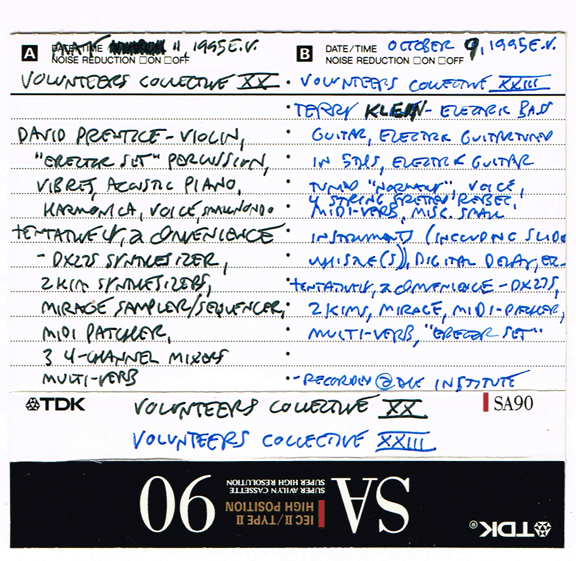
1995.05.11 Volunteers Collective XX - Funny Farm, CacaNada
This was my 2nd duet with the great violinist David Prentice. He played violin, "Erector Set" percussion, vibraphone, piano, harmonica, voice, & small nondo. I played DX27S, 2 K1ms, sampler/sequencer,MIDI-patcher, 3 4-channel mixers, & Multi-Verb, my usual Triple-S Variety Show gear with another mixer added. Even though this is labelled a "Volunteers Collective" the fact that it was recorded in the Turquoise, Beige, & Flesh Room at the Funny Farm & that I was playing my usual Triple-S electronics makes it justas much a Triple-S.
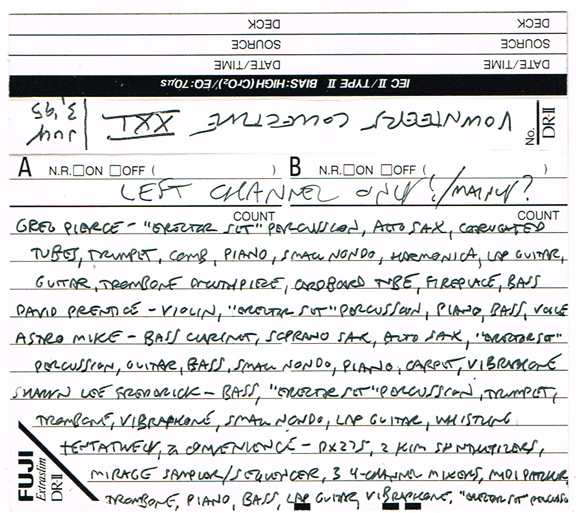
1995.07.03 Volunteers Collective XXI - Funny Farm, CacaNada
The Orgone Cinema folks came to visit me at the Funny Farm & we made a 16mm black & white film of us playing with David Prentice in the Turquoise, Beige, & Flesh Room. Even though the presence of so many people made this clearly a free improv session instead of a Triple-S I still include it here because of where it was recorded & because I was playing my Triple-S gear. The other players were: Greg Pierce, David Prentice, Astro Mike, & Sharyn Lee Frederick. Alisa Dix shot the 16mm in one continuous shot at my request & against her preferred technique.
169. a. "Volunteers Collective 21"
- in collaboration with Orgone Cinema, Sharyn Lee Frederick, & David Prentice (shot by Alisa Dix)
- 'directed' by & played in by tENTATIVELY, a cONVENIENCE
- {unfinished}
- 16mm sound
- app. 12:00 (This should be around 7:55 - I don't know what the 12:00 is)
- July '95
- 16mm -> 1/2" VHS cassette
- limited interest almost presentable fall '96 edit by tENTATIVELY, a cONVENIENCE
- This might be the version that has scratch editing added onto the end - it might be around 12:00
- an excerpt from this is in the context of "UNCERTS" on my onesownthoughts YouTube chnnael here: https://youtu.be/ShRgYeTSK40?t=1h7m5s
- I finally got rid of the extremely noisy Auricon sound & substitued the correctly synced auido from the room recording, I also added titles
- 8:04
- on the Internet Atchive here: https://archive.org/details/idioideo_verizon_VC21
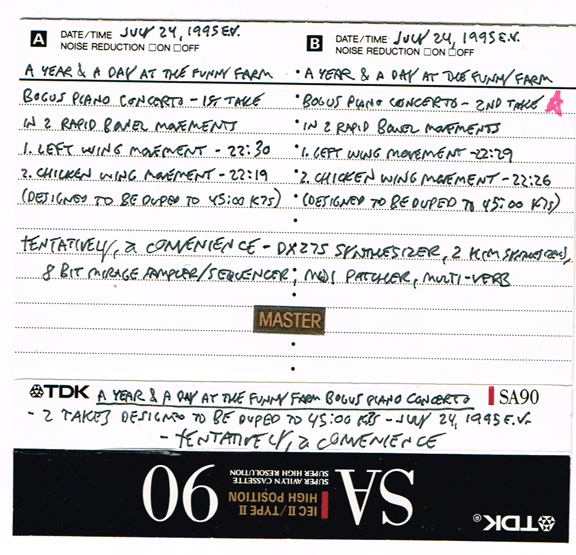
1995.07.24 A Year & a Day at the Funny Farm Bogus Piano Concerto - Takes 1 & 2 - Funny Farm, CacaNada
This was a side-project of the Triple-S Variety Shows. It only used a specific limited selection of the materials in a more or less specific order. The sub-heading is "in 2 Rapid Bowel Movements: 1. Left Wing Movement, 2. Chicken Wing Movement. This tape has my 1st 2 realizations of it, the 2nd of these is starred to show that I think it's the better take. I'm listening to Side A as I type these notes, something I haven't done for many years. There's a monotonous contancy of panning. The 'piano part' is played by me - which means that it's primitive. Later, my friend John Henry Nyenhuis plays that part, with some simple instructions from me that weren't conceived of yet for this early version. John Henry's playing is absolutely brilliant & accimplished so I much prefer to his realizations to mine. The somewhat unskilled nature of my playing here has always bothered me enough to make it so that I rarely listen to this without a bit of 'cringing'. Today, finally, I'm finding my way of playing to be different enough from anything that I'd do now that I'm actually enjoying it.
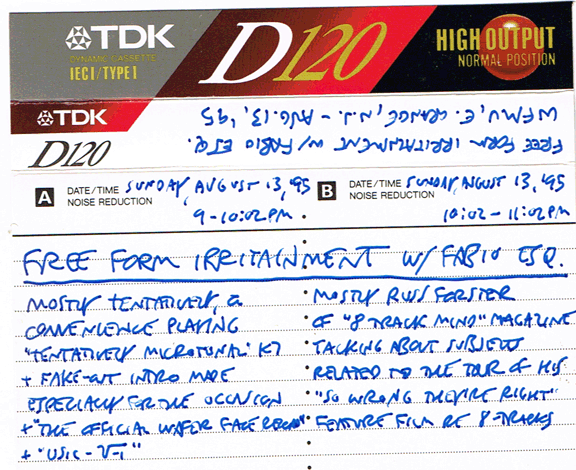
1995.08.13 Free Form Irritainment with Fabio Esquire - WFMU, East Orange, New Jersey
This fits in here because one of the main things I did on this program was play the "Micro-tonal" Triple-S Variety Show tape.
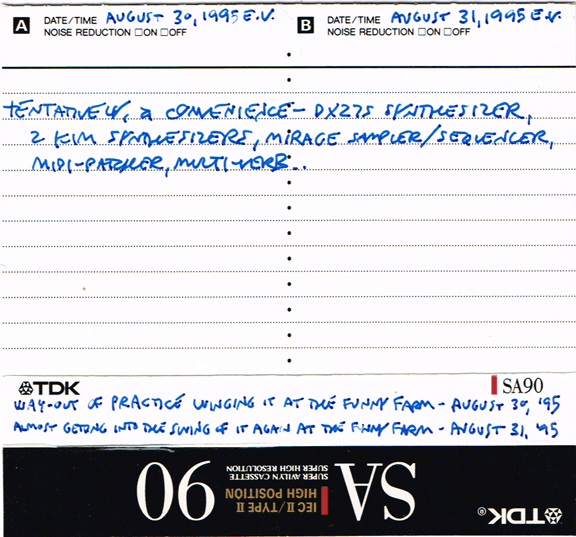
1995.08.30/31 Way-Out of Practice Winging It at the Funny Farm / Almost Getting into the Swing of Things Again at the Funny Farm - CacaNada
The titles of these 2 Triple-Ss probably say as much as I need to.
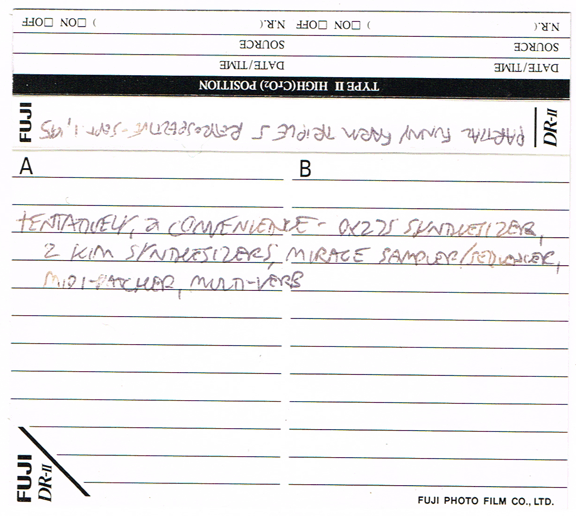
1995.09.01 Partial Funny Farm Triple-S Retrospective - CacaNada
Not having listened to this for a long time I'm concluding from the title that I tried to cram as much of the last 13 months's Triple-S material as possible into one 100 minute session.
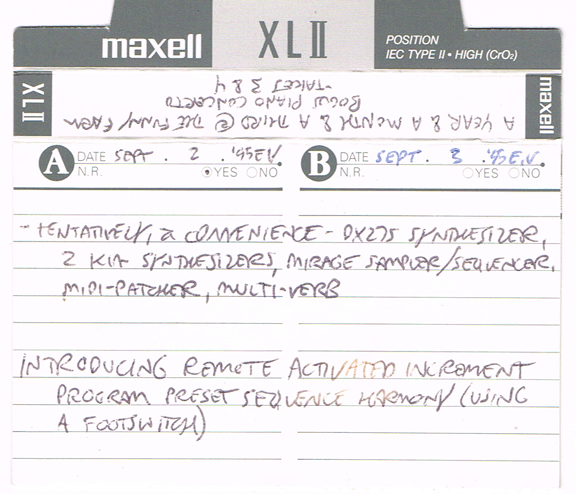
1995.09.02/03 A Year & A Month & A Third @ the Funny Farm Bogus Piano Concerto - Takes 3 & 4 - CacaNada
I'd forgotten that these takes even existed. A note on the cassette package tells me: "Introducing remote activated increment program preset sequence harmony (using a footswitch)". That was significant new development & I can hear it at play shortly after Take 3 begins. Fortunately, the excessive panning that was in Take 1 is gone & my keyboard playing has improved. Even though this doesn't approach the greatness of the realizations with John Henry Nyenhuis that come later it still has some interesting characteristics.
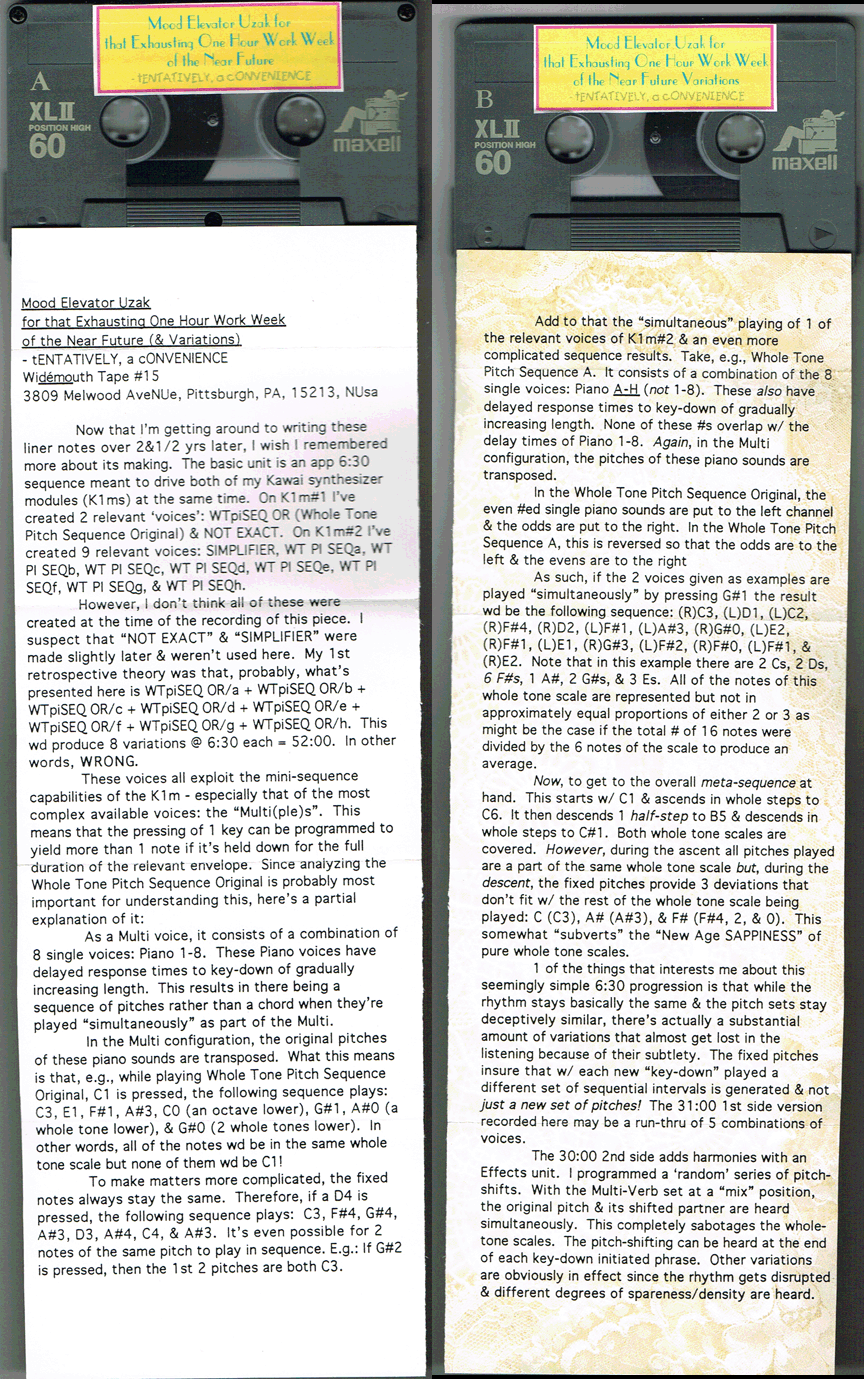
1995.09.03 Mood Elevator Muzak for that Exhausting One Hour Work Week of the Near Future (& Variations) - Funny Farm, CacaNada
This tape isn't dated but I have it filed after Takes 3 & 4 of the "Bogus Piano Concerto" & before the Triple-S recorded the next day. It also uses the remote activated increment program footswitch. This was originally called "New Age Intermission" & that's the sequence that was used to drive the whole thing (sequence 67 - see Sequences ). This was another off-shoot project, using only one sequence but milking it for all it was worth. While not as important at the Bogus Piano Concerto & having never been performed live (ideally it would be played on a carillon) I still chose to publish this as its own tape.
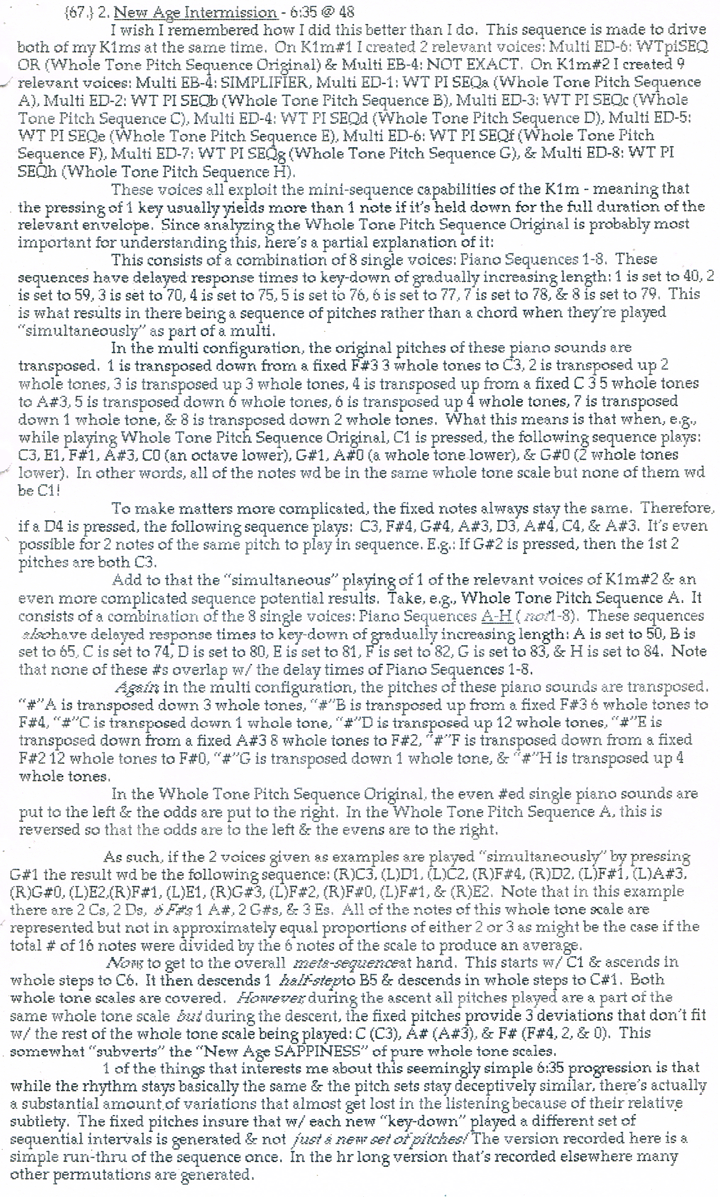


1995.09.04 The Last? Triple-S Variety Show Live in the Turquoise, Beige, & Flesh Room at the Funny Farm - CacaNada
Recorded on my 42nd birthday, this was yet another attempt to summarize the Triple-Ss at the Funny Farm before I had to move out. As it turned out, it was the last recording made there.but wasn't the last CacaNadian Triple-S.
1995.09.07 Bogus Piano Concerto - Take 5 - John Henry Nyenhuis's apartment, Toronto, CacaNada
John Henry Nyenhuis ois truly phenomenal. I am extremely fortunate to've been able to work with him as much as I did. We rehearsed this not once but TWICE on the day before & the day OF the Uncert at the Music Gallery.
This take can be heard on the Internet Archive here:
"A Year & a Day at the Funny Farm BOGUS PIANO CONCERTO
"in 2 rapid bowel movements: 1. Left Wing Movement - Take 5" - 1995 - 22:31
"&
""A Year & a Day at the Funny Farm BOGUS PIANO CONCERTO
"in 2 rapid bowel movements: 1. Chicken Wing Movement - Take 5" - 1995 - 22:37
"- algorithm synthesizer: John Henry Nyenhuis
"- 2 wave-table synthesizers, sampler/sequencer, MIDI-patcher, effects,
"3 4-channel mixers: tENTATIVELY, a cONVENIENCE
"I've released the 6th take of the "Bogus Piano Concerto" on cassette with a liner note booklet & as part of my "Low Classical Usic" CD without those notes. The tape was 'reviewed' ONCE that I 'know' of by a person who must've died quite some time ago without anyone noticing that only his body was still moving. Below is a reproduction of the cassette liner notes + his 'review' + my reply to it. The 5th take that's presented here is somewhat different in details from the 6th take but most of the overall form information still applies.
"notes re the A Year & A Day at the Funny Farm
"Bogus Piano Concerto
"in 2 Rapid Bowel Movements:
"1: Left Wing Movement, 2: Chicken Wing Movement
"This "Bogus Piano Concerto" was created more or less in 1 night during a time of manic intuitive inspiration as an outgrowth of a year's experimentation with & development of, the use of specific sound producing/controlling equipment. I find it hard to "justify" it. It represents no substantial innovation & doesn't make any focused point.
"It's not a clear example of a clear philosophy. I wouldn't call it important. It's far from meeting the criteria of complexity that I usually prefer.
"My intention isn't even to tritely "rebel against" the piano or the concerto. I enjoy listening to it immensely but consider that to be a dubious "reason" for presenting it to a public. Of course, there's the hope that a public will enjoy it too - thusly making me feel that there's a psychic connection between the audience & myself that "requires" no intellectual rationale. My enjoyment of this "Concerto" may be too easily dismissed (by myself as well as others) as "egomania".
"It's a "Bogus Piano Concerto" because it's played with synthesizers, a sampler, a sequencer, a midi-patcher, an effects unit, & mixers. The piano-like sounds are simulations & samples - bogus. It's somewhat a "Bogus Concerto" because it's not based on any aspect of the typical concerto form other than in its use of the contrast between the "solo" instrument & the "orchestration".
"Obviously, even this is bogus because the same instruments are producing both sounds. The word "bogus" is not used deprecatingly. I have no interest in creating a concerto. I'm even "embarrassed" to have the words "piano" & "concerto" in the title.
"The other elements of the title are obviously just a silly quasi-subversion of the traditionalism of the "Piano Concerto" label.
"Its form is fairly simple. The sequencer/sampler & the keyboard are used to midi-control themselves, 2 Kawai K1m synthesizers, & each other. Which controls which when varies. Basically, there are "islands of drama" connected by "bridges of focus". There is not an overall dramatic form in the sense of a sexual build-up, climax, & relaxation. Ideally(?), when it ends, the audience should be left with a feeling that the "concerto" has simply stopped connecting the possible "islands" with possible "bridges" but that the structure continues to exist.
"Only three 333 note sequences are used. The 1st 2 are each one minute long & are in the 1st movement. Both were created originally for bass harmonica & harmonica samples. However, other sustainable sounds with moderately rich harmonics, such as that of a tamboura, can also be used. The 3rd sequence, used in the 2nd movement, was created for a K1m sound programmed by myself called "AUTOBEND".
"It's otherwise intended to primarily drive any of my stereo "multi" sounds. K1m sounds are divided into 2 categories: "single" & "multi". "Multi"s are combinations of from 2 to 8 "single"s.
"Typical factory provided synthesizer sounds have little or no delay between when the key depression triggers the attack of the sound envelopes. Furthermore, these envelopes tend to have no substantial change occur if the sound is sustained for a long time & no substantial change as a result of key release - other than an instant stopping of the sound or a gradual fading out.
"The sounds that I program tend to deviate from this pattern. Up to a 32 note phrase from the K1m can be triggered by holding down 1 key. Thus, each key becomes a switch for a miniature sequencer.
"This is further complicated by what the range of each of the 8 "single"s is within the "multi". In other words, depressing middle C may trigger all of the "single"s within the "multi" but pressing the lowest C might only activate one.
"In most instances, this equipment is limited to 8 note polyphony (meaning that only 8 notes can be played at once). Therefore, how long a sustain on any given key is allowed to continue is partially determined by whether a simultaneously or subsequently played key is triggering a number of notes that causes an exceeding of the 8 note limit - resulting in an arpeggio of a chord or in a superceding of elements of the previous key(s).
"Combining the midi-controlling of multiple instruments, each with complex wave forms, can result in even more variables. If one synthesizer is tuned in 10th tones, while another is in 16th tones, either both can be played simultaneously or a rapid switching between the 2 can be accomplished. One synthesizer might play a sequence with substantial pauses between its units while another might play a continuous sound with glissandi.
"Given these many variables, the keyboard playing has less to do with "pianistic" virtuosity than it does with a knowledge of which envelopes will be triggered, what their characteristics are when combined, how they change when sustained, & when the polyphony limitations will clip them, etc..
"As such, this "Bogus Piano Concerto" is bogus because its most unique characteristics are those most contrary to piano technique. The use of "piano-like" sounds & the word "Concerto" in the title are somewhat intended to arouse expectations of pianistic virtuosity which can then be gone contrary to in the actual keyboard technique used.
"I have very limited traditional keyboard playing skill. This "concerto" was thusly created for myself. In my playing of it, easily played one note repetitions & trills are "thematic" material. These stark elements are the "bridges of focus" that connect the "islands of drama" of the generally sequencer-activated "orchestrations".
"The 1st movement's 1st sequence is simply a held 8 note chord in which each introduction of a new note results in the replacement of an older one. When the sound driven by the sequence is the harmonica sound (or something similar) the result is a subtly shifting sonority. When the sound driven is a sound without indefinitely sustainable characteristics (such as the percussive sound of a piano) the result is abrupt & fast. Which instrument is controlling which other instrument can make drastic differences between successive repetitions of the same sequence.
"The 1st movement's 1st sequence is repeated an indefinite number of times during roughly 1/2 to 2/3rds of the projected length of the movement. Then the 2nd, very similar, sequence replaces it.
"The 2nd sequence has a held 8 note chord thruout with a fast sequence of notes leading to its end. Both sequences are played with pauses between their repetitions. However, the pauses between the repetitions of the 2nd sequence depend on limitations of the sequencer. This sequence is programmed in such a way that when the fast section plays it "overloads" the machine & causes it to break down & play a slightly unpredictable pattern. This necessitates a rebooting of the machine in order for the sequence to be played again.
"The 2nd movement's sequence is approximately 6 & 1/2 minutes long when played at its average speed & it's played continuously in a loop. Since it was programmed while triggering an indefinitely sustainable sound, if it triggers sounds with shorter envelopes, once again, the differences will be substantial. Which "island of drama" is the most "dramatic" depends upon which type of wave-form is being triggered. Simply holding one key down for an envelope that needs to be sustained for its full effect may only produce a quick & quiet plunk with another sound.
"A fast sequence might be more effective in displaying the unique tuning of the "plunking" sound but might clip the richness of the sound with the longer envelope. Both elements are used in the sequence. It was also designed to fully exploit certain stereo possibilities.
"This "concerto" can be said to represent what I call "modular d comprovisation" - meaning analytically composed modular units played & related to improvisationally. Its fixed elements are the sequences & their placements in the movements, the centrality of the piano-like sounds, the linking of "dramatic" moments by non-crescendo oriented playing, the variety of midi-controlling, &, especially, the variety of wave-forms used.
"Otherwise, what happens is "open". This means that there are no specific notes to be played in the "piano" part & no specific order that the sounds triggered by the sequencer must follow. It means that sometimes the keyboard playing might be triggering sounds in addition to the "piano-like" ones & sometimes not. With the exception of a few loose somewhat predictable "tendencies" not gone into here, variety & surprise are encouraged.
"The 1st playing of this "Bogus Piano Concerto" was by myself. A variation on having this be a one-person playing is to divide the controlling possibilities into 2 parts. One being that of the keyboardist who only plays the keys, the sustain/portamento & volume pedals, & the pitch & modulation wheels. The other being that of the person who controls everything else - such as the midi-patching, the sound-choosing, the mixing, & the effects.
"For a presentation at the Music Gallery in Toronto I chose this 2 role division. The keyboard playing role went to John Henry Nyenhuis. John was chosen precisely because he's everything as a pianist that I'm not. He can play more complex figures with either of his hands (he's "left-handed") than I can with both hands together (in a certain way at least).
"He's familiar enough with the specific pitches of the typically even-tempered tuning of the piano to play melodies correctly with his eyes closed. He's capable of sustaining a precise rhythmic pattern while intricately deviating from it with great nuance. And, he has a huge repertoire of other people's music & a large variety of genre styles.
"John partially supports himself as a lounge pianist & creates piano sound for silent movies - he's even been called upon to play a fire organ. I've heard him referred to as a "human juke-box" because of his extraordinary abilities to fluidly play a variety of popular styles. As such, he's an archetype of exactly the type of pianist that this "bogus concerto" was not created for!
"Choosing to play with John was not only an expression of my extreme admiration for his skill, but was also intended to create a mutually subverting conflict between our 2 roles. He wasn't in complete control of what sounds his playing triggered & what sounds the "orchestration" had, & I wasn't in control of how he exploited the potentials of the sounds.
"His instructions were basically to play only quotes & styles in the 1st movement. These are limited to being played just long enough to have enough content to be recognizable to someone familiar with what's being referred to - with a maximum time being approximately 15 seconds per quote/style.
"If I gave him a hand signal, he was to have the "liberty" to change keyboard settings - otherwise he was to stay with a particular piano sound only. In the 2nd movement, he was to play no quotes or pop music styles. If he found himself playing either (apparently, he didn't), he was to immediately stop playing for at least 10 seconds.
"He was further instructed to play furiously at the beginning - demonstrating the virtuosity of his technique & to gradually slow down until he played very minimally by the end of the 1st movement. This process was then to be reversed in the 2nd movement.
"In keeping with the "conflict" between his playing & my playing, the density of what the audience witnessing this "live" heard didn't jive with the density of what they saw being played. In other words, in the beginning of the 2nd movement the touching of one key could trigger a sequence - thusly belying the usual key-to-note ratio expected. But, by the end, fast playing of many pitches could be controlled by me to only produce one pitch at a time. This subtle oddity was partially designed to make the "concerto" "concert" (or uncert) more interesting to watch for the more alert members of the audience. I usually find straight-forward concerts to be very dull to watch regardless of how interesting they may be to listen to.
"In concerts in which no novel technique is being used for the production of the sounds the personalities of the players & their dexterity are the main visual stimulus. In this case, the "reward" for paying attention to the keyboardist's technique would be to be surprised by the afore-mentioned disparity.
"After hearing one of these recordings of the BPC, my step-brother said something about the relationship between the "piano" part & the "orchestration" making "no sense" to him. In an attempt to explain my intention I developed the analogy that the 1st movement is like a tightrope walker's marathon thru a variety of weather conditions.
"Regardless of whether there's a thunder-storm or intense sunlight, the keyboardist's challenge is to maintain a focused course.
"In the 2nd movement the challenge is more of a maze or an obstacle course. There are basically 5 different sections that involve unusual keyboard-to-sounds-produced relationships. 1st, the keys sound samples of piano phrases - the keyboardist not only produces more than one note by only striking one key but can also trigger combinations of trills & phrases that would be physically impossible under ordinary conditions.
"2nd, the striking of one key can produce a sequence with as many as 16 pitches in a complexly varying form - this introduces a melodic logic (or "melogic") difficult for the keyboardist to predict exactly without knowing the programming structure.
"3rd, the keyboard triggers a playing of 10th-tones rather than the typical half-tones - with the adjacent note relationship not being directly incremental: more explicitly: within each octave the notes are a half-tone apart, but each octave is only a 10th-tone apart .
"Therefore, to play all 60 pitches of the octave in direct order, the keyboardist has to 1st play, e.g., "C" in the lowest octave, then in the next octave, etc.. - returning to "C#" & repeating the process, etc..
"4th, the keyboard triggers 16th-tones: 4 notes at one pitch for one percussion sound adjacent to 4 two note chords one 16th-tone apart made by a combination of the 1st percussion sound & the next single note sound (adjacent to the combination), etc.. - playing the full length of the keyboard only covers one half-tone.
"5th, at any given time at the end, the keyboard playing might produce either the typical chromatic set of pitches or only one of a set of 8 pitches or a mix between these 2 possibilities. This last can change the focus from "melodic" to rhythmic without the keyboardist's changing their keys-played-sequence at all.
"In the process of reworking the structure of this "concerto" with John Henry, the original "islands of drama" connected by "bridges of focus" became somewhat transformed into a "navigation of drama" by "vehicles of focus" or some such - at any rate, I hope that you can still imagine after the "end" "that the structure [still] continues to exist" or, better yet, persist.
"- these notes were written July 29th, 1995ev
"& updated February 6th, 1996ev"
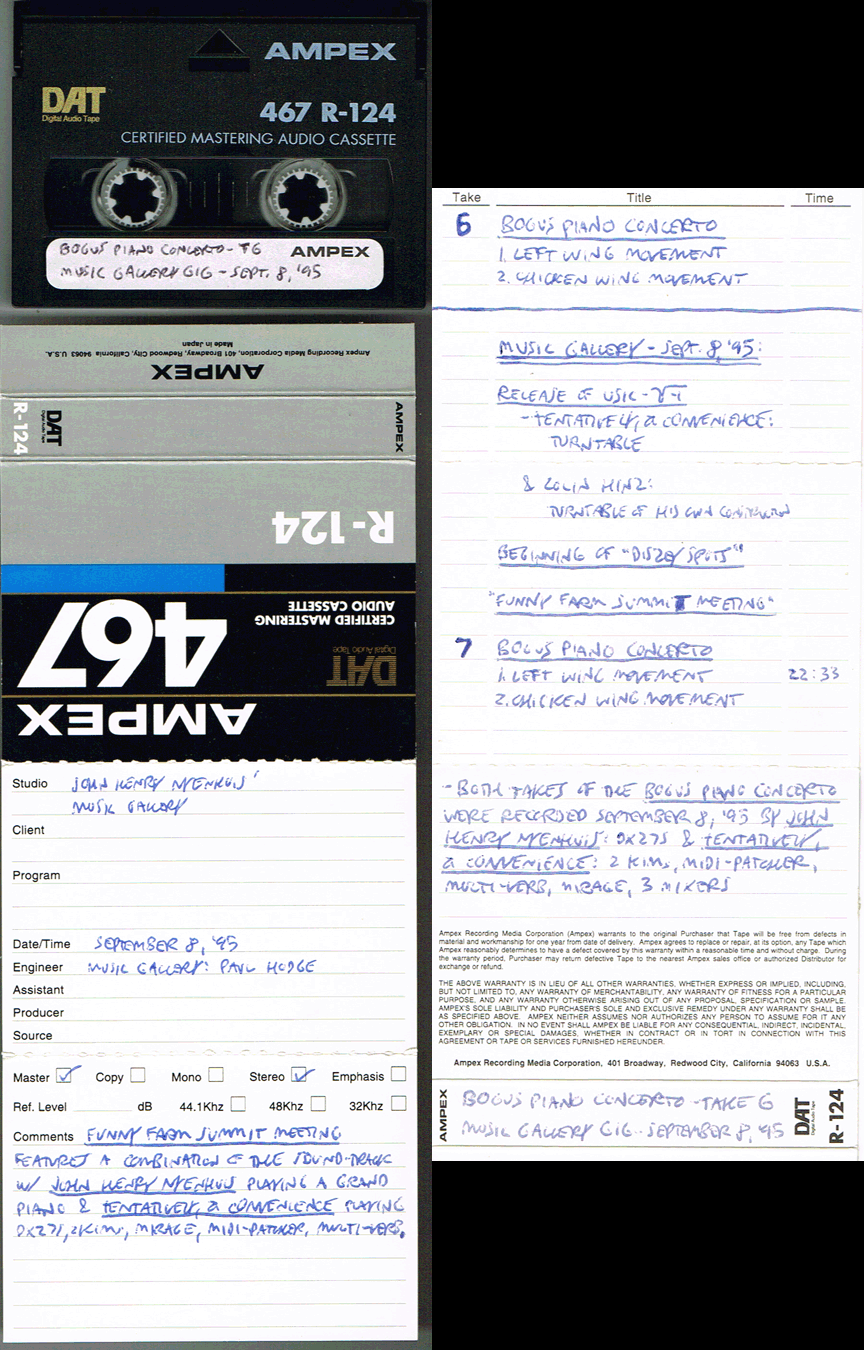
1995.09.08 Bogus Piano Concerto - Take 6 - John Henry Nyenhuis's apartment, Toronto, CacaNada
I can't praise John Henry's professionalism & enthusiasm enough. Hearing his nimble & exact fingers at work on this is a thrill that doesn't die easily for me. He made this so perfectly what I wanted that I seriously doubt that anyone else could equal him. I picked this take to publish as a tape in a larger edition than any other tape I've ever published.
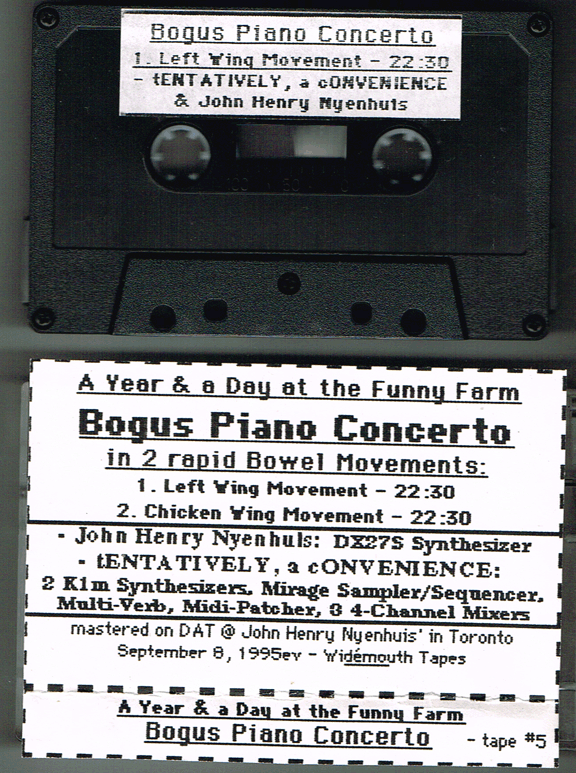
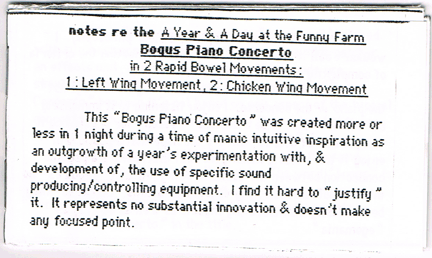

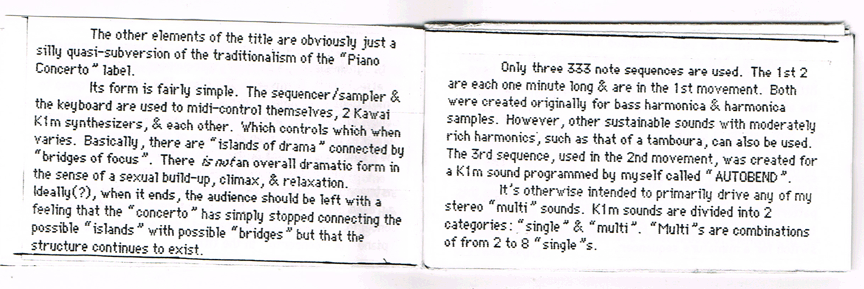


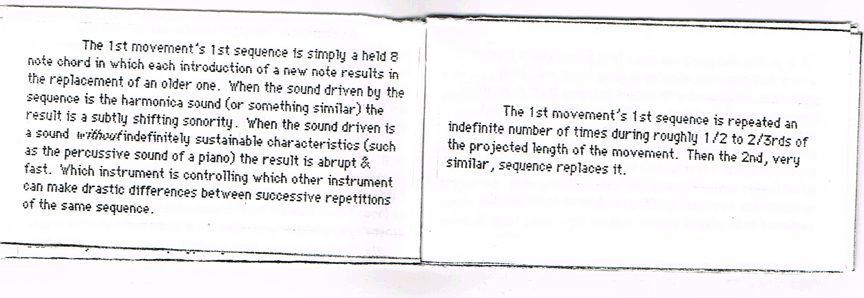




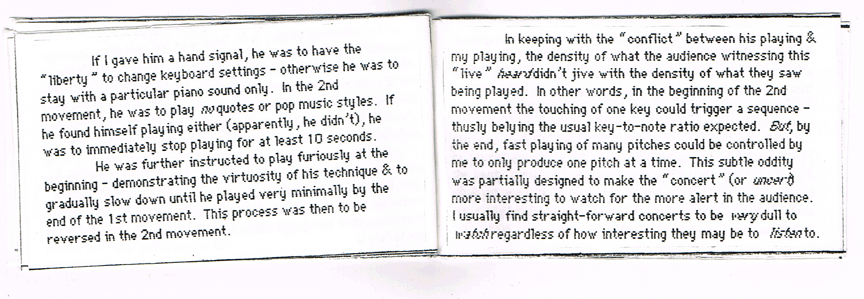
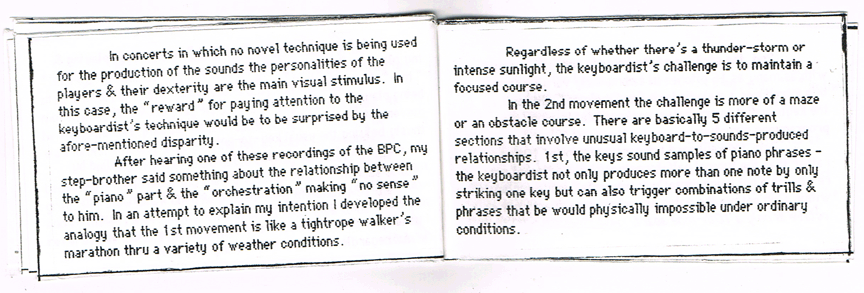


It's almost impossible for me to get anything reviewed. I sent 4 tapes to Improvisor magazine for review. Three of them, as far as I know, weren't reviewed at all. One of them, the "Bogus Piano Concerto" the packaging for which is shown above, was given short shrift. I fought back online on the Internet Archive presentation of Take 5 as part of "Piano Illiterature - Volume I of II" (which is now up to 7 volumes).
"Glenn Engstrand is, without doubt, the biggest shit-for-brains excuse-for-a-reviewer I've ever encountered. He's an utter disgrace to any standards of scholarliness, intelligence, imagination, & ethics. Thanks to his complete stupidity, I've removed my recommended link to "the improvisor" from my web-site. See the below:
"From: "the improvisor" website - us@:
"Bogus Piano Concerto - Cassette - tENTATIVELY, a cONVENIENCE (various),
"John Henry Nyenhuls (DX27S Synthesizer)
"This tape is a long series of very recognizable melodic phrases from various musical sources including classical, pop, TV and movie theme songs. It sounds like a MIDI file that was downloaded to the cassette.
"The photocopied, cassette sized liner book (printed using technology that is no longer available) is fairly appologetic about the derivative nature of this work.
"- Glenn Engstrand
"tENTATIVELY, a cONVENIENCE responds (unpublished):
"Glenn Engstrand definitely wins the STUPIDEST EXCUSE FOR A REVIEWER AWARD OF THE YEAR FOR THE ABOVE (& for his 'review' of 014 - Livid @ the Schmaltzwald)! Even gracing the above with the name "review" is giving him entirely too much credit.
"1st, this tape is not "a long series of very recognizable melodic phrases from various musical sources including classical, pop, TV and movie theme songs". That's a description of the 1st 1:08. There're another 44:00 which Engstrand apparently didn't listen to. 2nd, while it may sound to Engstrand "like a MIDI file that was downloaded to the cassette", this was played LIVE WITH NO OVERDUBS by 2 people. The closest it comes to what Engstrand refers to is my use of sequences. However, even these sequences are manipulated live & are only a part of what's happening overall.
"Engstrand's 'review' consists of 3 sentences. Of these measley 3, Engstrand found it somehow important to comment on the printing of the booklet! Incorrectly, of course. He notes that it was "photocopied" (at least he got that much right) but was "printed using technology that is no longer available". Let's ignore the basic idiocy of that statement's implying that photocopying is no longer available & get to what he probably meant: the 'master' from which the printing was done was done using a dot-matrix printer. Sorry Glenn, would I have gotten 4 sentences if I'd used a laser printer?
"Finally, this abysmal moron writes that the "liner book [..] is fairly appologetic about the derivative nature of this work." Putting aside the inevitable typos & misspellings that people with 1:08 attention spans manage to squeeze into even a 3 sentence text, I want to call attention to the liner book's certainly not being apologetic about anything! The "Bogus Piano Concerto" is exactly what I wanted it to be & I'm quite proud of it. It certainly isn't derivative because of using quotes any more than a person speaking is 'derivative' for using words. Judging from this shit-for-brain's statement, you'd think that I wrote something like "Don't listen to this - I'm just copying so-&-so - I have no idea what I'm doing." I've reproduced the entire liner book text above so that you can know what the booklet does say.
"I assume that what Engstrand is referring to is the somewhat self-deprecating tone of the introductory paragraphs. I write "I find it hard to "justify" it. It represents no substantial innovation & doesn't make any focused point. It's not a clear example of a clear philosophy. I wouldn't call it important. It's far from meeting the criteria of complexity that I usually prefer." Rather than being apologetic, I feel that I was simply being honest. In the world of experimental classical or 'avant-garde' music there's an emphasis on always telling the audience how innovative the composers/players are. Much of the time, such innovations are overly hyped. I could've easily taken that tact myself. Instead, I preferred to downplay the pompousness of such attitudes in favor of questioning. Instead of telling the listener how important I am, I wrote "I enjoy listening to it immensely but consider that to be a dubious "reason" for presenting it to a public. Of course, there's the hope that a public will enjoy it too - thusly making me feel that there's a psychic connection between the audience & myself that "requires" no intellectual rationale. My enjoyment of this "Concerto" may be too easily dismissed (by myself as well as others) as "egomania"." Perhaps I should've followed Dali's strategy & written "I'm the world's greatest d composer - not because I'm so great but because everybody else is so BAD."
"Somehow, Engstrand didn't find it noteworthy to mention that the liner notes explain that 10th tones & 16th tones are used. Somehow, Engstrand didn't find it noteworthy to mention why I called the piece "Bogus". Somehow, Engstrand didn't find it noteworthy to mention the terminology of "modular d comprovisation". Of course, Engstrand doesn't even bother to get into the 2nd movement (which contains NO quotes) because he never made it that far. Why bother to pretend to review something if you're not even going to listen to it, you asshole?! Engstrand doesn't even mention ANYTHING other than a little of John Henry's part - MY playing isn't mentioned at all. Imagine reviewing a duet & only barely describing what 1 player plays & not mentioning the other player at all! It would've at least been funny if Engstrand would've reviewed a Beethoven piano concerto in terms of something as ephemeral as how many times the pianist pressed the sustain pedal (getting the number wrong of course) & not mentioning the orchestration at all - but Engstrand's got the sense of humor of the Killing Fields.
"Why do worthless cretins like Engstrand exist at all? Ah! Here we get into the utterly vapid world of 'improvisors' today. 1st, if you find 1 who actually improvises rather than imitating the STYLE of what improvising's 'supposed to sound like' you'll be lucky. Engstrand, like all the other improvisor reviewers except for LaDonna Smith, is a horn player. What a yawn that is. You KNOW, rock musicians play guitars & drums - & jazz musicians play saxophones - & improvising is what jazz players do. What an utter cliché all that shit is. Oh gosh, can those guys really blow. Or is it suck?! If I never hear another passionate individualist horn player sounding just like all the other passionate individualist horn players, it certainly won't be my loss.
"Since Engstrand didn't bother to listen to the "Bogus Piano Concerto" before reviewing it & didn't bother to read the booklet before paraphrasing it, here's a review of a concert by Engstrand that I've never heard.
"Glenn Engstrand Live
"Sometimes he played fast & squeaky & sometimes he played slow. Then he muted the bell of his thing with his knee. Nothing new. Either way, he's a lousy guitarist. Oh yeah, there were 6 other people playing with him but I didn't hear what they did because I was outside the venue the whole time.
"THAT's a far more honest & accurate review of EVERY concert Engstrand has EVER played than his 'review' of the "Bogus Piano Concerto". At least I managed to eke out 5 whole sentences."
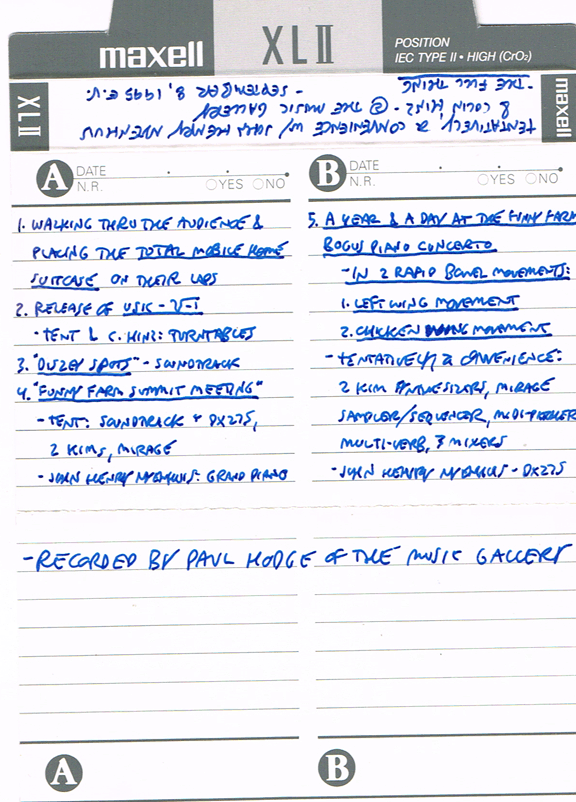

1995.09.08 a sO-cALLED wHATEVER - Music Gallery, Toronto, CacaNada
I love the Music Gallery. I've been told that the particular space that this sO-cALLED wHATEVER was in is no longer under their control. Too bad (although I haven't really confirmed that) The whole movie of this, ever-so-slightly shortened to get rid of 'dead space' is on my onesownthoughts YouTube channel here: https://youtu.be/kjkDZsaWhkk
200. a sO-cALLED wHATEVER
- Music Gallery, Toronto, CacaNada
- Friday, September 8th, 1995, 8:00PM
- This was divided into 4 parts:
1st, the "Total Mobile Home Suitcase" (named after the micro-cinema run by Rebecca Barten & David Sherman in San Francisco that the suitcase was semi-inspired by) was placed on the lap of each audience member & opened. With each opening a different short audio piece was heard & the suitcase was then closed. When the suitcase reached a friend that I hadn't seen for 8 years (Alan Lord), it greeted him with "Hey, Baby". Another audience member pulled out a pouch of tobacco & pointed to it when the suitcase played a coughing sound for him. The 2nd part consisted of Colin Hinz & myself playing the double groove sides of "Usic minus the square root of -1". Colin played on a turntable that he'd made that has a wider variety of speeds than normal. Colin dropped fishplates on the record while playing it - just as he had during 1 part of the same record (on which he's represented remaking the "Official Wafer Face Record").
The 3rd part began with a straight presentation of my film "Diszey Spots" & was followed by my film "Funny Farm Summit Meeting". This latter is a film of a nudist mask party at the Funny Farm - a 19 room farm house in Ontario covered from floor to ceiling with kitsch & novelty items (etc..) collected, created, & organized thematically by the humorous "mastermind" of Laura Kikauka. This was where I'd been residing for the previous year. The film's sound-track was accompanied by John Henry Nyenhuis's playing grand piano whilst naked wearing the same mask that he was shown wearing in the film (whilst also playing piano) & by myself playing synthesizers & sampler while also naked & wearing the same mask as in the film.
John Henry Nyenhuis on the left
The 4th part was the fabulous world premier of my "A Year & a Day at the Funny Farm Bogus Piano Concerto - in 2 Rapid Bowel Movements". This involved John Henry playing keyboard while I played synthesizer modules, sampler, sequencer, midi-patcher, multi-verb, etc.. The relationship between our 2 parts was a sort of intricate mutual subversion in which John played with an almost super-human virtuosity & I mutated & immersed his pianistic linearity. The structure was such that John Henry began by playing furiously (in the "Left Wing Movement") & gradually slowed down. He began the 2nd, & last movement (the "Chicken Wing Movement"), playing minimally but triggering more notes than he touched. As this last movement progressed he gradually returned to furious playing but his pitch output was drastically reduced by my controlling. As such, the audience was presented with a variety of relationships between what his fingers were actually doing & what they actually heard as a result. Simultaneously with this was the projection of an extreme slow-motion film of mine (collaboratively made with the loveable Orgone Cinema folks) entitled "How Orgone Cinema Treats Its Visiting Filmmakers". This film, at 24fps, is only 5:40 long - but in this projection it was extended to 45:00 by having the projectionist play bits of it in both forward & reverse. The film features, amongst other things, fertilized duck eggs being thrown at the back of my head.
footage from the suitcase portion of this is here: https://youtu.be/ShRgYeTSK40?t=1h11m58s
footage from the Usic LPs portion of this is here: https://youtu.be/ShRgYeTSK40?t=1h17m39s
footage from the Funny Farm Summit Meeting portion of this is here: https://youtu.be/ShRgYeTSK40?t=1h21m33s
footage from the Bogus Piano Concerto portion of this is here: https://youtu.be/ShRgYeTSK40?t=1h35m17s
- recollections from tENTATIVELY, a cONVENIENCE - Mere Outline 1995

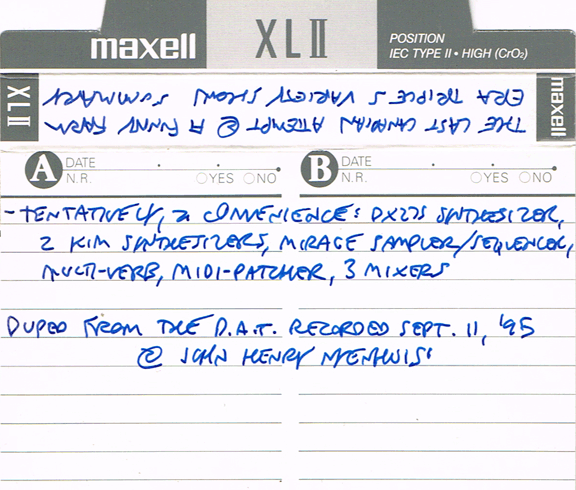
1995.09.11 The Last Canadian Attempt @ A Funny Farm Era Triple-S Variety Show Summary - John Henry Nyenhuis's apartment, Toronto, CacaNada
Trying to squeeze all 67 of the sequences made up to this point + all the samples & programmed voices into one 100 minute session was, of course, an 'impossible' task. Realizing that I was still working at John Henry's place 3 days after our Music Gallery event is somewhat astounding to me. I must've been staying at the 50 Wabash Speak so I wouldn't've been too much in the way at JH's. Still, I'm retroactively impressed that we had such a good friendship.


1995.09.11 Volunteers Collective XXII - John Henry Nyenhuis's apartment, Toronto, CacaNada
Another profoundly excellent session, certainly one of the best duets I've ever played as part of. As I recall, John Henry was working on his fantastic "Melleny Melody and the Syncopated Symphonies of John Henry Nuenhuis" CD at the time so some of the samples for that were worked into this. He played an EMAX HD sampling keyboard & I played my usual Triple-S gear.
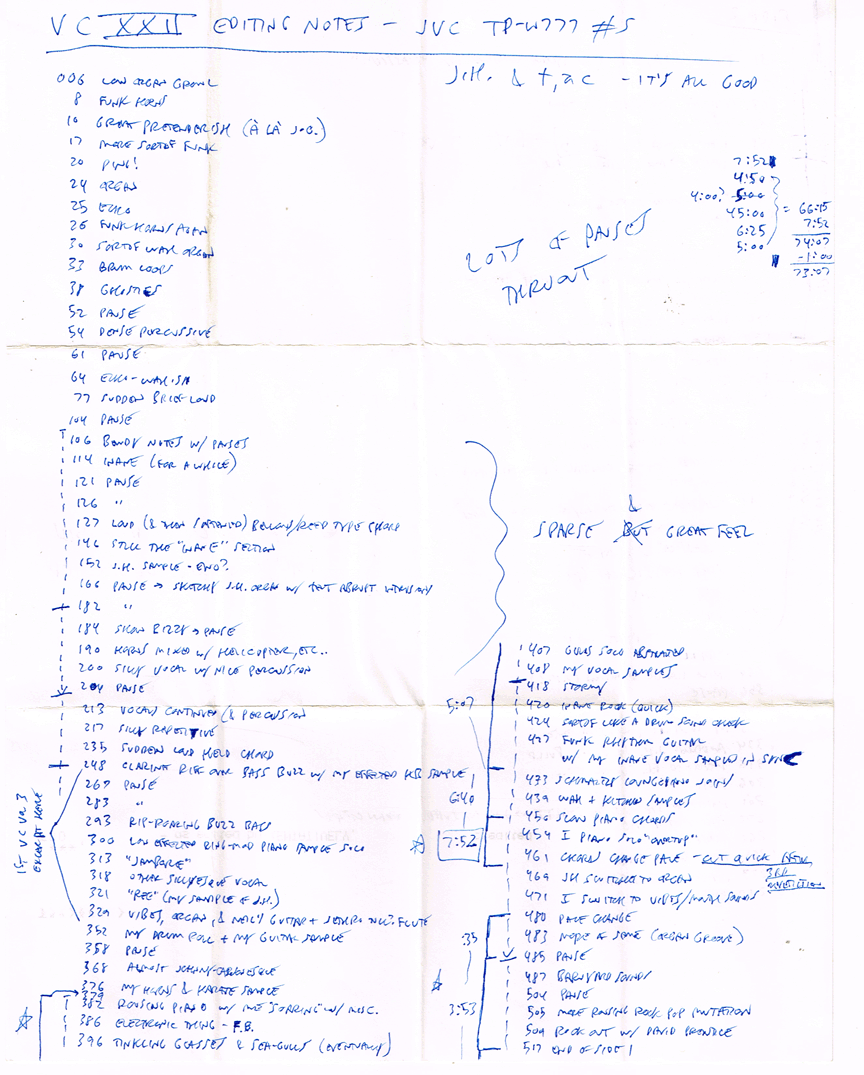
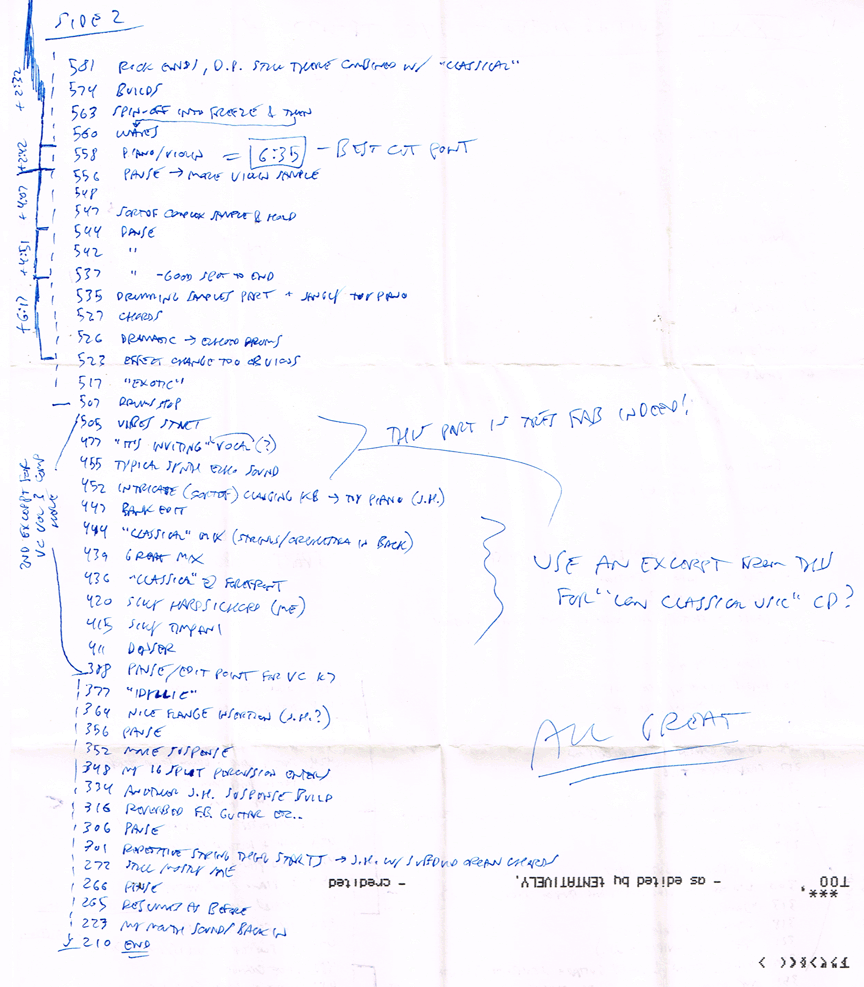

Volunteers Collective XVIII - XXII
I'm not quite sure where I was living when I put this out or when, exactly, I put it out. I was probably still living at the Funny Farm - right before I moved away. I used my Mac SE & my dot-matrix printer to design the cassette insert & the tape label contact address is the Orgone Cinema house in Pittsburgh. If I'd moved to Pittsburgh that wouldn't've been the case. The point is that this tape was very cheaply done & the design is the poorest I ever made. Still, it's got excerpts from VC XIX ("Vexations"), VC XX (duet with David Prentice), VC XXI (Prentice + Orgone), & VC XXII (with John Henry Nyenhuis) - so (m)usically it's excellent.
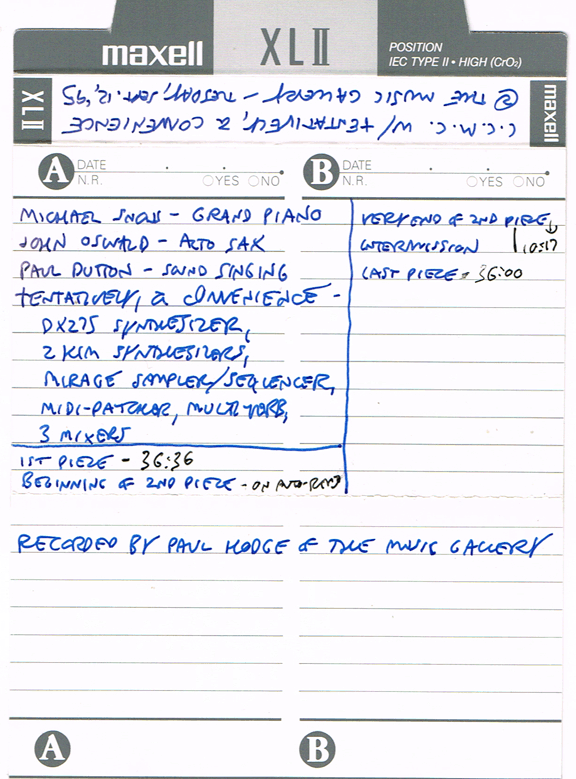
1995.09.12 with C.C.M.C - Music Gallery, Toronto, CacaNada
Somehow I was invited to play with the venerable improvising group & even invited by Michael Snow to continue playing with them any time I was available to do so but, alas, I moved away from CacaNada after this & never played with them again. The line-up consisted of Michael Snow: grand piano; John Oswald: alto sax; Paul Dutton: sound singing; & myself (tENTATIVELY, a cONVENIENCE) on the usual Triple-S gear. Without informing my fellow players, I'd conspired with the sound engineer Paul Hodge to have a feed from everyone into my sampler so that I could sample them live & play them back to themselves, in 'sculpted' form, throughout the concert. This was my most important contribution. This wasn't really very Triple-S Variety Show at all. I was somewhat subdued because I didn't want to brashly dominate the subtle dynamic. Still, I was using the Triple-S gear & I like including this gig here because it was such an important one to me.
A highly abridged movie of this gig is on my onesownthoughts YouTube channel here:
170. a. "w/ CCMC"
- featuring: Michael Snow: piano, John Oswald: alto sax, Paul Dutton: voice singing, tENTATIVELY, a cONVENIENCE: sampler (w/ live sampling), syntheiszers
- shot by Istvan Kantor / Monty Cantsin September 12, 1995 @ the Music Gallery, Toronto
- edited to DVD sometime around 2002
- VHS -> DVD
- 27:39
b. "w/ CCMC" (YouTube version)
- this is the excerpt used on the "UNCERTS" compilation w/ title & credits added around November 4, 2009
- VHS -> mini-DV -> computer file -> mini-DV -> YouTube
- 3:31
- on my onesownthoughts YouTube channel here: https://youtu.be/epsDAADK2XA
[REJECTED:
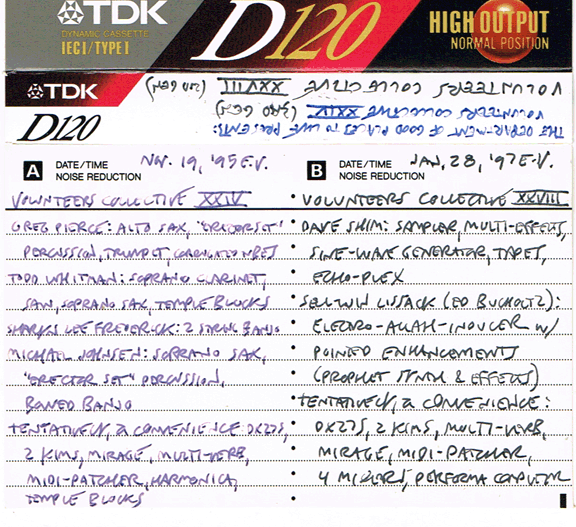
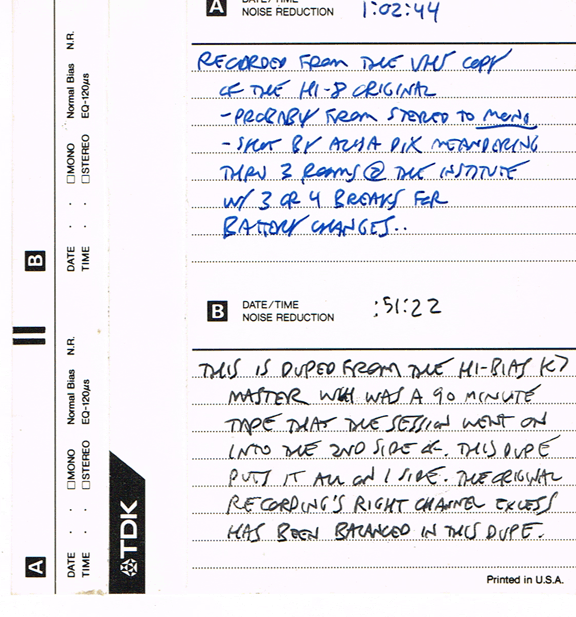
1996.11.19 Volunteers Collective XXIV - Get-Outstitute, Buffalo, us@
I'm including this here, even though I'm rejecting it as a Triple-S Variety Show, because it's the only session from my brief two months living in Buffalo that there's a movie from & because I DID use the Triple-S gear (albeit sparingly). As it turned out, where I was living was most defintely NOT a good place to live.
177. a. "The Department of Good Places to Live Presents: Volunteers Collective XXIV"
- shot by Alisa Dix
- w/ Todd Whitman, Greg Pierce, Sharyn Lee Frederick, Michael Johnsen, tENTATIVELY, a cONVENIENCE
- edited & effected by tENTATIVELY, a cONVENIENCE
- 8mm vaudeo -> 1/2" VHS cassette
- 7:20
- november 19, '95
- this is presented in the context of "UNCERTS" on my onesownthoughts YouTube channel here: https://youtu.be/ShRgYeTSK40?t=1h38m9s
b. "The Department of Good Places to Live Presents: Volunteers Collective XXIV"
- 1:02:46
- titles & digitizing finished may 30, 2019E.V. by tENTATIVELY, a cONVENIENCE
- on my onesownthoughts YouTube channel here: https://youtu.be/QqZjCduGiz4 ]
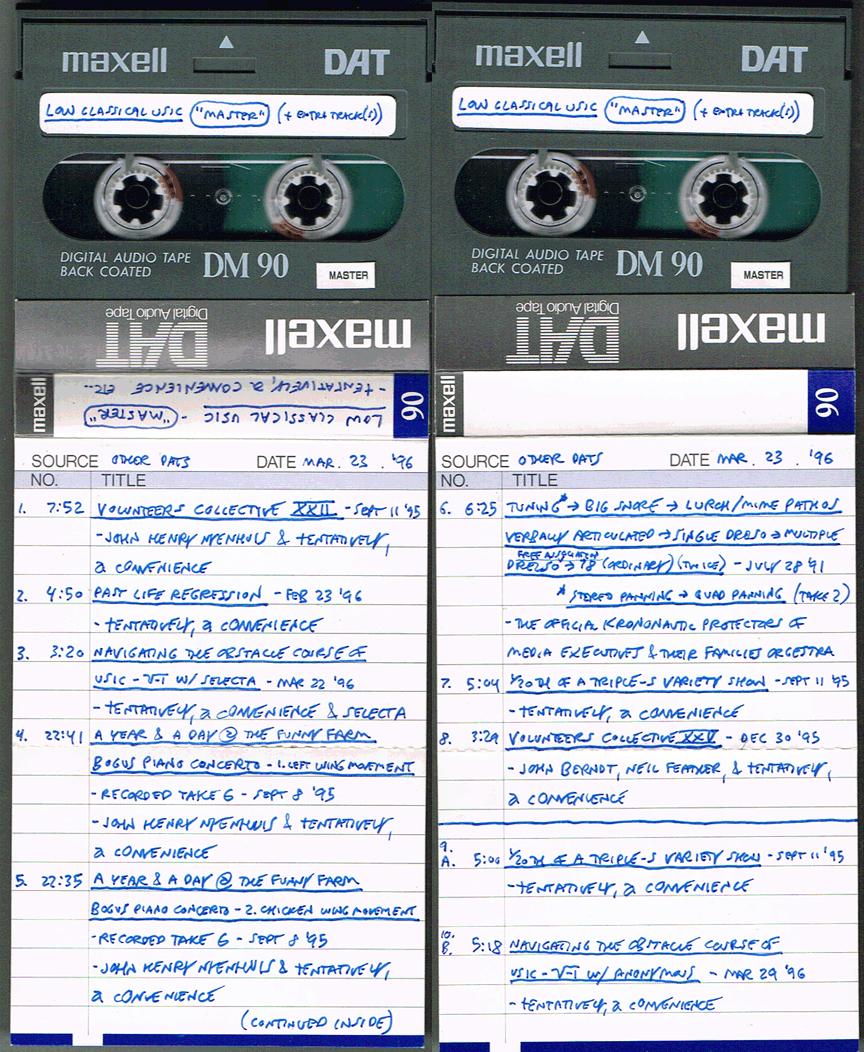
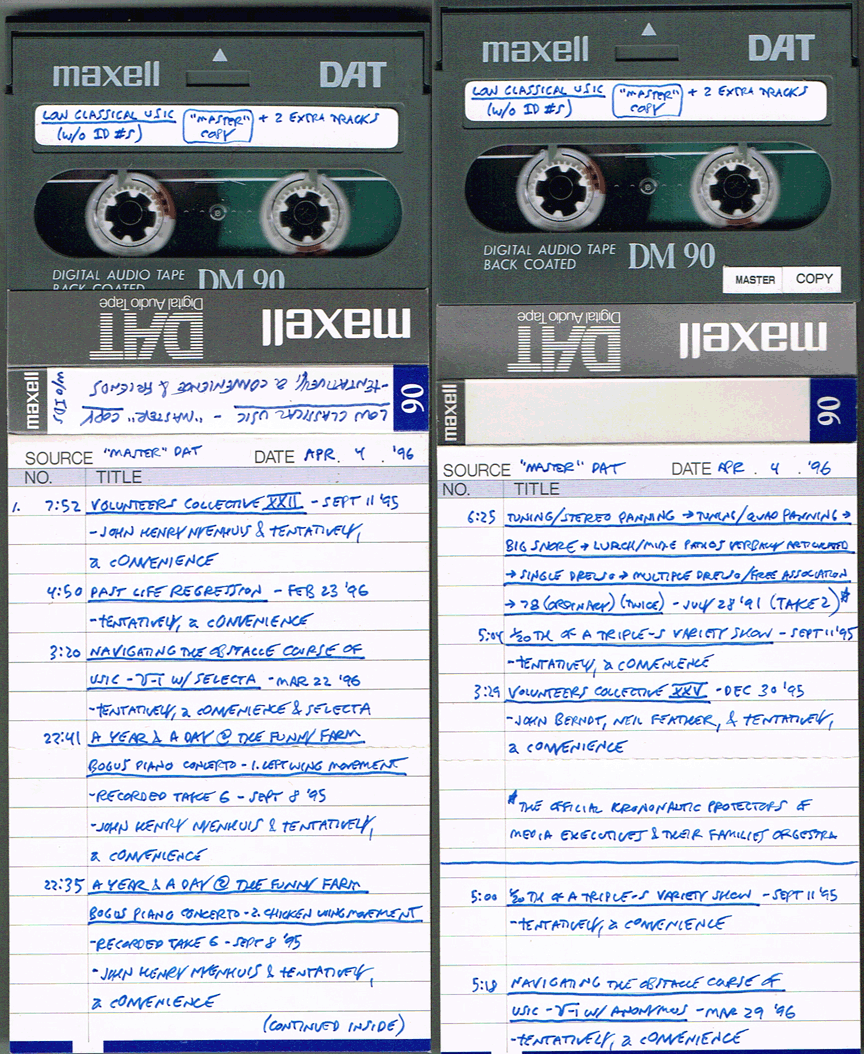
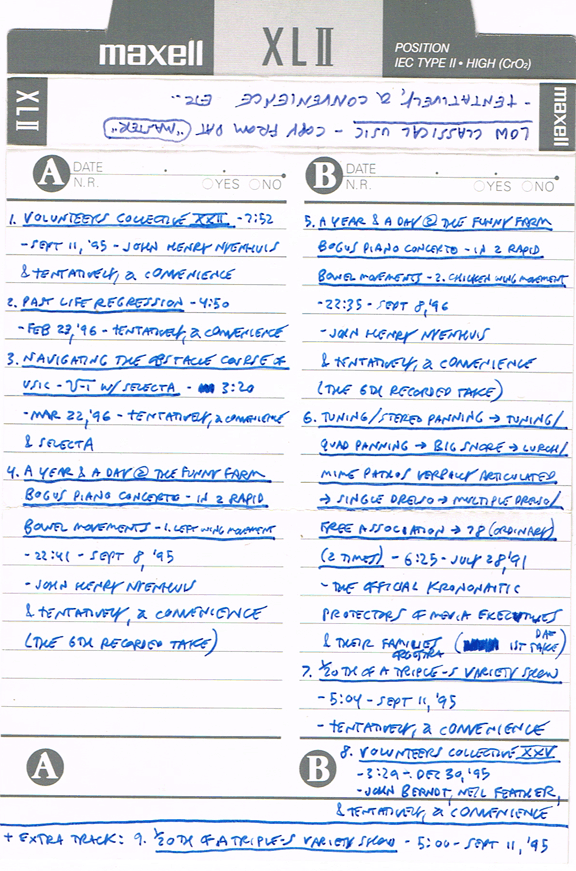
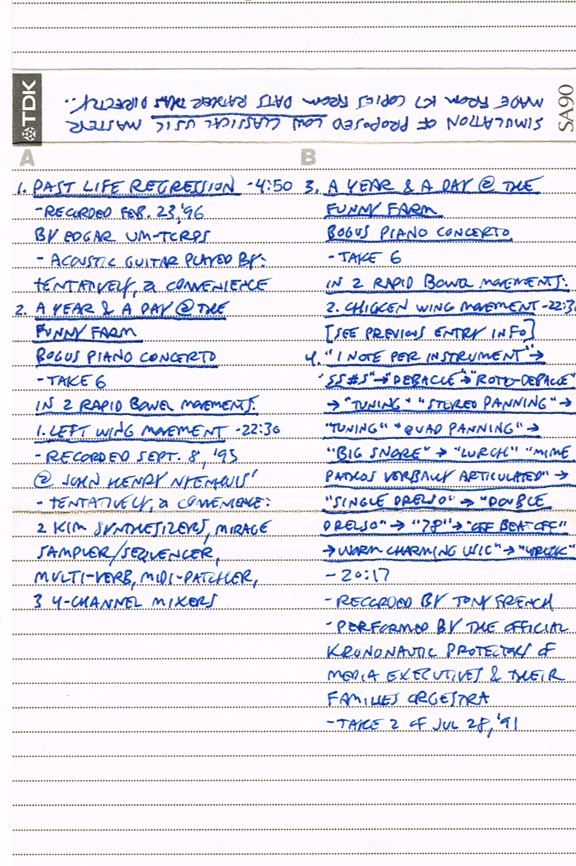
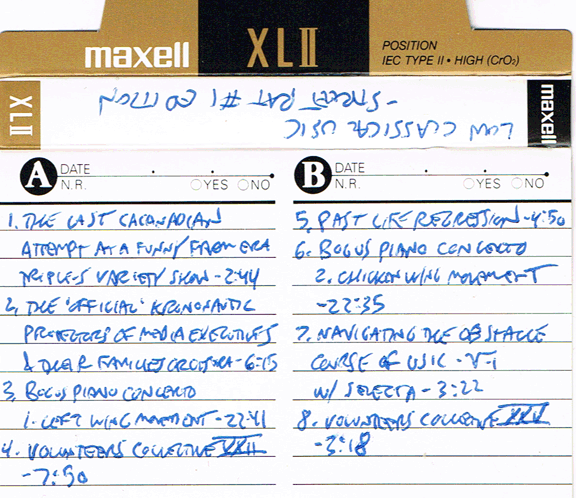
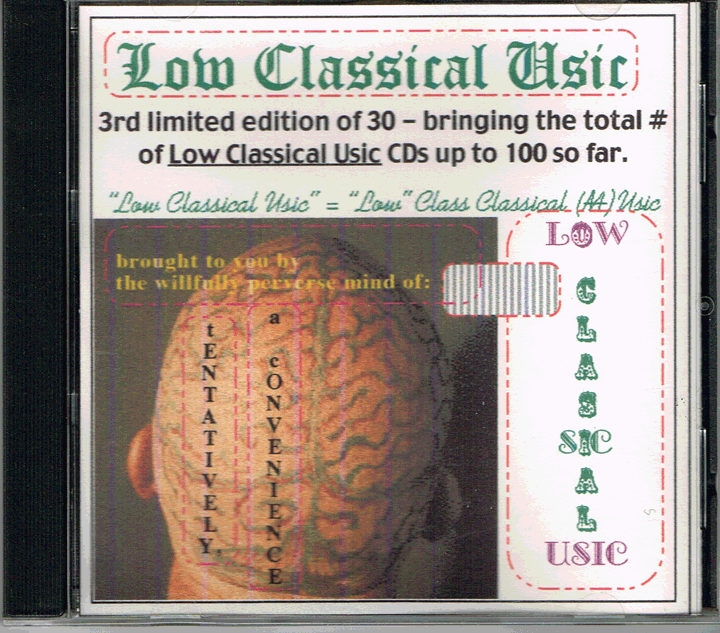
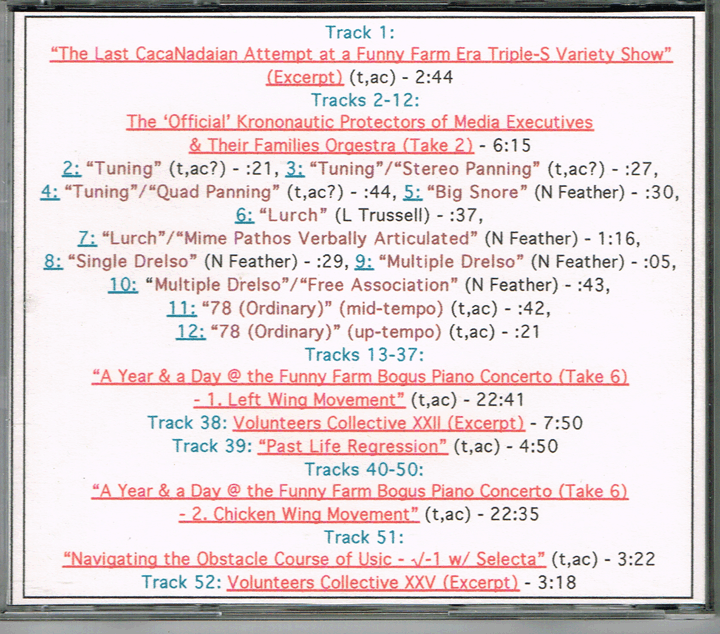
1996 Low Classical Usic - NU-NU, Pittsburgh, us@
This is a CD retrospective of recent work that included some Triple-S material listed above. I made 3 incarnations of it. The 1st included an excerpt from VC XXII, the Bogus Piano Concerto take 6, & ashort excerpt from the September 11, 1995 Triple-S Variety Show. The 2nd, strangely abridged one, only had the Bogus Piano Concerto representing the Triple-S. The 3rd has an even shorter excerpt from the September 11, 1995, Triple-S + the Bogus Piano Concerto with the same VC XXII excerpt in between the BPC's 2 movements. One of these versions was intended for publication as a CD by a friend of mine who was almost never good to his word, including in this instance. As such, the only published version ended up as a CD-R in an edition of 50 that came with the 1st issue of a magazine I coedited called the Street Rat.
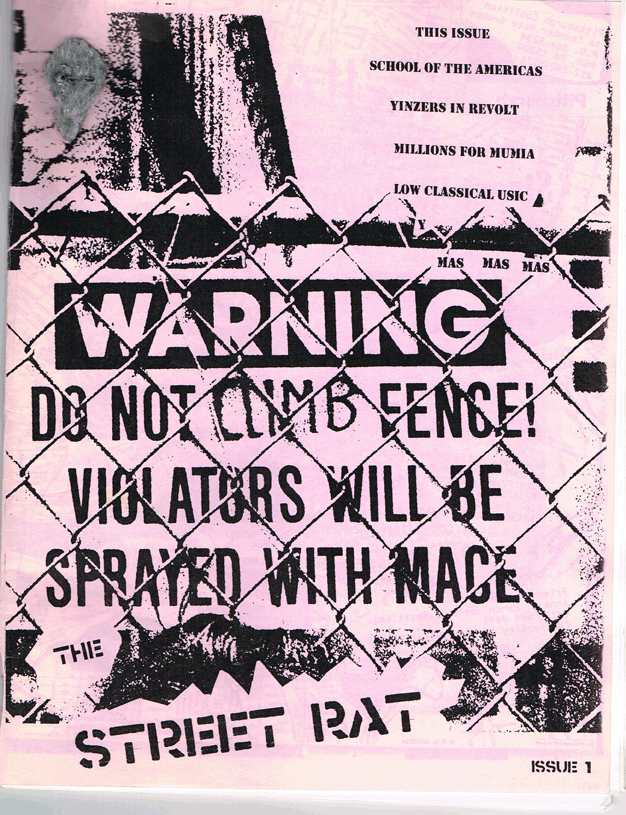
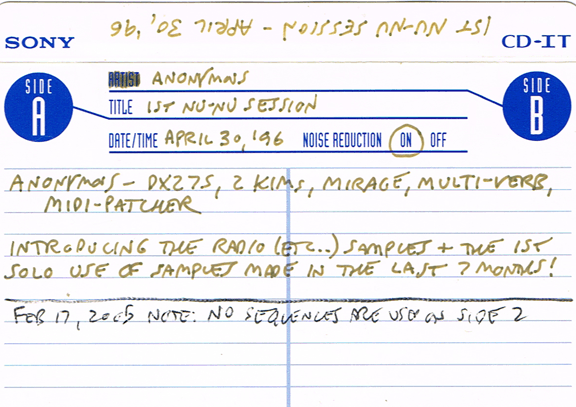
1996.04.30 1st NU-NU Session - NU-NU, Pittsburgh, us@
"NU-NU" was the name of the 1st house I lived in in Pittsburgh. I had 2 phone numbers, each of which deliberately were chosen to begin with "NU". This is recorded on a 74 minute tape. By this point I was using the name "Anonymous". I used the typical Triple-S Variety Show instruments. A note on the tape J-card reads: "Introducing the radio (etc..) samples + the 1st solo use of samples made in the last 7 months!" I made this Triple-S substantially different from what had preceeded - largely thanks to the new samples. A February 17, 2005 note-to-myself informs me that no sequences are used on Side B. The audio alone can be heard on my SoundCloud page here:
https://soundcloud.com/user-200009324/1st-nu-nu-triple-s-variety-show
It can also be heard as the sound track to this:
490. "Slow-Bowling with the Gods"
- thanks to the shooter of 110311_TUNAMI.avi.
- thanks to EC Films Stock Footage for the Bowling Strike
- thanks to John Sheehan for the idea of Slow-Bowling
- soundtrack: tENTATIVELY, a cONVENIENCE's 1st NU-NU Triple-S Variety Show (April 30, 1996)
- editing & effects: tENTATIVELY, a cONVENIENCE
- edit finished: June 4, 2017
- In memorium: 15,894 deaths, 6,152 injured, 2,562 people missing from the March 11, 2011 Tohoku earthquake and tsunami
- 720p HD 60p, Stereo
- 1:16:14
- on my onesownthoughts YouTube channel here: https://youtu.be/1O4ad4Fv7Zk
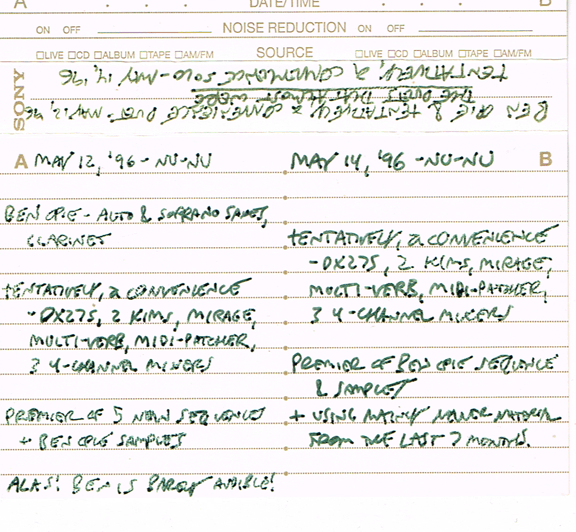
1996.05.12 1st duet with Ben Opie - NU-NU, Pittsburgh, us@
Before this session I recorded samples of Ben playing sax providing me with 16 short examples of timbral variety. These + 5 new sequences were incorporated into the duet. Ben played alto & soprano saxes & clarinet. I played the usual Triple-S electronics. Alas! Ben is barely audible in the recording!
1996.05.14 tENTATIVELY, a cONVENIENCE solo - NU-NU, Pittsburgh, us@
I had made a sequence with the Ben Opie samples since 2 days before & I premiered that as part of this session.
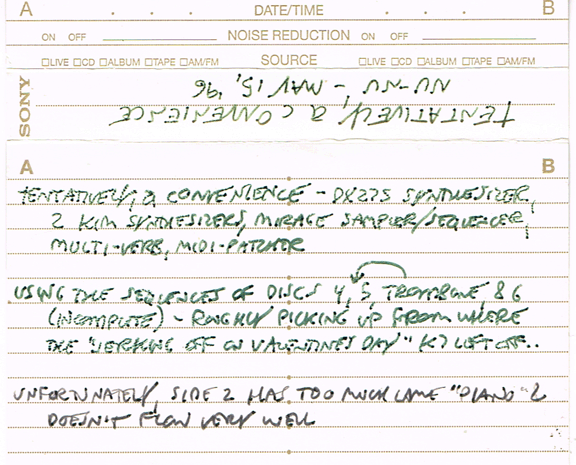
1996.05.15 tENTATIVELY, a cONVENIENCE solo - NU-NU, Pittsburgh, us@
"Using the sequences of discs 4, trombone, 5, & 6 (incomplete) - roughly picking up from where the "Jerking off on Valentine's Day" audio cassette left off..
"Unfortunately, Side 2 has too much lame "Piano" & doesn't flow very well"
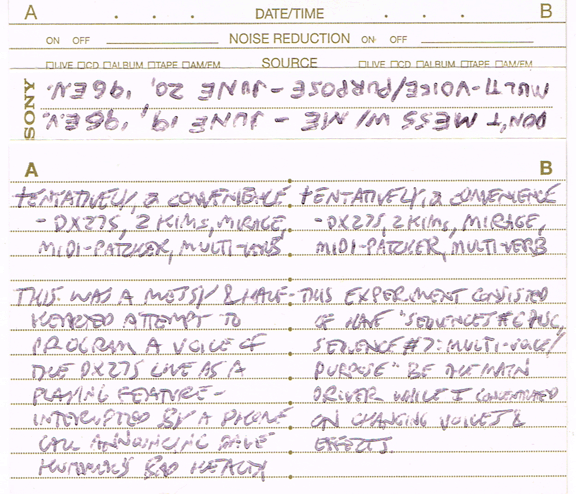
1996.06.19 "Don't Mess w/ Me" - NU-NU, Pittsburgh, us@
"This was a messy & half-hearted attempt to program a voice of the DX27S live as a playing feature - [interrupted] by a phone call announcing Dave Hummer's bad health": Dave Hummer was my oldest friend. I knew him since I was 3 & he was 2. The phone call would've been from my mother whose impeccable death trip personality is always ready to intrude. Around this time Dave was put in a nursing home. He died around 2001, 5 years later.
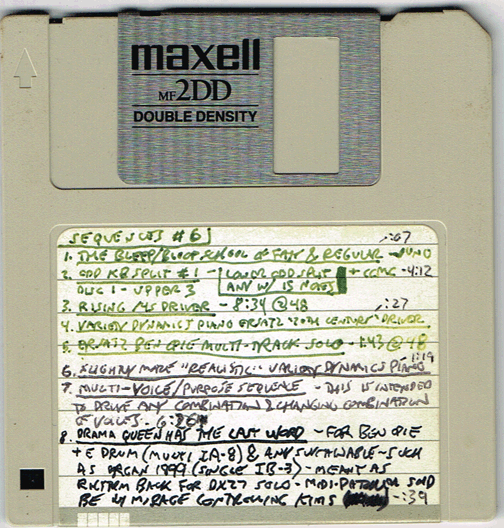
1996.06.20 Multi-Voice/Purpose - NU-NU, Pittsburgh, us@
"This experiment consisted of [having] "Sequences #6 disc, Sequence #7: Multi-Voice/Purpose Driver" be the main driver while I concentrated on changing Voices & Effects."

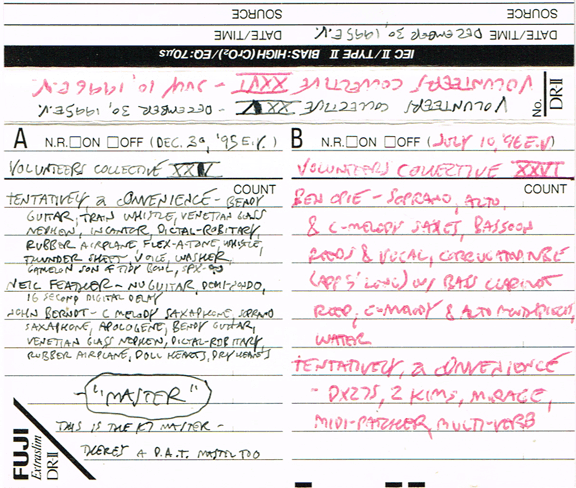
1996.07.10 Volunteers Collective XXVI - NU-NU, Pittsburgh, us@
This is the LAST of the Volunteers Collectives that I'll include on this Triple-S Variety Shows webpage. As with all the VC duets on which I used the Triple-S gear, the Triple-S material isn't as buried under a wall of free improv as it would be with a trio, or larger, group. This was the 1st duet Ben & I ever played. Ben Opie: soprano, alto, & C-melody saxes, bassoon reeds & vocal, corrugated tube (approximately 5' long) with bass clarinet reed, C-melody & alto mouthpieces, water; tENTATIVELY, a cONVENIENCE: DX27S, 2 K1ms, Mirage, MIDI-patcher, Multi-Verb. The next VC after this, XXVIII, on January 28, 1997, still used the Triple-S gear but introduced my use of the Performa computer. By that point, then times were really changing for me.
593. "Volunteers Collective XXVI"
- my 2nd duet with Ben Opie shot on July 10, 1996E.V. with a statis lo-def surveillance camera to VHS at NU-NU, Pittsburgh
- titling & effects finished on May 31, 2019E.V.
- 46:38
- on my onesownthoughts channel here: https://youtu.be/0L--0Faiq_Y

1996.07.14 An Attempt to Encapsulate Feb 14 '95 to Jul 14 '96 - NU-NU, Pittsburgh, us@
"This picks up where "Jerking Off on Valemtine's Day" [in other words, "Triple-S Variety Show - Volume 1"] left off. Despite some glitches, this is probably the best new summary?? - No, not yet.." The next tape, recorded 4 days later, must've met my criteria better because it's the one I published.
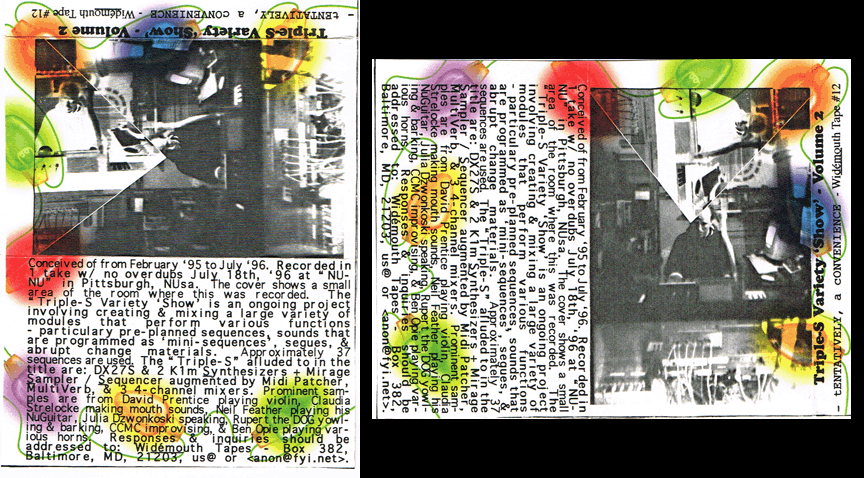
1996.07.18 Triple-S Variety 'Show' - Volume 2 - NU-NU, Pittsburgh, us@
The sequel, obviously, to "Volume 1". This tape is a 90 minute one, 10 minutes shorter than the 1st. The idea was to make the next volume 74 minutes, the 4th volume 60 minutes, & 1 5th volume 45 minutes. These days, getting any length tape in high quality is difficult but the 90s & the 60s are the easiest. As such, it's unlikely that I'll ever make any other volumes unless I make CDs or records.

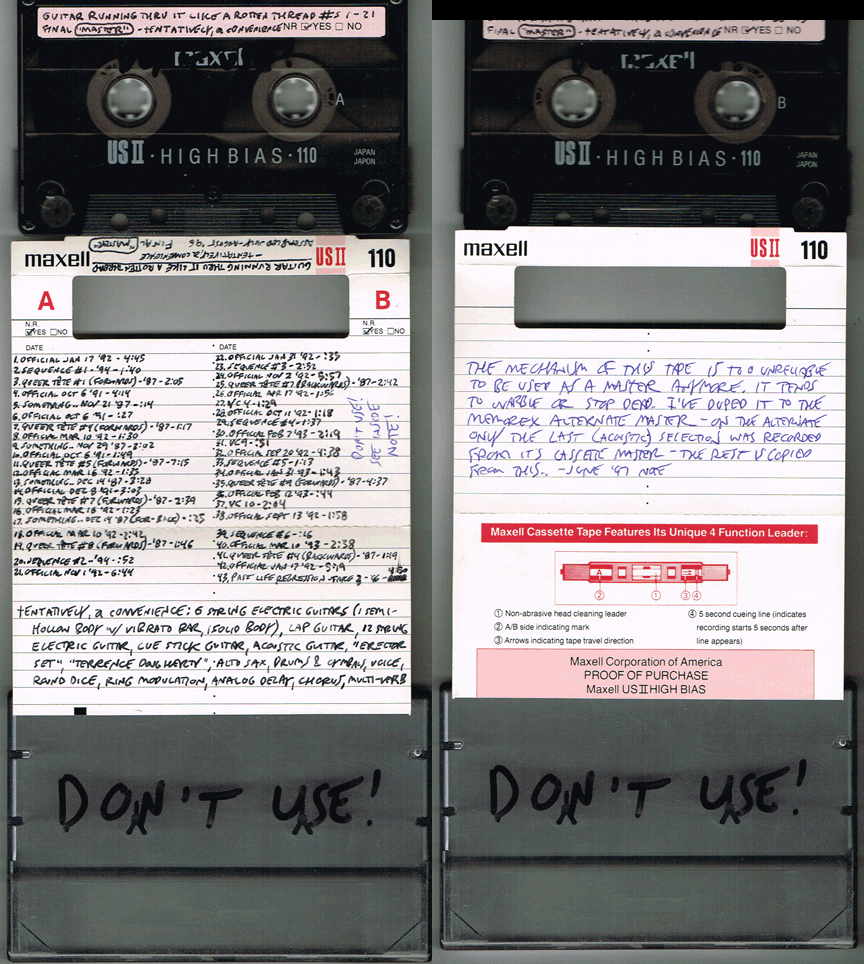

1996 "Guitar Running thru It Like a Rotten Thread" - NU-NU, Pittsburgh, us@
I moved to Pittsburgh with my girlfriend Sarah at the beginning of January, 1996. Sarah had an acoustic guitar & wanted to learn how to play it. Srudying music with me is not necessarily a good idea for anyone who wants to learn how to do it 'the way everyone esle does'. I started working on a guitar piece that would show different ways of playing the guitar. This turned into "Past Life Regression" - so-called because, for me, playing guitar was something I had long since basically stopped doing so it was as if it were from a previous lifetime. The result is that Sarah probably didn't learn much about strumming 1st position chords in common time. The result for me is that I started pulling out recordings of me playing guitar from my aRCHIVE & I chose 110 minutes's worth to publish as "Guitar Running thru it Like a Rotten Thread" - the name signifying that guitars are all over the place but the musical fabric that they hold together is often pretty shoddy. The tape used all 6 of the guitar sequences made for the "Triple-S Variety Shows".

1996.07 Sequences 1-32 recorded as seperate pieces - NU-NU, Pittsburgh, us@
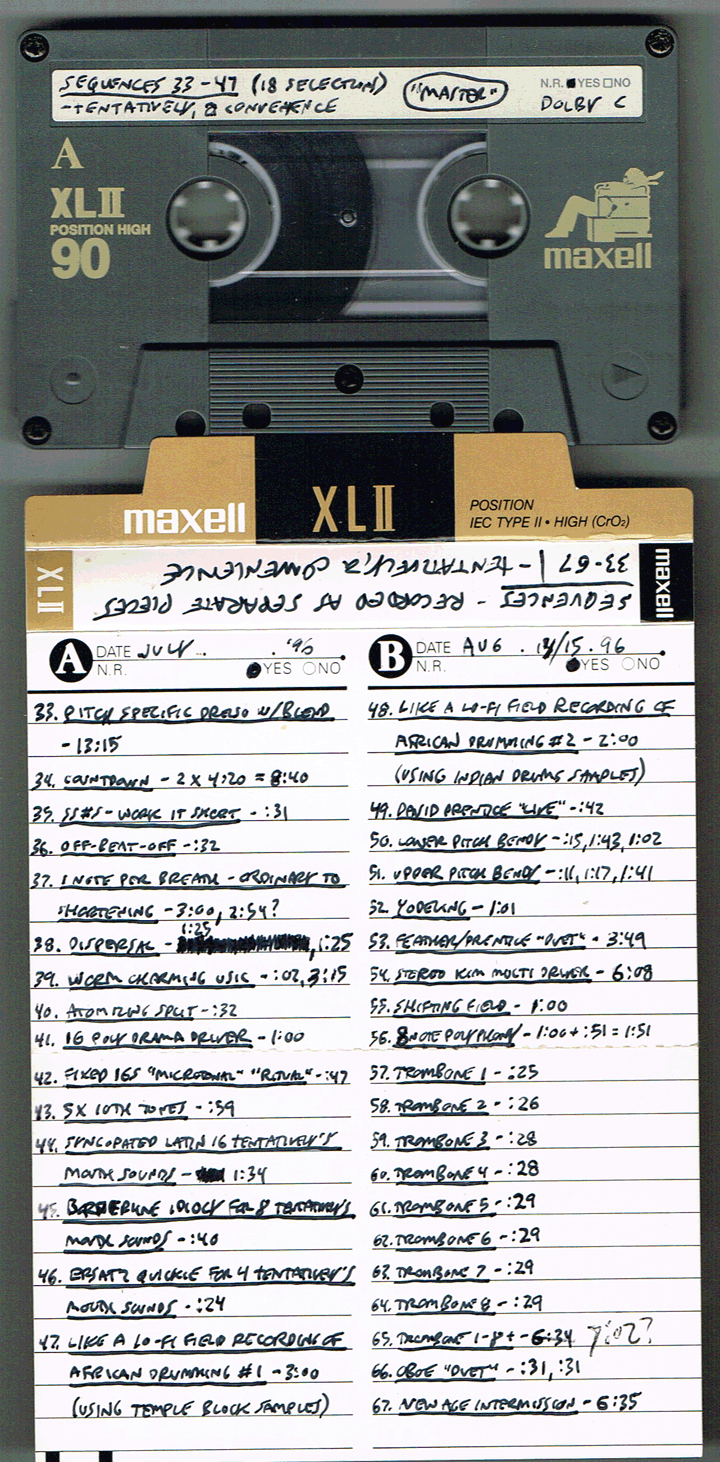
1996.07 / 08.13-15 Sequences 33-67 recorded as seperate pieces - NU-NU, Pittsburgh, us@
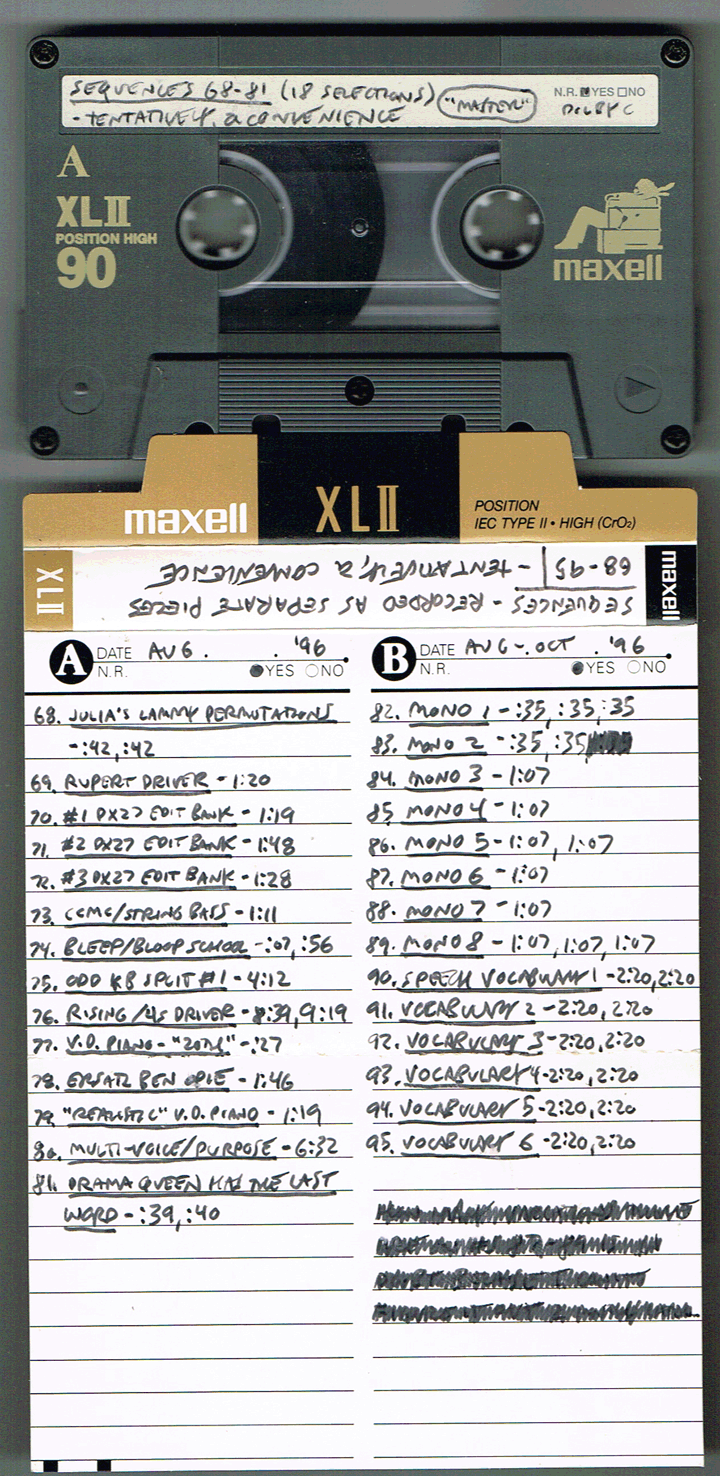
1996.08-10 Sequences 68-95 recorded as seperate pieces - NU-NU, Pittsburgh, us@
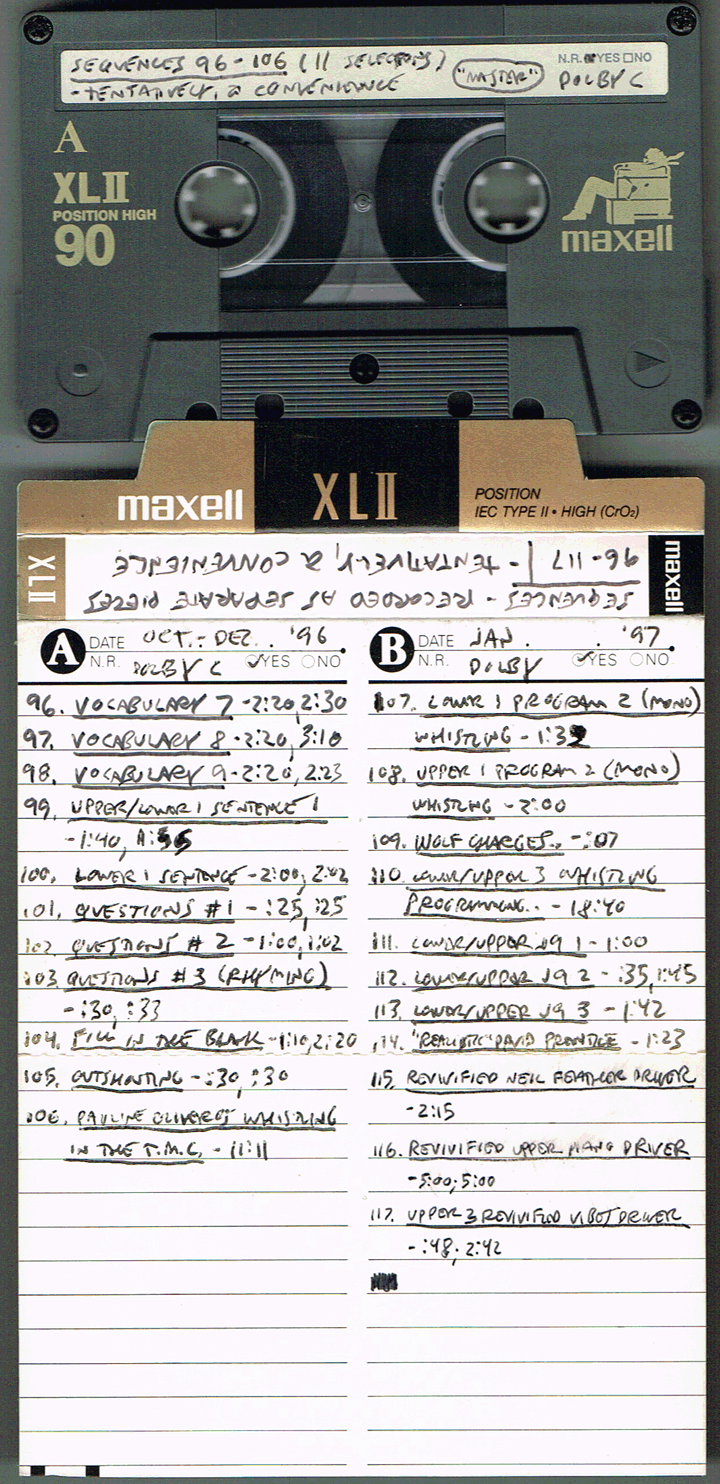
1996.10-12 / 1997.01 Sequences 96-117 recorded as seperate pieces - NU-NU, Pittsburgh, us@
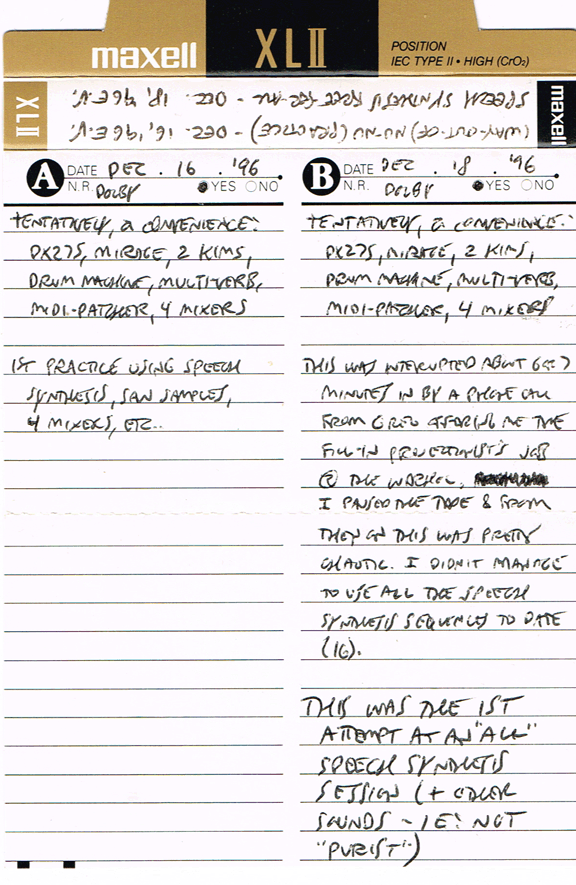
1996.12.16 (Way-Out-Of) NU-NU (Practice) - NU-NU, Pittsburgh, us@
"1st practice using speech synthesis, saw samples, 4 mixers, etc.."
1996.12.18 Speech Synthesis Free-for-All - NU-NU, Pittsburgh, us@
"The was inter[r]upted about 6 or 7 minutes in by a phone call from Greg [Pierce] offering me the fill-in projectionist's job @ the Warhol [Museum]. I paused the tape & from ten on this was pretty chaotic. I didn't manage to use all the speech synthesis sequences to date (16)."
For the record, this job netted me about $26 a week at 1st fro something like 4 hours on Saturday. I needed the income desperately so I was glad to get it but it was hardly a good deal. The good jobs go to family members. Croneyism only wins when nepotism has no-one to offer.
"This was the 1st attempt at an "all" speech synthesis session (+ other sounds - ie: not "purist")"
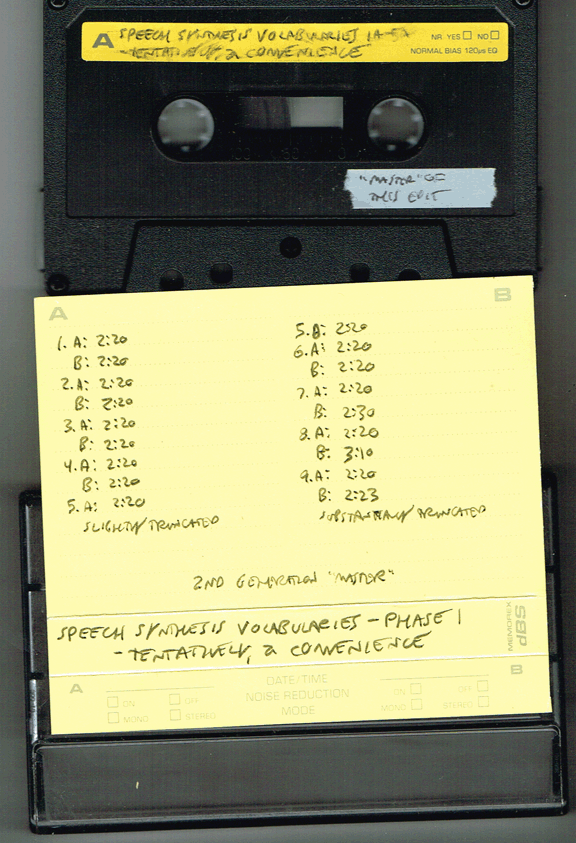
1996.12 Speech Synthesis Vocabularies - Phase 1 - NU-NU, Pittsburgh, us@

1997.01.02-03 Speech Synthesis, Whistling, & J9 Sequences Triple-S Variety Show & Tell - NU-NU, Pittsburgh, us@
"This was recorded basically from 11:15 PM -> 1:00 AM w/ a slight break between side flipping.
"Under-recording is the result of attempted compensation for drastic differences between the record deck & the playback deck in V.U. meter levels."

1997.01.04 Speech Synthesis, Whistling, & J9 - Take 2 - Part 1 - NU-NU, Pittsburgh, us@
"ist session using 127 pitch transpositions Multi-Verb sequence (via foot pedal) + "realistic" David Prentice solo sequence + 2 new K1m sounds: "It Depends" & "Cluster It""
1997.02.04 Speech Synthesis, Whistling, & J9 (+ Performa, etc..) - Take 2 - Part 2 - NU-NU, Pittsburgh, us@
"1st session using CDs - My Melody notes on M[usic]W[orks issues] 63 & 64 + Zippers on Audio Alchemy + 17-60 (programmed) of Dr. Nerve's "Beta 14 OK" + using computer to read texts (this latter was done previously during V.C. 28..)
"After making this tape I noticed that parts wch shd've been stereo &/or effected were mono & found a faulty Y-adaptor & an incorrect patch wch I replaced & corrected."
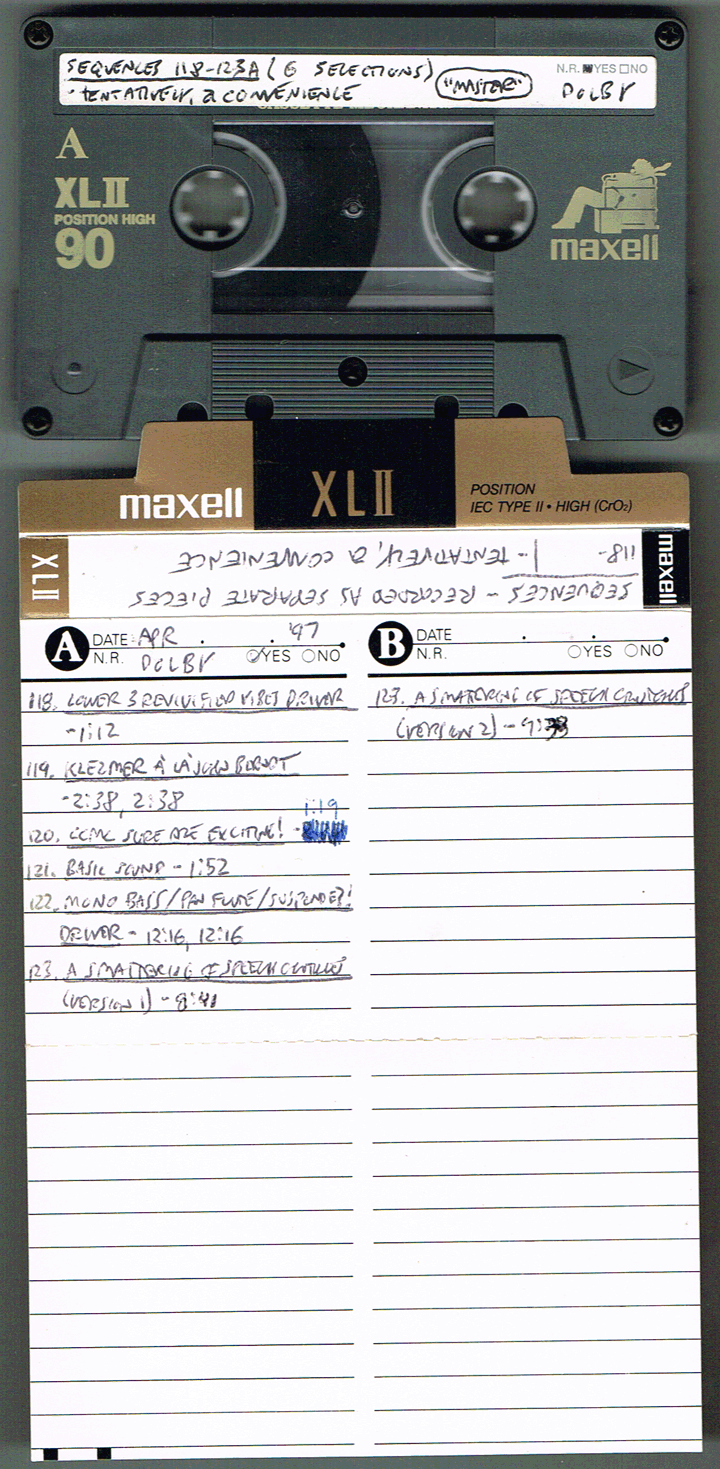
1997.04 Sequences 118-123 recorded as seperate pieces - NU-NU, Pittsburgh, us@
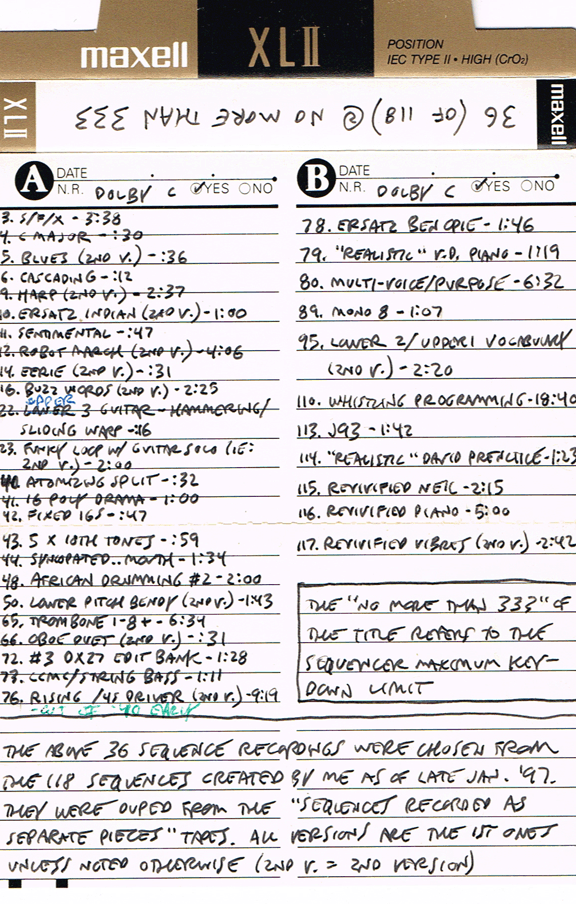
1997 36 (of 118) @ no more than 333 - NU-NU, Pittsburgh, us@
These tapes for which I made summaries of the sequences marked my summing-up period. I knew that the gear wouldn't last forever & that I wouldn't be able to perform this Triple-S Variety Show work much longer. Besides, of course, it was time to go in even newer directions.
By the time of Volunteers Collective XXVIII, January 28, 1997, I had gotten the surprise present of a Mac Performa tower computer from my friend & collaborator John Berndt. With the Performa I had the ability to do far more sophisticated sound editing than I'd ever been able to do before & to burn CD-Rs. I immediately started using it for those performances & as an instrument. I took advantage of its ability to read texts in a variety of voices, amongst many other things.
The gist of this being that I got further & further afield of the Triple-S Variety Shows. E.G.: On Saturday, April 5th, 1997, I performed a new piece of mine called "Lost in Translation" at the LatinAmeriMIX!can in The Welker Room at Chatham College, Pittsburgh, us@. For this, I'd created a text to be read using the computer voices (more about this can be seen here: http://idioideo.pleintekst.nl/W1997.LostInTranslation.html ) & something that I called the "Lost in Translation Magic Square" in SoundEdit16 which enabled me to select & loop timed sound materials. By 1999, when I performed with Monty Cantsin Amen! (Istvan Kantor) on Saturday, November 27, as part of the Neoist Festival at the Dairy in Windsor, Ontario, CacaNada, I was using a much more portable Casio digital horn as my controller instead of a keyboard & my Mirage sampler/sequencer was long-since broken. Nonetheless, ghost of the Triple-S appeared in various recordings & 'performances' in ensuing years:
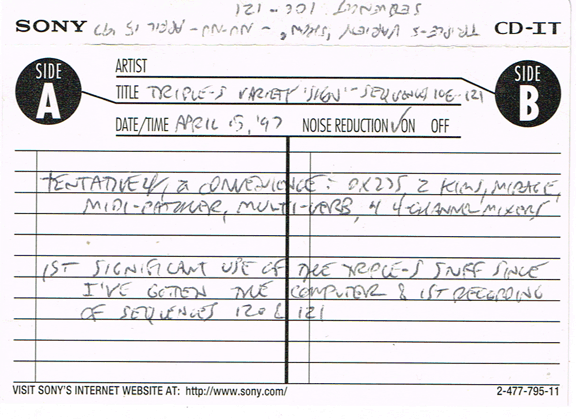
1997.04.15 Triple-S Variety 'Show' - NU-NU, Pittsburgh, us@
"1st significant use of the Triple-S stuff since I've gotten the computer & 1st recording of sequences 120 & 121"
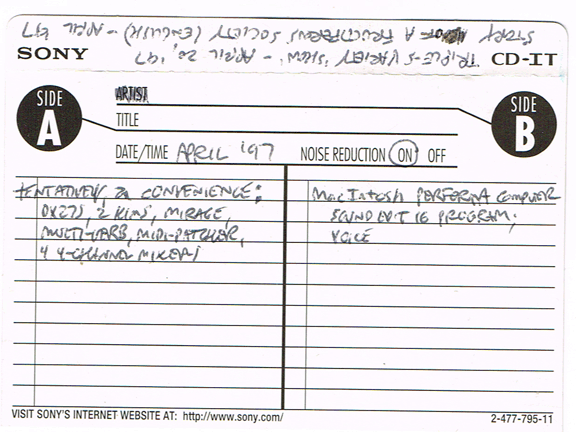
1997.04.20 Triple-S Variety 'Show' - NU-NU, Pittsburgh, us@
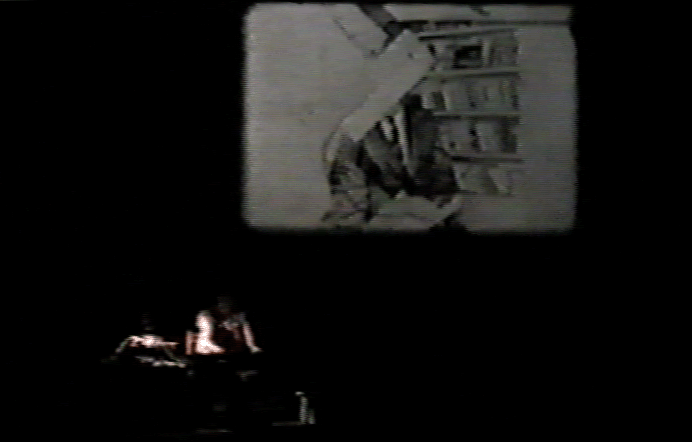
"Bob Cobbing", the 1st half of "Hypnopedagogy", presented with a quasi-Triple-S Variety Show live soundtrack performed by tENTATIVELY, a cONVENIENCE on July 5, 1997, at the Culture Center in Vác, Hungary
1997.07.05 Triple-S Variety 'Show' - XXXPanzio A Neoizmus?! Anti-Esemény / XXXPanzio In the Name of Neoism?! Anti-Event - Madách Imre Müvelódési Központ / Culture Center, Vác, Hungary
I went to Hungary for multiple Neoist festivals in 3 different cities. My transportation from Pittsburgh to Hungary was at my own expense so I was unable to afford to take my keyboard. I didn't have the breath-controller yet. As such, I was working in a highly restricted way. There were multiple Uncerts in which I played electronics, in one case with a borrowed keyboard that I had problems with, so I'll restrict myself to just listing this one & the keyboard one as "Triple-S Variety'Shows'". I played while my 16mm film "Bob Cobbing" was projected. A very brief snippet of that can be witnnesed here (Thanks to Brian Damage for footage): https://youtu.be/QBTFTpscd4M?t=3841 . The incorporation of the film's soundtrack & my limited control over my devices made this more 'noisy' than Triple-S-like.
147. a. "Bob Cobbing/Movie Trivia/Hypnopedagogy"
- 16mm -> 1/2" VHS cassette (single layer fish-eye transfer w/ white spandex screen)
- 28:30 or 57:00
- '91-'93
- on my onesownthoughts YouTube channel here: https://youtu.be/OsqqA7MwdL4
b. "Bob Cobbing/Movie Trivia/Hypnopedagogy"
- 16mm (double layer optical print)
- 29:45 or 59:30
- '91-'94
- actually 58:26 in the following:
- on my onesownthoughts YouTube channel here: https://youtu.be/bRxG1rc50bM
- on the Internet Archive here: https://archive.org/details/BobCobbing
- tENTATIVELY, a cONVENIENCE Movieography
1997.07.08 Uncert with Dóra Attila - Neoista?! Puccs Tilos Rádio Party - Orczy Kert / Orczy Park Hall, (Buda)Pest, Hungary
"Dóra Attila's a Hungarian improvising wind player. On the main stage of a huge auditorium that had 3 large scaffolds as alternative stages we played a set. I had a video-projection of some of my "Concrete Mixing Vaudeo #2" (a fast encapsulation of many of my movies) showing both on the partially lowered corrugated metal garage-type door at the front of the stage & onto the back wall behind the stage. Under these conditions, the images were barely decipherable & the video became more of a light show. Attila played soprano sax, Turkish clarinet, & trombone with a reed mouthpiece. I took my zipper pants off & wore them as a shirt. During a sortof 'film noir jazzy' part made from CCMC samples, I sang in a sortof 'childish' 'Betty Boop" type voice something like this: "Hewwo, everybody. I'm Monty Cantsin & I'm going to sing a wery, wery, wery special song. It's for you, & you, & you , & YOU! & it goes something like this: doopie-doo, doodie-woo-be-doopie-doobie-doo-doo. Thank you." Due to electrical problems, my equipment started going haywire. As such, my sampler/sequencer, midi-patcher, & effects unit were all disabled. I was only using 2 K1 module synthesizers erratically controlled by a borrowed keyboard & tapes. It was swell." - Mere Outline 1997
A very brief snippet of that can be witnnesed here (Thanks to Jubal Brown for footage): https://youtu.be/QBTFTpscd4M?t=4250 .
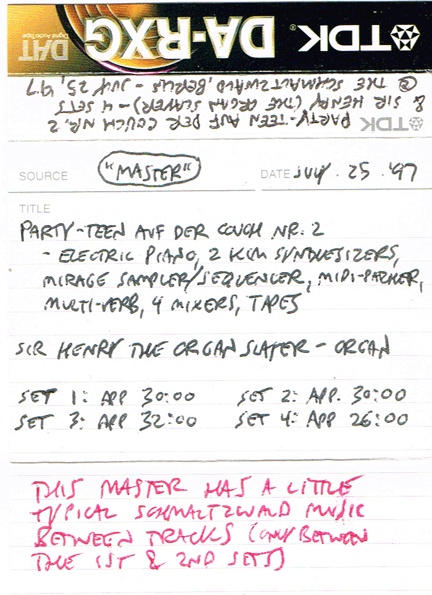
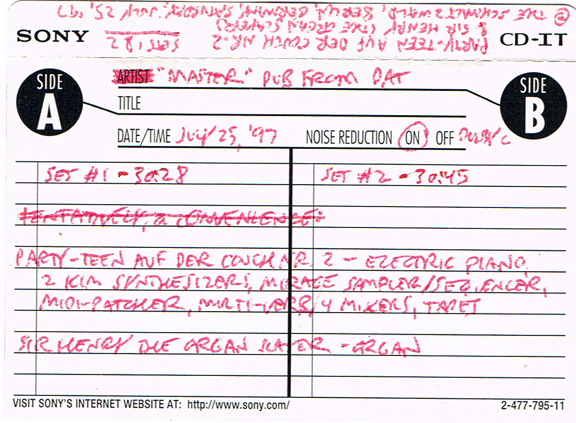
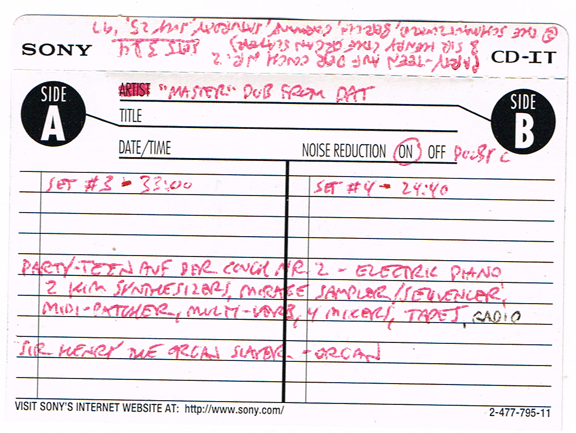
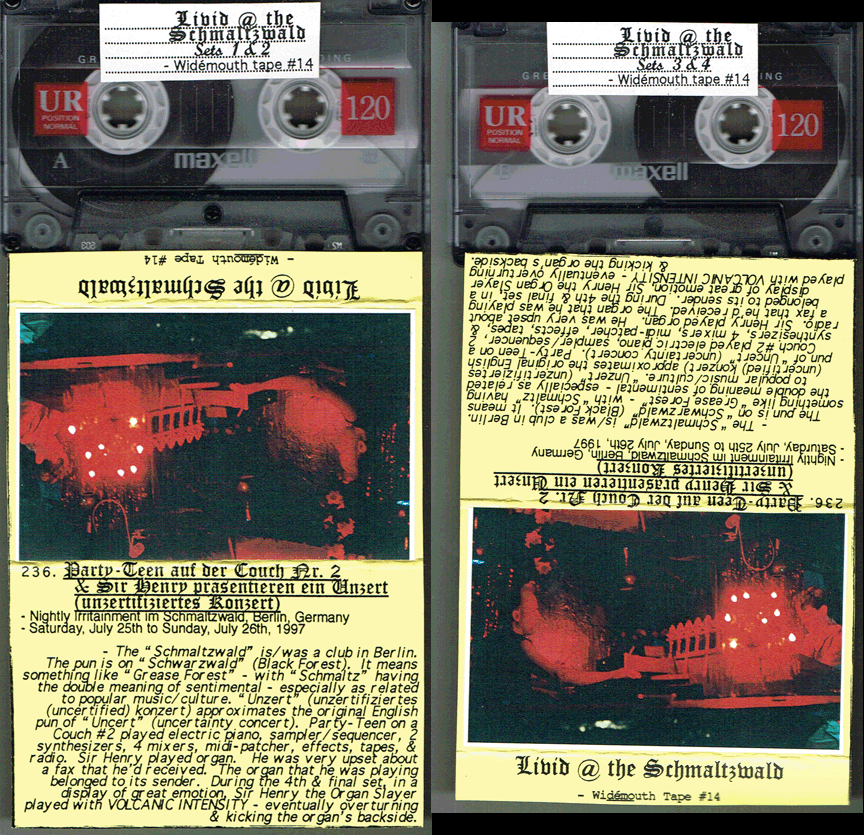
1997.07.26 Livid @ the Schmatlzwald - Nightly Irritainment im Schmaltzwald, Berlin, Germany
Once again, I got the opportunity to play with the phenomenal John Henry Nyenhuis. Classifying this as a "Triple-S Variety Show" is pushing things a bit but I was playing the sequences & had most of my gear with me + a nice electric piano that John Henry made available to me while he played organ. Unlike the Hungarian gigs, which were usually pretty messy, this was a particularly nice Uncert that I enjoyed enormously.
"242. Party-Teen auf der Couch Nr. 2 & Sir Henry präsentieren ein Unzert (unzertifiziertes Konzert)
- Nightly Irritainment im Schmaltzwald, Prater, Berlin, Germany
- Saturday, July 26th, 1997, 11:15PM to Sunday, July 26th, 1997, 3AM
- After seeing a film entitled "Scream" & noting that 1 of the otherwise unnamed characters was identified in the credits as something like "party teen on couch", I was inspired by this typical movie credit practice of identifying unnamed extras with descriptions. Hence, I took on the new name of "Party Teen on Couch #2" - which Florian Cramer was kind enough to translate into German for me. John Henry Nyenhuis, with whom I've collaborated as part of Klauhütte Bangzeit 200(0) (see entries #190 & 192) & independently from that group (see entry #199), was living in Berlin as the organist (now named "Sir Henry") for the Schmaltzwald & he & I decided to present an uncert together. The "Schmaltzwald", for those of you who don't understand German, is a pun based on "Schwarzwald" (Black Forest). "Schmaltzwald" meaning something like "Grease Forest" - with "Schmaltz" having the double meaning of overly sentimental (or some such) - especially as related to popular music/culture (just as "Grease" in the US might refer to 1950's popular culture). Florian translated "Uncert" to "Unzert" to make a pun combining "unzertifiziertes" (uncertified) with "konzert" - approximating the original English portmanteau word combining "uncertainty" (or "Uncertainty Principle") with "concert". I presented vaudeos & films & played electric piano, sampler/sequencer, 2 synthesizers, 4 mixers, midi-patcher, effects, tapes, & radio. Sir Henry played organ. We played 4 approximately half-hour sets & I presented 16mm films in between them: "How Orgone Cinema Treats Its Visiting Filmmakers", "Funny Farm Summit Meeting" (particularly appropriate since the Schmaltzwald is largely the creation of Laura Kikauka - who also created the Funny Farm), & "Subtitles (16mm version)". John Henry was very upset about a fax that he'd received from 1 of the Schmaltzwald's personnel in which he was basically accused of being a traitor. The organ that he was playing belonged to the sender of the fax. During the 4th & final set, in a display of great emotion as response to this fax (& the events that had led up to it), John played the organ with VOLCANIC INTENSITY - eventually overturning the organ & kicking its backside. The audience loved it - reminding me of how popular smashing instruments is in rock'n'roll. This led to my renaming him "Sir Henry the Organ Slayer"" - Mere Outline 1997
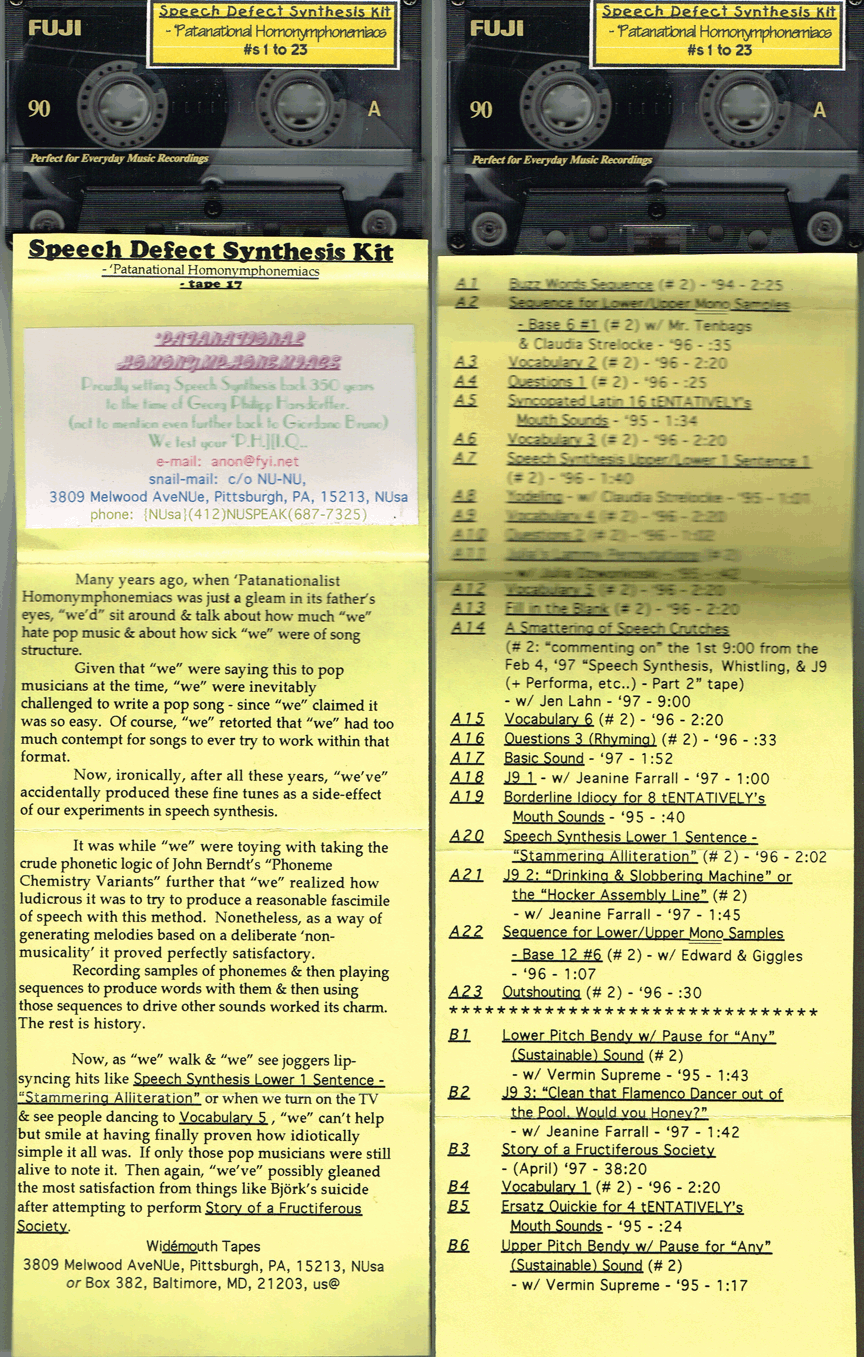
1997 "Speeech Defect Synthesis Kit" - NU-NU, Pittsburgh, us@
This is my summary of all the Speech Synthesis experiments with both sampling voices & sequences. Making this a "Speech DEFECT Synthesis Kit" is, I imagone obviously, both a play off of what speech synthesis researchers definitely DON'T want to do as well as a jab at the funkiness of the procedures used by myself.
1999.11.29 Arts Focus Radio Show - Post-Neoist Festival, CJAM Radio Station, Windsor, Ontario, CacaNada
As with my duet with Monty Cantsin Amen! (Istvan Kantor) at the Neoist Festival, this was as much an outgrowth of the previously mentioned "Lost in Translation Magic Square" as it was "Triple-S Variety Show" but there are still enough traces left to include it here. This is further reinforced by this being solo.
"277. Arts Focus Radio Show
- Post-Neoist Festival, CJAM Radio Station, Windsor, Ontario, CacaNada
- Monday, November 29, 1999
- This was actually recorded on the previous Friday But since it didn't air 'til this day I place it here. I played 2 improvisations using the synthesizer, sampler, sequencer, CDs, & digital horn mentioned in 273. Interspersed with those were excerpts from my "Low Classical Usic" & "RATical RATio - pRAT 1" CDs + Owen O'Toole's "What Balcony" CD. I also made a plug supporting the Maki family who are political refugees from the US in CacaNada who are facing expulsion." - Mere Outline 1999
An excerpt from his can be heard online on the Internet Archive as part of "Radio 1999" here: https://archive.org/details/Radio1999/1999.11.29aArtsFocusWindsor-Pt1.mp3

2000.01-02 4 Games of Black Rectangle over the Eye - 1st two in January @ Alex Van Ness's house, Baltimore, us@
I'm always somewhat astounded at how fortunate I am to have so many excellent collaborators willing to take my eccentric projects so seriously. My collaborator on this, John Dierker, an excellent tenor saxophonist is usually busy with multiple bands & yet he could give me his time for 3 rehearsals: 2 in January & 1 in February. I'm listening to the 1st of these now. I no longer lived in BalTimOre at this time but I spent a few months every year from 1994 to 2004 working there for the MD Science Center. Alex Van Ness was one of my coworkers. You can witness footage of us working together in my movie "Living a Making". The 1st rehearsal here sounds much more like a Triple-S Variety Show than the ultimate performance did. It's heavily based around the playing of sequences & John seems to be familiarizing himself with by playing along with them. This was probably the only time I tried teaching the material to a collaboartor so that they'd have something more than spontaneity to go on. That's something I should've done more often. Somewhere in my vast aRCHIVE I probably still have the relevant papers that John & I would've been working off of. Those would be interesting to scan & place here. Unfortunately, unlike with most of my projects, I don't have the slightest idea where to look.
I would've had my Casio breath-controller by this point but I seem to be mainly concentrating on a CD player that had recordings of sequences. I seem to've been using the CD player so that I could play the Mirage sequences AND sequences on CD - that way I could have 2 sequences playing at once. Just as I wrote that, the Casio came in. I must've been developing the idea for this piece as we rehearsed it. I remember building the screen that we were to be protruding from while I was in BalTimOre. It probably wasn't ready until the 3rd rehearsal, the "dress rehearsal".
Listening to the 2nd rehearsal now, it's obviously more specifically formed than the 1st. It starts off with 'melancholic' breath-controller playing that takes some advantage of the volume control possible. Once the sequences come in they seem more deliberate & less of a pot-pourri. John takes a while to enter & he continues the 'melancholic' sound I'd started. The whole thing sounds much more pirposeful.
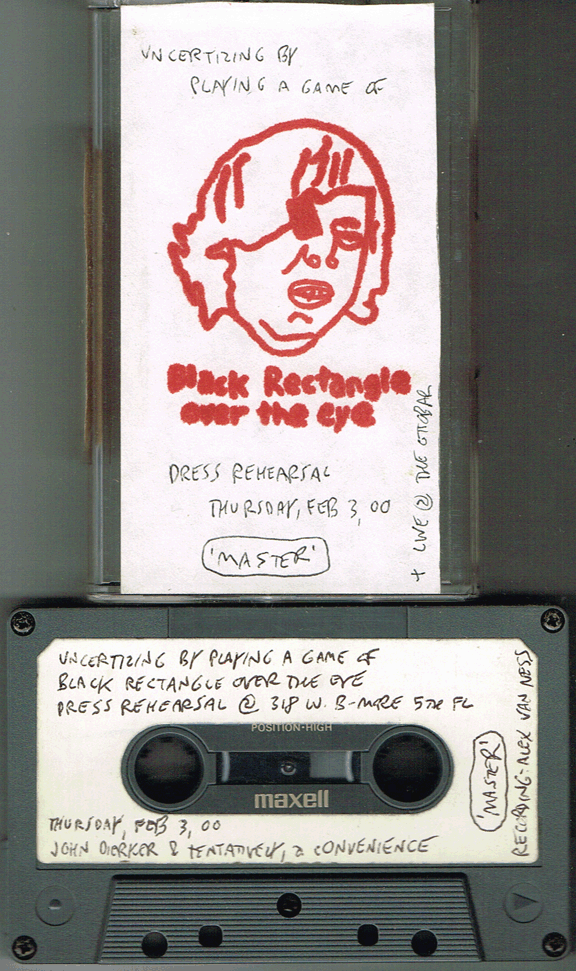
2000.02.03 Uncertizing by Playing a Game of Black Rectangle over the Eye - Dress rehearsal - 318 W. BalTimOre St., Baltimore, us@
It's interesting listening to the 3 rehearsals back-to-back.. I was impressed by #2 & I might like #3 even more except that the recording quality seems a bit muffled. Alex Van Ness recorded the 1st 2 rehersals direct-to-computer but this 3rd one was recorded direct-to-tape. Maybe that's why it seems inclear to me. Still, the piece itself has a special feel to it, I like it. It's 'atmospheric' in a way that most of my work isn't. There's the feeling of a journey to it for me. I introduce the most discombobulated part of the "Lost in Translation" text ( http://idioideo.pleintekst.nl/W1997.LostInTranslation.html ) here that I also used in the Ottobar performance. Unlike the 3 main predeccesor side-projects to the main Triple-S thrust, this is very fanciful, somewhat 'imagistic' - relying (m)usically somewhat heavily on the modd set by the finessing of the breath controller.
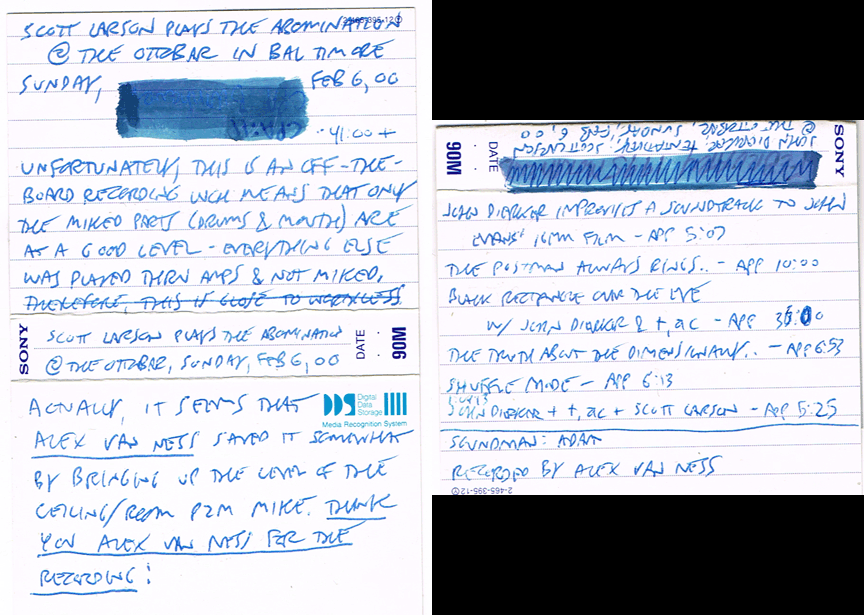
2000.02.06 Making Odd-Ball Sports History by Uncertizing by Playing a Game of Black Rectangle over the Eye - Ottobar, Baltimore, us@
As with things like "Vexations", "Bogus Piano Concerto", & "Mood Elevator Muzak for that Exhausting One Hour Work Week of the Near Future (& Variations)" this was more of a side-project of the "Triple-S Variety Shows" than a full-on Triple-S all by its lonesome. Once again, only having one collaborator, John Dierker, made it not completely disrupted from Triple-S origins. Listening to it again after not having done so for a long time I'm a bit amazed at how much I like it. If it were program music it would be a sort of Surrealist fairy tale. I'm not sure I've ever heard anything 'like it'. An apparently abridged version of this is on my onesownthoughts YouTube channel here: https://youtu.be/QBTFTpscd4M?t=5821
"278. Making Odd-Ball Sports History by Uncertizing by Playing a Game of Black Rectangle over the Eye
- Ottobar, Baltimore, us@
- Sunday, February 6, 2000, 10:30-1:00PM
- I organized this evening. I had a self-inking rubber-stamp made with an image of a boy's face with a black rectangle over his eye taken from my filmstrip entitled "The Postman Always Rings the Homunculous of Woody Allen & Hollis Frampton, Twice" with "Black Rectangle over the eye" written underneath it. I rubber-stamped this around downtown Baltimore & near & in the Ottobar to subtly establish the image & the "game" name in advance.
The program began with Scott Larson playing his one-man band "Abomination". I had made an 8'X8' white Spandex screen for rear projecting onto & this was erected at the front of the stage at a slight angle. John Evans then projected a 16mm film of his by bouncing the projection off a mirror so the image could be larger than the shallow stage depth would've otherwise allowed. John Dierker improvised a tenor sax soundtrack to the film, which was otherwise silent.
"Black Rectangle over the eye" was introduced thru a screening of "The Postman.." filmstrip & a pamphlet relevant to the strip was handed out to the vaudience by etta cetera (a.k.a. etta cetera & Rita Rodentia - see most of the recent entries - starting at 212 with etta cetera mention).
Midway up the screen on either side were 2 2' slits for John Dierker & myself to stick our torsos out of from behind. Wearing rubber costume versions of towering Thai hats, I explained something like "that there's nothing like wearing ersatz Thai hats to make me feel like playing a game of Black Rectangle.." & we began. I played a digital horn controlling a wave-table synthesizer & played a loop on a CD that I'd specially contructed for such purposes. etta rear-projected the "Where We're" filmstrip (mentioned in 274) in the upper middle of the screen (without its soundtrack). John Evans projected my 16mm film "How Orgone Cinema Treats its Visiting Filmmakers" overtop my head - following the same projection technique used in the Music Gallery premier of John Henry Nyenhuis' & my "Bogus Piano Concerto" (see entry 199). John Dierker played tenor sax. This "game" was in 17 parts & John D had specific pitch sets & styles to play in during parts 2-9 after which he could play mostly free-form. At the entry to the 3rd part, Dave Scheper began shining a flashlight around & thru his "Codzilla" sculpture to shadow-project on the entire screen. This is a "junk-metal" sculpture of something resembling a codfish skeleton standing about 5' tall on its tail. The shadow was very dramatic & dynamic. Highlights of this were when etta cetera confronted Codzilla with a hand-shadow of a dog profile & when she 'fed' Codzilla a beer. At various points, John D & I would take black rectangles of tape & place them above our eyes - sometimes acting as if we were somehow 'triumphant' - such as by raising a fist & shouting "YEAH!". At the end, I announced that John D had won the game.
This was followed by a projection of etta's "The Truth About the Dimensionally Challenged" & then by my "Shuffle Mode" (in filmstrip versions). The evening ended with a trio improv played by Scott, John D, & myself." - Mere Outline 2000
In 2000 (aka "the year '000") etta cetera & I went to Malaysia (briefly) & Australia (aka "AUS", pronounced "OZ") for 3 months. We were VERY busy in various areas. I made a movie of the trip that's 8:24:43 long which is one of my favorite movies. It's unlisted on my onesownthoughts YouTube channel here: https://youtu.be/kODzM_2_bRM . Once back in the 'Burgh, I edited together 8 CD-R compilations (or more if one considers that there were variations) & 'published' them in very small editions like 10 or 20 & gave them to a few friends.
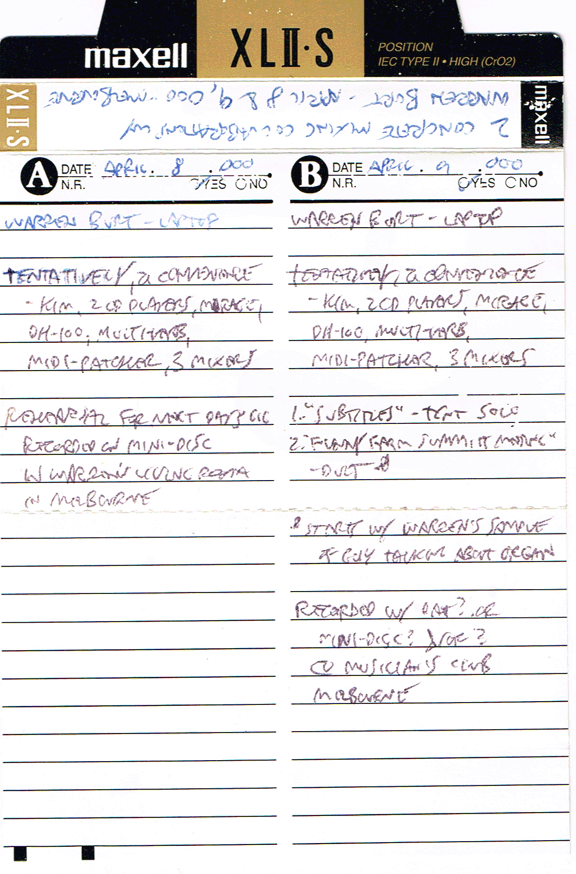
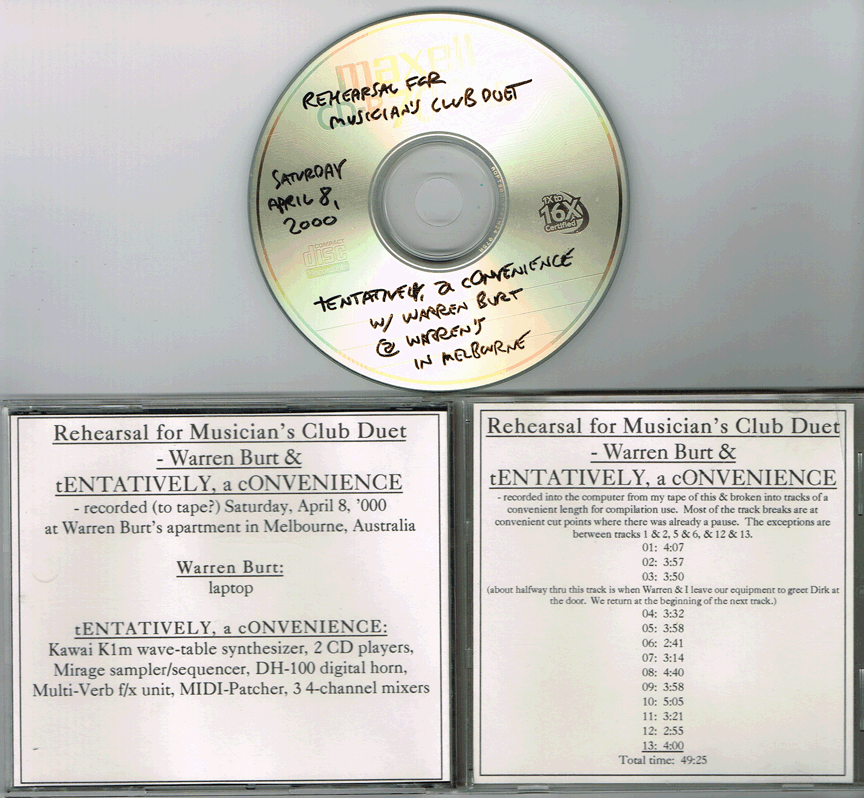
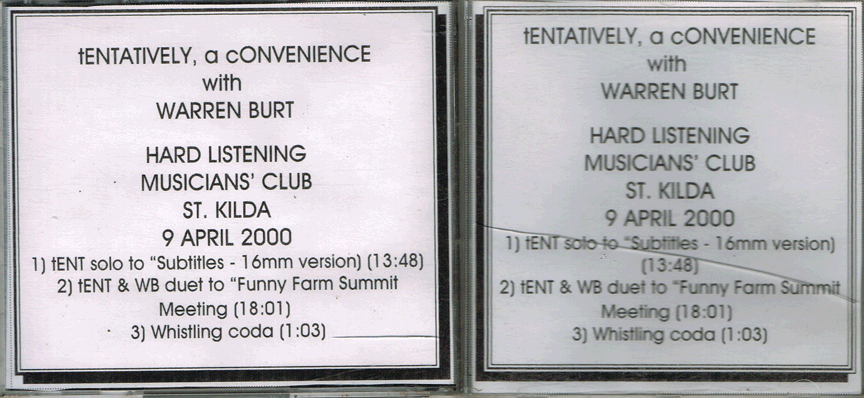
2000.04.09 Hard Listening - Musician's Club, Melbourne, Australia
"289. Hard Listening
- Musician's Club, Melbourne, Australia
- Sunday, April 9, 2000
- The "Hard Listening" series is a series of "new music concerts" (or some such) organized by Aemon Sprod every Sunday night at the Musician's Club. I had asked for a video projector but Aemon was unable to provide one so I had to change my plan at the last minute. 1st I screened 2 16mm films of mine: "Diszey Spots" & "How Orgone Cinema Treats Its Visiting Filmmakers". This was followed by my walking thru the audience whistling (without any announcement that this was part of the presentation) for a few minutes. I reached my electronics & started playing a whistling sequence & then started playing other sounds & my film "Subtitles (16mm version)" was screened. I was playing a DH-100 Digital Horn, a Mirage Sampler/Sequencer, a Kawai K1m wave-table synthesizer, a Multi-Verb f/x unit, a MIDI-Patcher, 2 CD Players, & 3 Mixers. The CDs being played were made especially for uncertizing purposes & consisted of miscellaneous s/f/x & such-like meant to be played in shuffle mode + all of my sequences in various versions, etc.. After "Subtitles" ended, I was joined by Warren Burt on laptop while my 16mm film "Funny Farm Summit Meeting" screened. Warren started this section by playing a sample saying: "Jack, that organ over there looks like it requires a jet pilot's license to operate it. Who's the musician in the family?". I chose to begin with this sample that Warren had recorded because it seemed to've come from a kitsch culture source similar to ones that the Funny Farm contained in the thousands & because Warren & I were playing with a large amount of technical resources at our control. Warren & I had rehearsed once for this gig but this was our 1st public presentation together. Our portion of the night ended with our wandering into the audience whistling while one of my whistling sequences played again.
All of the footage shot in Australia during this tour with Warren Burt in it is on my onesownthoughts YouTube channel here: https://youtu.be/TiCYlcBm5nM , this entire Uncert starts here: https://youtu.be/TiCYlcBm5nM?t=51m5s , the rehearsal for it starts here: https://youtu.be/TiCYlcBm5nM" - Mere Outline 2000
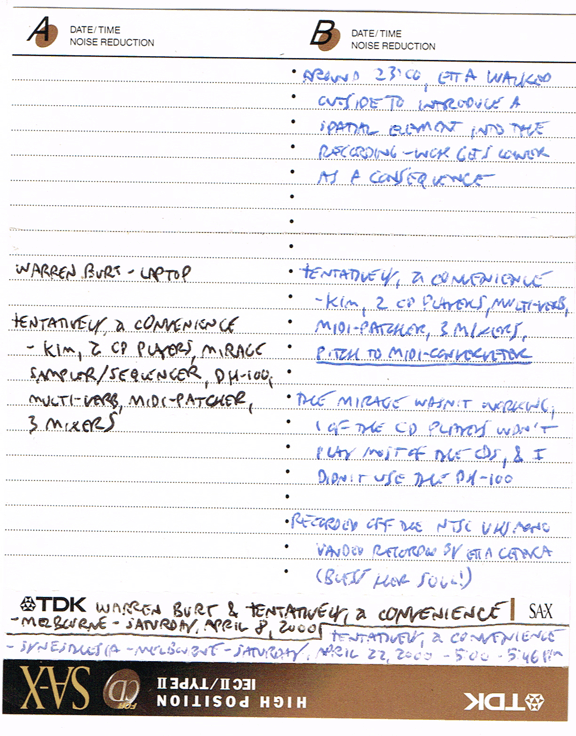
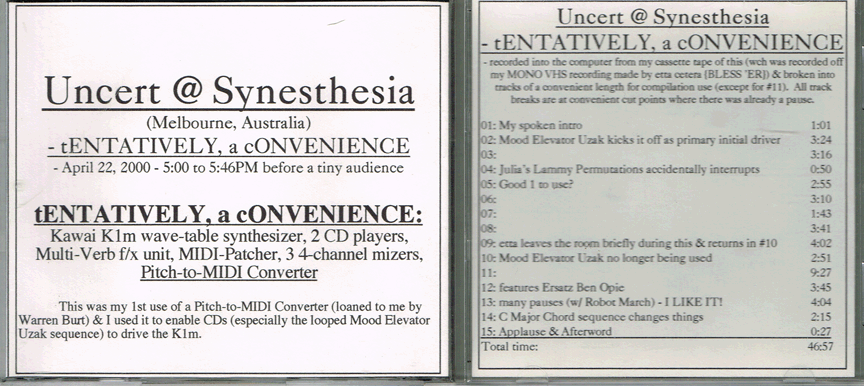
2000.04.22 Uncert - Synesthesia Record Store, Melbourner, Australia
"[292. Uncert
- Synesthesia Record Store, Melbourne, Australia
- Saturday, April 22, 2000
- Warren Burt (see entries 287, 288, & 289) had arranged for me to play at this record store. As with 287, I had asked for a video projector - but Mark Harwood, the store's owner, was unable to provide one. He seemed to also be unable to provide even a sign announcing that I would be playing. Since I was playing for free, I was hoping for a little more effort on his part. I had asked him when I should come to start setting up & I arrived promptly at the time. Unfortunately, Mark seemed to have a little difficulty with my setting up that early. In the VERY SMALL SPACE, one of the few customers in the space insisted on being in my way throughout the entire time as he insisted upon playing excerpts from every record in the store. Whether he ended up buying any of them I'm not sure. He sure liked those "cool covers" though - even if he didn't have any ideas beyond imbecility about music. My sampler/sequencer wasn't working & one of my CD players had ceased to work & the one I'd borrowed from Warren would only play 2 of my CDs. In other words, this whole thing would've been completely depressing EXCEPT that Warren loaned me his Pitch-to-MIDI converter. The result was my getting a chance to experiment in ways that I'd never been able to before. The gig was rescued. I started off by playing a CD version of my "Mood Elevator Uzak.." sequence fed into the converter to control my Kawai K1m wave-table synthesizer. Concrete Mixing galore. When it was over I was still quite happy to get the fuck out of Dodge. All of the CDs for sale there were too expensive for me & Mark sure wasn't offering to give me anything for free. I'll never play there again - that's FER sure!]
- an abridged edit of this is on Vimeo here: https://vimeo.com/240031833" - Mere Outline 2000
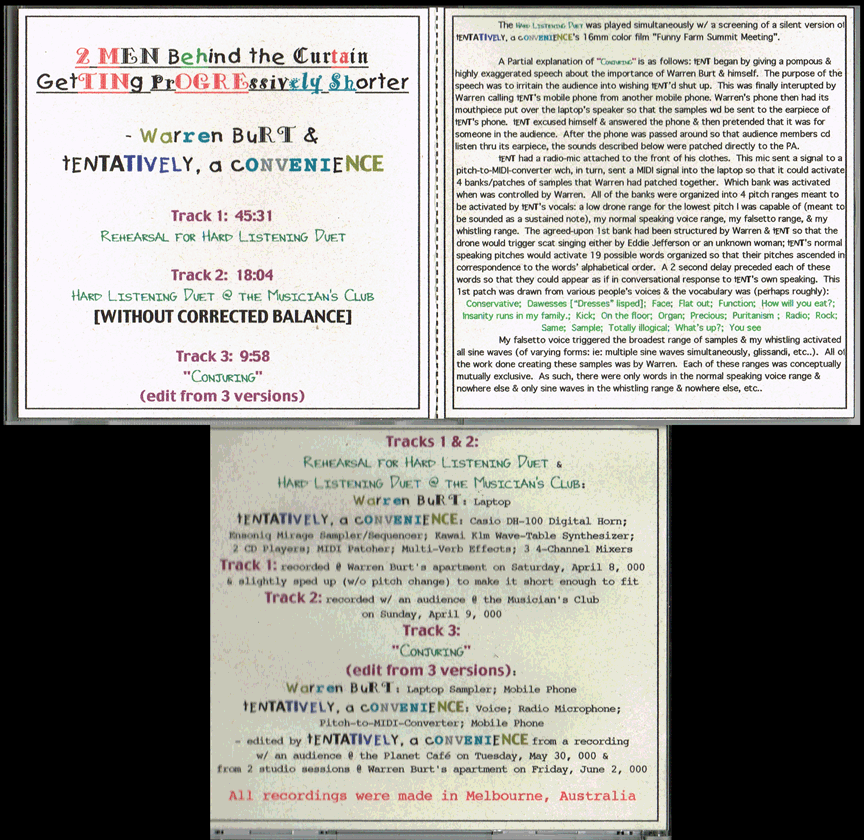
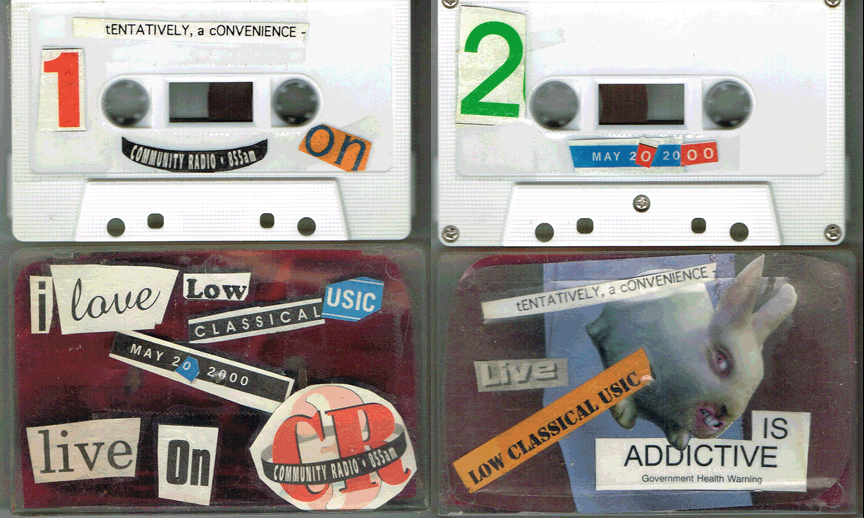
2000.05.20 Let Your Freak Flag Fly - 3CR Radio Station, Melbourne, Australia
"[297. Let Your Freak Flag Fly
- 3CR Radio Station, Melbourne, Australia
- Saturday, May 20, 2000, 6:30-7:30PM
- Michael, our friend who's the sidekick for "Anarchist World in Review" (see 291 & 293), has his own radio program & he invited me to play live on it. Using 2 tape players, 2 CD players, a Kawai K1m wave-table synthesizer, a DH-100 Digital Horn, a Mirage Sampler/Sequencer, a Multi-Verb f/x unit, a MIDI-Patcher, & 3 4-channel mixers; I presented even more Low Classical Usic Concrete Mixing. At the beginning, I explained that Low Classical Usic is designed to remove the ruling class from Classical Music &, at various points, I plugged resistance to the upcoming World Economic Forum scheduled to happen on September 11th, 2000 in Melbourne.]
- audio from this is track 4 on the Internet Archive here: https://archive.org/details/Radio2000"
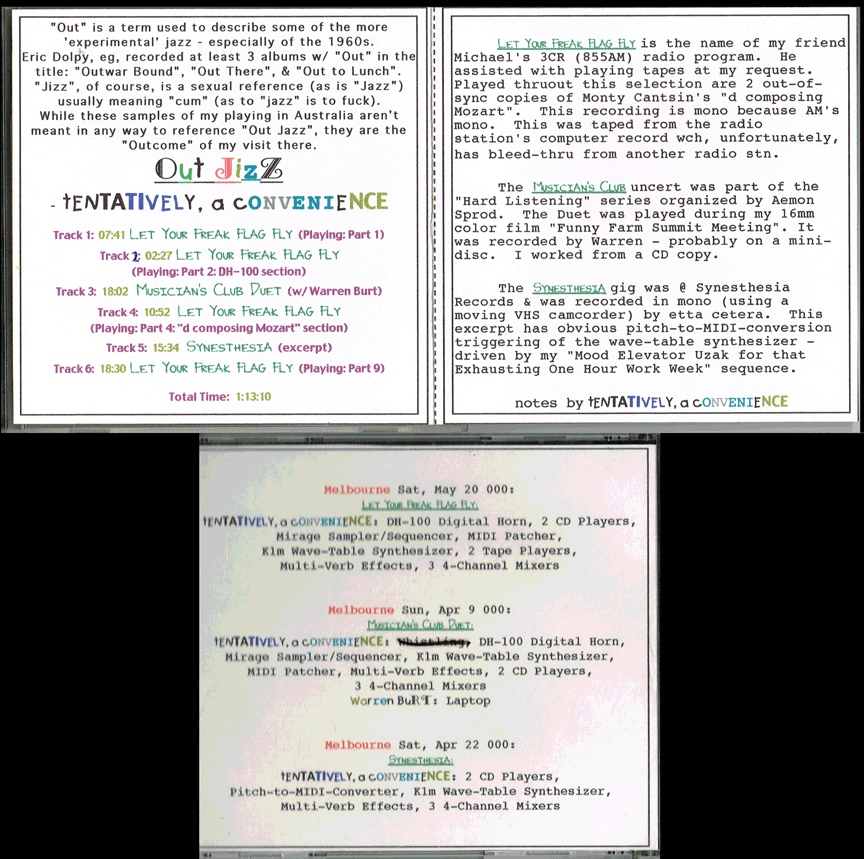
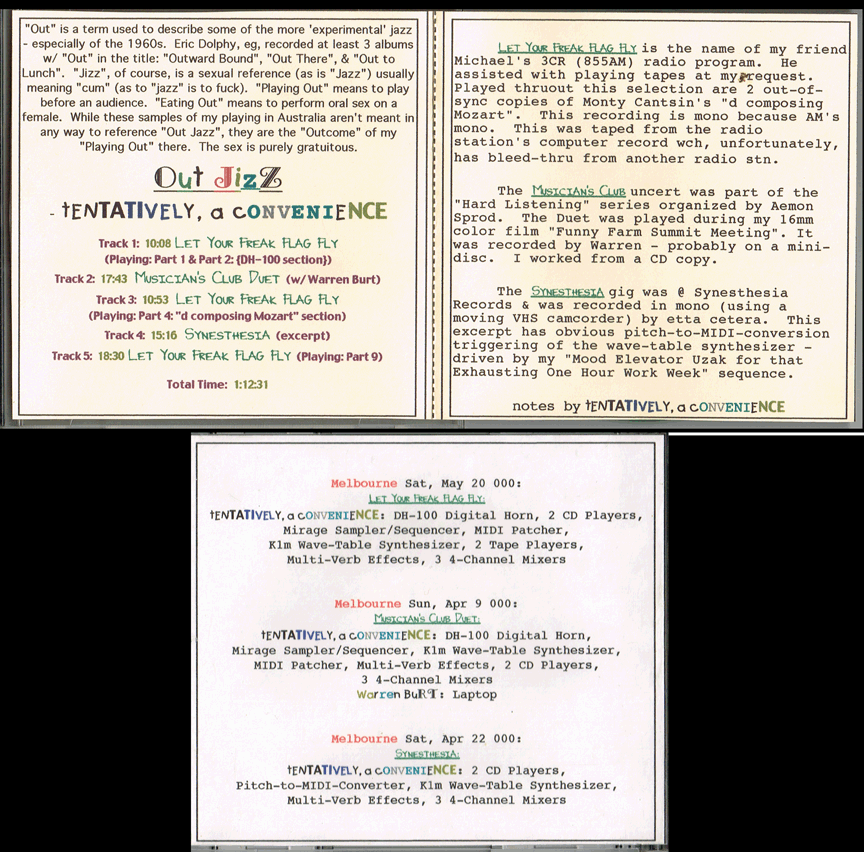
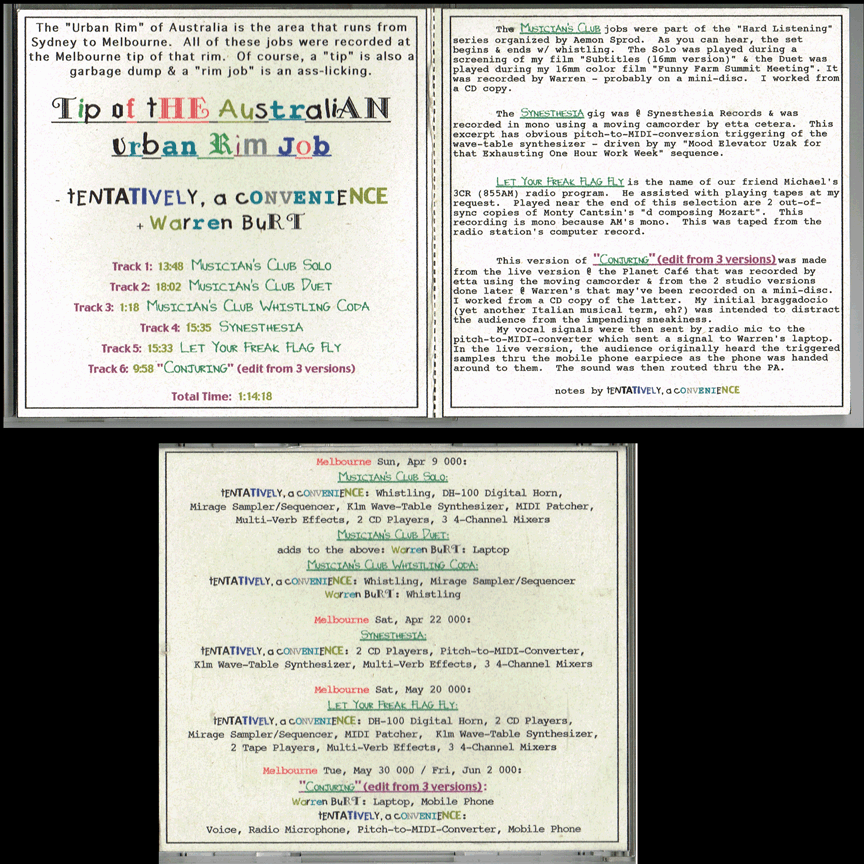
2000.06.08 A Night of Low Classical usic - Rhino Room, Adelaide, Australia
"301. A Night of Low Classical Usic
- Rhino Room, Adelaide, Australia
- Thursday, June 8, 2000
- Karen Eliot organized this as somewhat of a continuation of the Neoist activities in Adelaide from 2 months before (entries 281 to 286). Apparently, our previous time spent there had aroused more interest in Neoism than our original anticipated arrival had so there were a few new participants this time. A different Karen Eliot kicked off the evening with a prepared guitar drone improvisation. This was followed by yet another Monty Cantsin playing guitar while a friend of his sat at an on-stage computer playing solititaire - apparently to fake out the audience into thinking that he was playing some of the music on it. It was eventually used for such purposes. Monty performed a "classic rocker" using neoist buzz words. An attempt was made to get the audience to renounce Neoism - to no avail since most of them had no idea what he was talking about. He capped off his set by shooting at the audience with a cap pistol & then pretending to cap himself.
etta (see most of the entries from 212 on - mentioning etta cetera & Rita Rodentia) screened "Hairfarmer" & I screened "Diszey Spots", "Department of Failures", "Background Movie #2", & "Air Drops". This was followed by my playing electronics. I ended my set by playing the soundtrack to the slide show version of "Shuffle Mode" - without the visuals. This begins with:
"Into your hopeless un- life. You can find the elements narrowing to nothing - realizing experience is shuffling thru the dreary not- so- free limits of no escape from dumb fate. The very order of nothing's meaning, what you think, is like your death. Usual things, that you thought you knew, reprogram around discombobulate being when you try to make sense."
& ends with:
"You 'know' your life is not hopeless. To experience the free- dom, reprogram the order of things. Try shuffling around the elements of your being. Escape from death- like dreary limits - realizing nothing's fate. Make what you thought is narrowing you to nothing into new, very un- usual meaning. Find sense when you discombobulate so that you can think thru."
The reading was mixed with various other driving sounds to try to get the audience's attention. As far as I could tell, no-one was listening. When I ended there was no audible reaction from them. Conversation continued as before. No-one applauded, no-one booed. Nothing. Finally etta loudly acknowledged my ending & the audience joined in. Somethingland finished off the night with a guitar noise improv with ranting behind a screen onto which video was projected. I got paid less than the soundman, none of the other 'performers' were paid at all. Fortunately, the next night's screening organized by Dick Dale was more enthusiastically received. Bye bye Adelaide!
- a movie of the entire festival can be found on the Internet Archive here: https://archive.org/details/1stNonExistentInternationalNeoistApartmentFestivalInTheYear000" - Mere Outline 2000
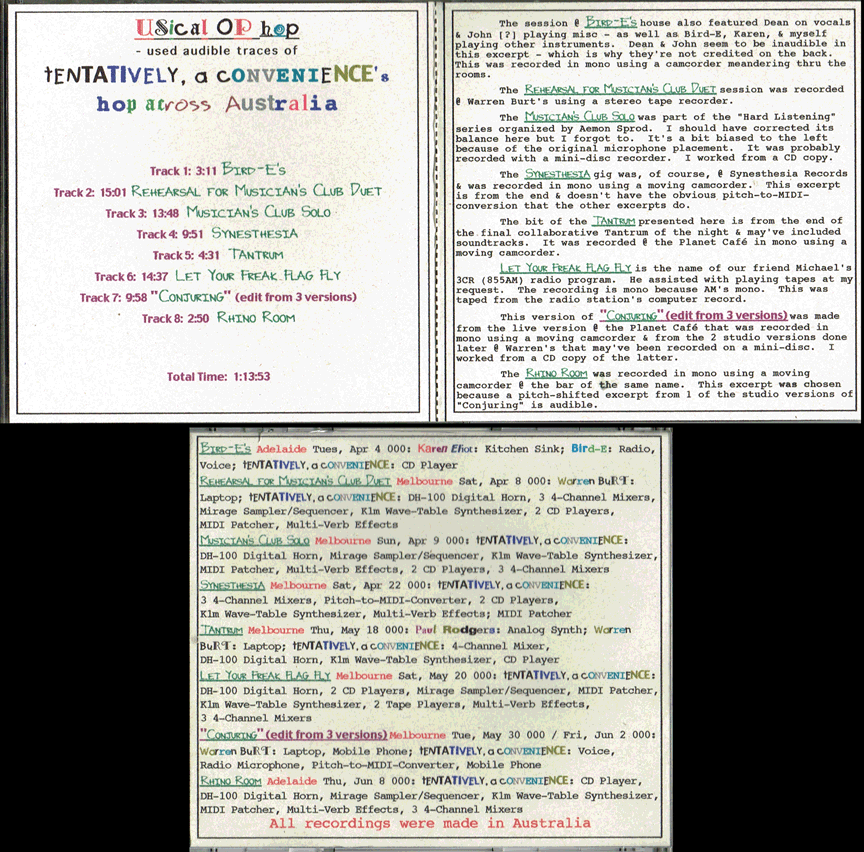
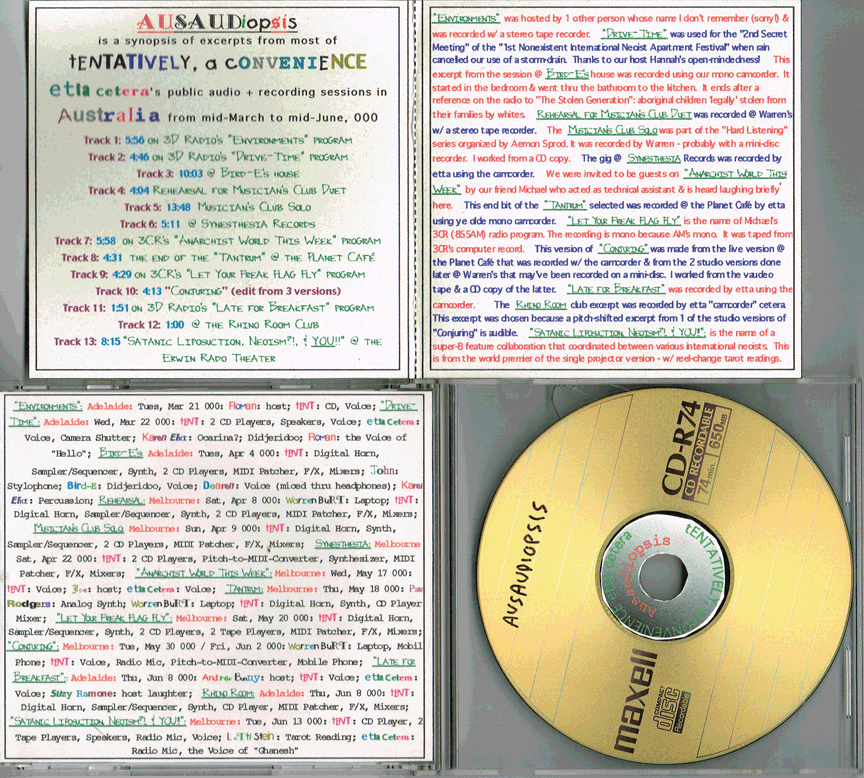
& that was basically THAT.. until my one homage to the period 9 years later. In 2001 I started using a new sampler, once again given to me by Dave Guercio, that could be programmed to have a sample for every key on my keyboard controller. The Mirage sampler/sequencer was broken, the K1ms gradually broke, the technical approach enabled by the new sampler allowed me to be very satisfied with concentrating on this one device as a main instrument (although I've never stopped using other instruments) & has resulted in a slew of sampler pieces since then. I made a set of 61 samples taken from the sequences that I've used a fair amount but, in the long run, it's too far from the Triple-S way of doing things to be much of a continuation anymore.
2009.03.28 "Triple-S Variety Show" reenactment - Monk's Gallery, Pittsburgh, us@
"366. "Triple-S Variety Show" reenactment
- Johan Nystrom's "why are music series", Monk's, Pittsburgh, us@
- Saturday, March 28, 2009
- On January 12, 1995, I had given my 1st performance in Pittsburgh - at the invitation of Orgone Cinema (see entry 195). This had been a "Triple-S Variety Show" concrete mixing event in wch I played 3 synthesizers, one sampler, & one sequencer live at the same time that I mixed together VHS tapes of my movies (mostly ones made for this purpose) while they were being projected. Sometimes the soundtracks of these were also mixed into the overall sound. This gig was a bit overambitious in the sense that I didn't have enuf time to devote myself to either the visuals or the sound individually as much as I'd've like. As such, the live mixing of the visuals, in particular, weren't as strong as I wanted them to be. All of this was originally mixed to VHS tape. In early 2009, I edited this 2 hr VHS document down to a 26 minute DVD-R & decided to 'reenact' the original presentation using samples taken from the materials developed for these "Triple-S Variety Shows" (of wch there were others). I presented it in this context partially so that people who hadn't lived in Pittsburgh in 1995 or who hadn't known me then cd experience that original performance (albeit compacted). I played sampler, sampling mixer, & wave-table synthesizer - structuring my playing largely around traying to make certain types of changes in rough sync w/ edit changes in the vaudeo & allowing specific parts of the prerecorded soundtrack to peep thru from time-to-time.
Following me on the bill was a duet set w/ David Bernabo playing accordian & Mike Tamburo playing a harp-like instrument of his invention called "Crowned Eternal" (or "Crown Eternal"?); then Michael Johnsen played a solo set on his home-made electronics; the evening ended w/ "A Collaboration": 3 guitarists: Mike Tamburo, Josh Beyer, & Tusk Lord).
- on my onesownthoughts YouTube channel here: https://youtu.be/31Idq235Jco" - Mere Outline 2009
It's difficult to make an absolutely clear-cut distinction between the Triple-S Variety Shows & many of the other recording sessions & Uncerts that happened around the same time & after. Nonetheless, I've come as close as I can here. If I were to refer to the closest thing to an archetypal Triple-S it would probably be the Orgone Cinema presentation that I called "A Triple "S" Variety Show straight from the bowels of the Turquoise, Beige, & Flesh Room at the Funny Farm" way back on January 12, 1995. What's amazing to me in retrospect is that I presented these things in Durham, Toronto, Pittsburgh, Vàc, Budapest, Windsor, BalTimOre, Melbourne, & Adelaide - in 4 countries - on the radio & in a speak-easy, galleries, clubs, a theater, concert halls, & a record store - & played with some truly great musicians - & STILL managed to stay completely obscure.
idioideo at verizon dot net
to the tENTATIVELY, a cONVENIENCE Anti-Neoism page
to the tENTATIVELY, a cONVENIENCE Audiography page
to the tENTATIVELY, a cONVENIENCE Bibliography page
to my "Blaster" Al Ackerman index
to the tENTATIVELY, a cONVENIENCE Books page
to the tENTATIVELY, a cONVENIENCE BYOC page
to the tENTATIVELY, a cONVENIENCE Censored or Rejected page
to the tENTATIVELY, a cONVENIENCE Collaborations page
to the tENTATIVELY, a cONVENIENCE (d) compositions page
to Amir-ul Kafirs' Facebook page
to the "FLICKER" home-page for the alternative cinematic experience
to tENTATIVELY, a cONVENIENCE's GoodReads profile
to the tENTATIVELY, a cONVENIENCE Haircuts page
to the tENTATIVELY, a cONVENIENCE Home Tapers page
to the tENTATIVELY, a cONVENIENCE index page
to the tENTATIVELY, a cONVENIENCE Instagram Poetry page
to a listing of tENTATIVELY, a cONVENIENCE's manifestations on the Internet Archive
to the tENTATIVELY, a cONVENIENCE as Interviewee index
to the tENTATIVELY, a cONVENIENCE as Interviewer index
to tENTATIVELY, a cONVENIENCE'S Linked-In profile
to the mm index
to see an underdeveloped site re the N.A.A.M.C.P. (National Association for the Advancement of Multi-Colored Peoples)
to tENTATIVELY, a cONVENIENCE's Neoism page
to the DEFINITIVE Neoism/Anti-Neoism website
to the Philosopher's Union website
to the tENTATIVELY, a cONVENIENCE movie-making "Press: Criticism, Interviews, Reviews" home-page
to tENTATIVELY, a cONVENIENCE's Score Movies
to SMILEs
to find out more about why the S.P.C.S.M.E.F. (Society for the Prevention of Cruelty to Sea Monkeys by Experimental Filmmakers) is so important
to the "tENTATIVELY, a cONVENIENCE - Sprocket Scientist" home-page
to Psychic Weed's Twitter page
to tENTATIVELY, a cONVENIENCE's Vimeo index
to Vine movies relevant to tENTATIVELY, a cONVENIENCE made by Ryan Broughman
to tENTATIVELY, a cONVENIENCE's presence in the Visual Music Village
for info on tENTATIVELY, a cONVENIENCE's tape/CD publishing label: WIdémoUTH
to a very small selection of tENTATIVELY, a cONVENIENCE's Writing